Macroeconomics and Long Term Investment in a Nation
VerifiedAdded on 2021/05/31
|41
|10685
|409
AI Summary
Performance scores of MACROECONOMICS MACROECONOMICS 19 2016 19 Running Head: MACROECONOMICS Macroeconomics Name of the Student Name of the University Course ID Executuve Summary The paper examines how movement of different mcroeconomic variables influences the decision of long term investment of a company. Introduction 4 Analysis and Discussion 6 Overview of general business environment 6 Economic growth and analysis of business cycle 8 Unemployment 11 Average wage rate 14 Inflation 17 Real interest rate 19 Domestic Credit
Contribute Materials
Your contribution can guide someone’s learning journey. Share your
documents today.
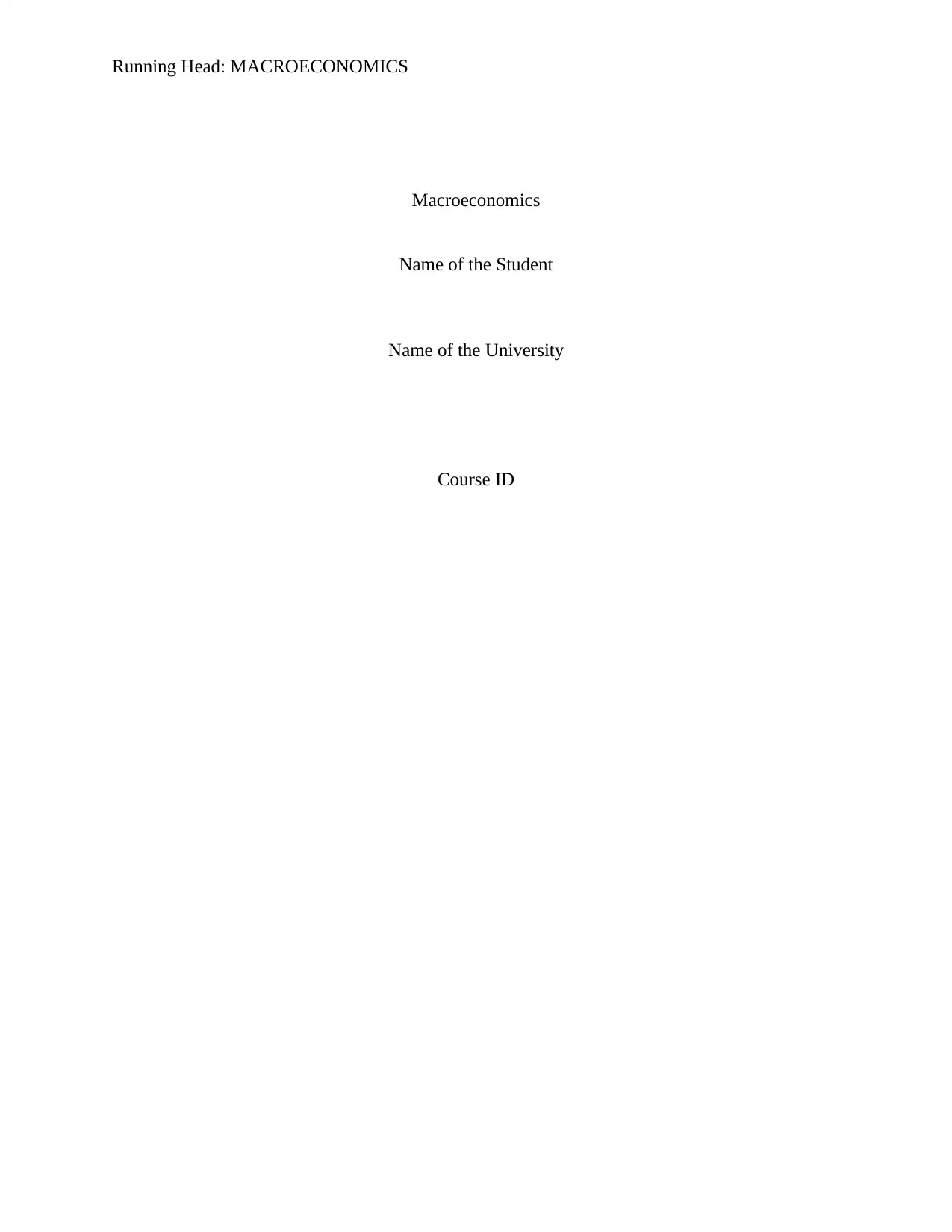
Running Head: MACROECONOMICS
Macroeconomics
Name of the Student
Name of the University
Course ID
Macroeconomics
Name of the Student
Name of the University
Course ID
Secure Best Marks with AI Grader
Need help grading? Try our AI Grader for instant feedback on your assignments.
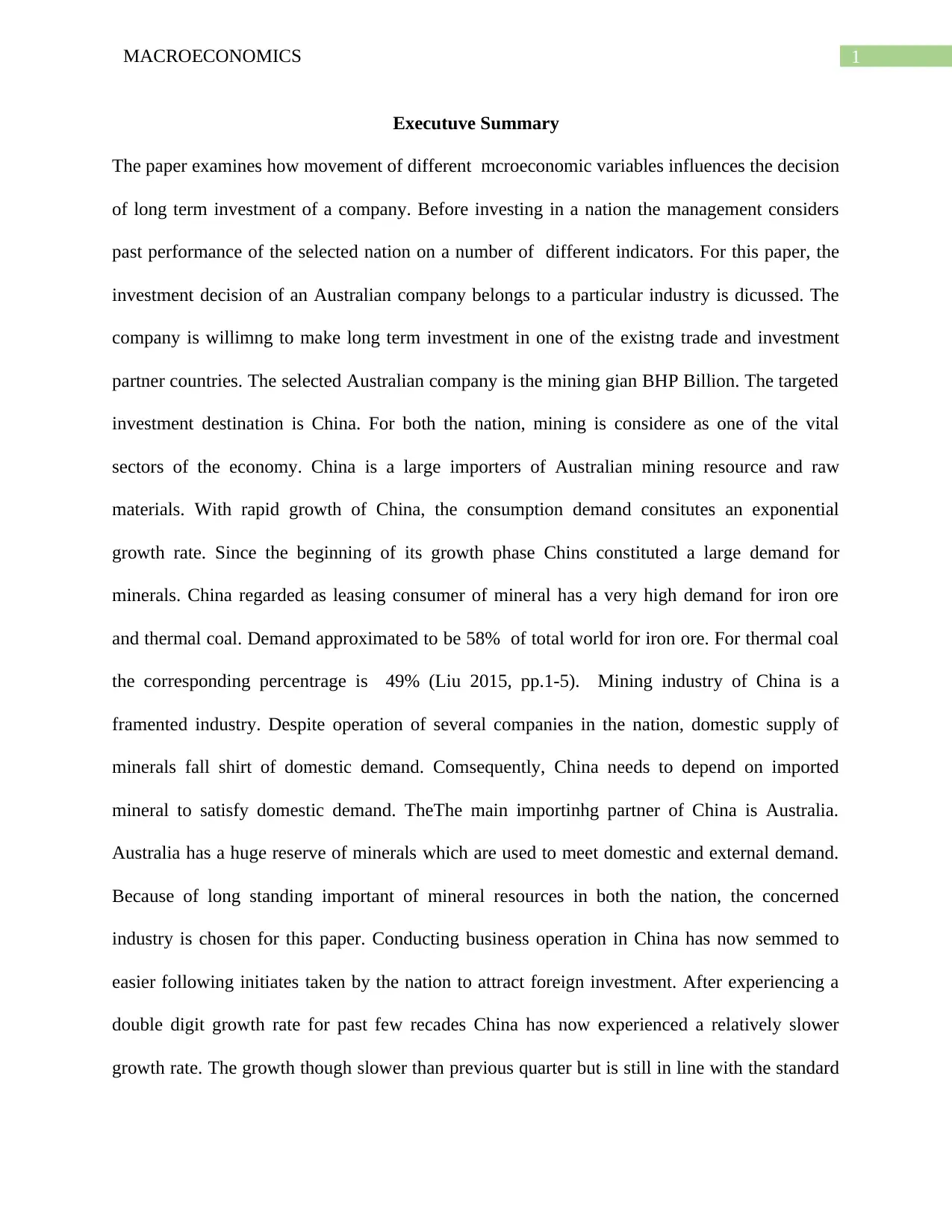
1MACROECONOMICS
Executuve Summary
The paper examines how movement of different mcroeconomic variables influences the decision
of long term investment of a company. Before investing in a nation the management considers
past performance of the selected nation on a number of different indicators. For this paper, the
investment decision of an Australian company belongs to a particular industry is dicussed. The
company is willimng to make long term investment in one of the existng trade and investment
partner countries. The selected Australian company is the mining gian BHP Billion. The targeted
investment destination is China. For both the nation, mining is considere as one of the vital
sectors of the economy. China is a large importers of Australian mining resource and raw
materials. With rapid growth of China, the consumption demand consitutes an exponential
growth rate. Since the beginning of its growth phase Chins constituted a large demand for
minerals. China regarded as leasing consumer of mineral has a very high demand for iron ore
and thermal coal. Demand approximated to be 58% of total world for iron ore. For thermal coal
the corresponding percentrage is 49% (Liu 2015, pp.1-5). Mining industry of China is a
framented industry. Despite operation of several companies in the nation, domestic supply of
minerals fall shirt of domestic demand. Comsequently, China needs to depend on imported
mineral to satisfy domestic demand. TheThe main importinhg partner of China is Australia.
Australia has a huge reserve of minerals which are used to meet domestic and external demand.
Because of long standing important of mineral resources in both the nation, the concerned
industry is chosen for this paper. Conducting business operation in China has now semmed to
easier following initiates taken by the nation to attract foreign investment. After experiencing a
double digit growth rate for past few recades China has now experienced a relatively slower
growth rate. The growth though slower than previous quarter but is still in line with the standard
Executuve Summary
The paper examines how movement of different mcroeconomic variables influences the decision
of long term investment of a company. Before investing in a nation the management considers
past performance of the selected nation on a number of different indicators. For this paper, the
investment decision of an Australian company belongs to a particular industry is dicussed. The
company is willimng to make long term investment in one of the existng trade and investment
partner countries. The selected Australian company is the mining gian BHP Billion. The targeted
investment destination is China. For both the nation, mining is considere as one of the vital
sectors of the economy. China is a large importers of Australian mining resource and raw
materials. With rapid growth of China, the consumption demand consitutes an exponential
growth rate. Since the beginning of its growth phase Chins constituted a large demand for
minerals. China regarded as leasing consumer of mineral has a very high demand for iron ore
and thermal coal. Demand approximated to be 58% of total world for iron ore. For thermal coal
the corresponding percentrage is 49% (Liu 2015, pp.1-5). Mining industry of China is a
framented industry. Despite operation of several companies in the nation, domestic supply of
minerals fall shirt of domestic demand. Comsequently, China needs to depend on imported
mineral to satisfy domestic demand. TheThe main importinhg partner of China is Australia.
Australia has a huge reserve of minerals which are used to meet domestic and external demand.
Because of long standing important of mineral resources in both the nation, the concerned
industry is chosen for this paper. Conducting business operation in China has now semmed to
easier following initiates taken by the nation to attract foreign investment. After experiencing a
double digit growth rate for past few recades China has now experienced a relatively slower
growth rate. The growth though slower than previous quarter but is still in line with the standard
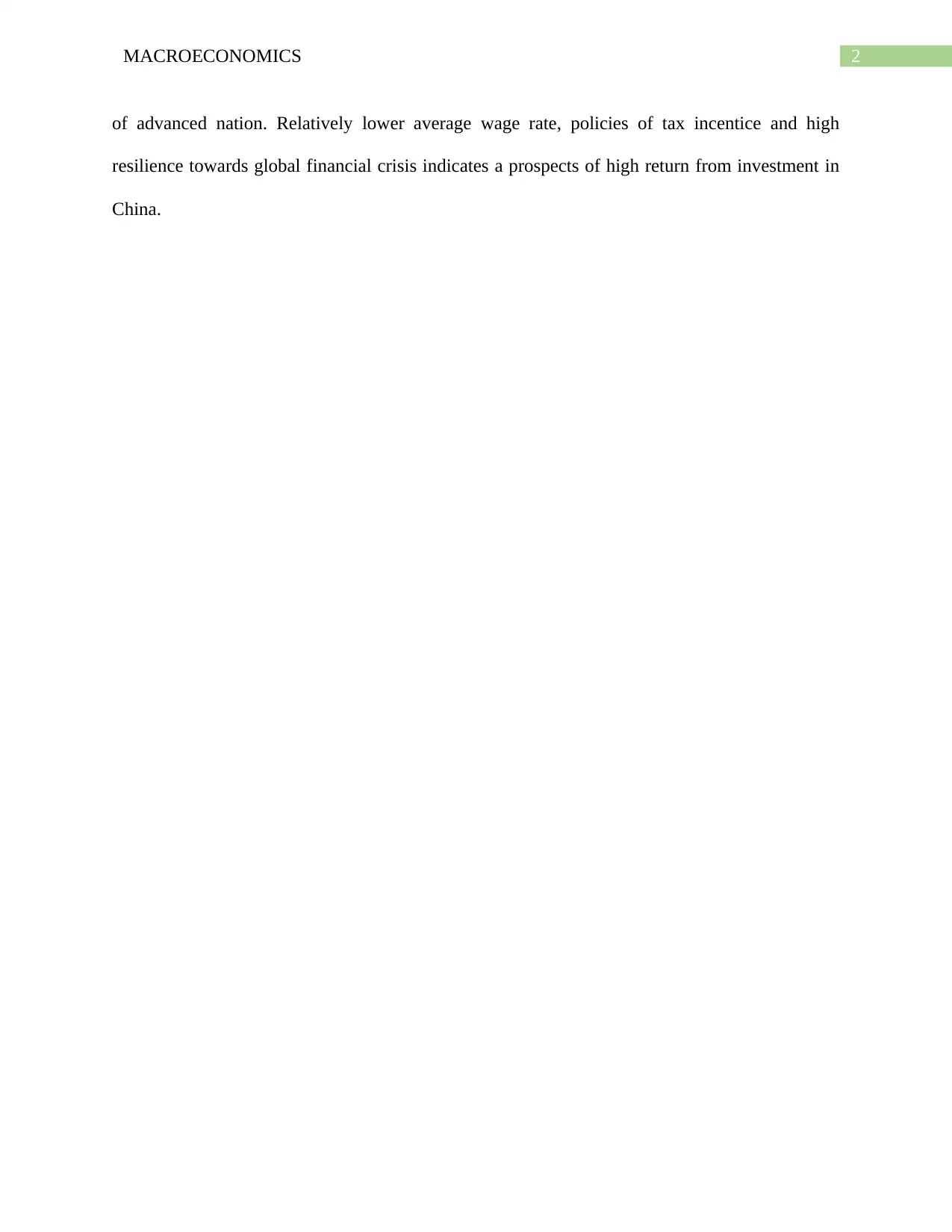
2MACROECONOMICS
of advanced nation. Relatively lower average wage rate, policies of tax incentice and high
resilience towards global financial crisis indicates a prospects of high return from investment in
China.
of advanced nation. Relatively lower average wage rate, policies of tax incentice and high
resilience towards global financial crisis indicates a prospects of high return from investment in
China.
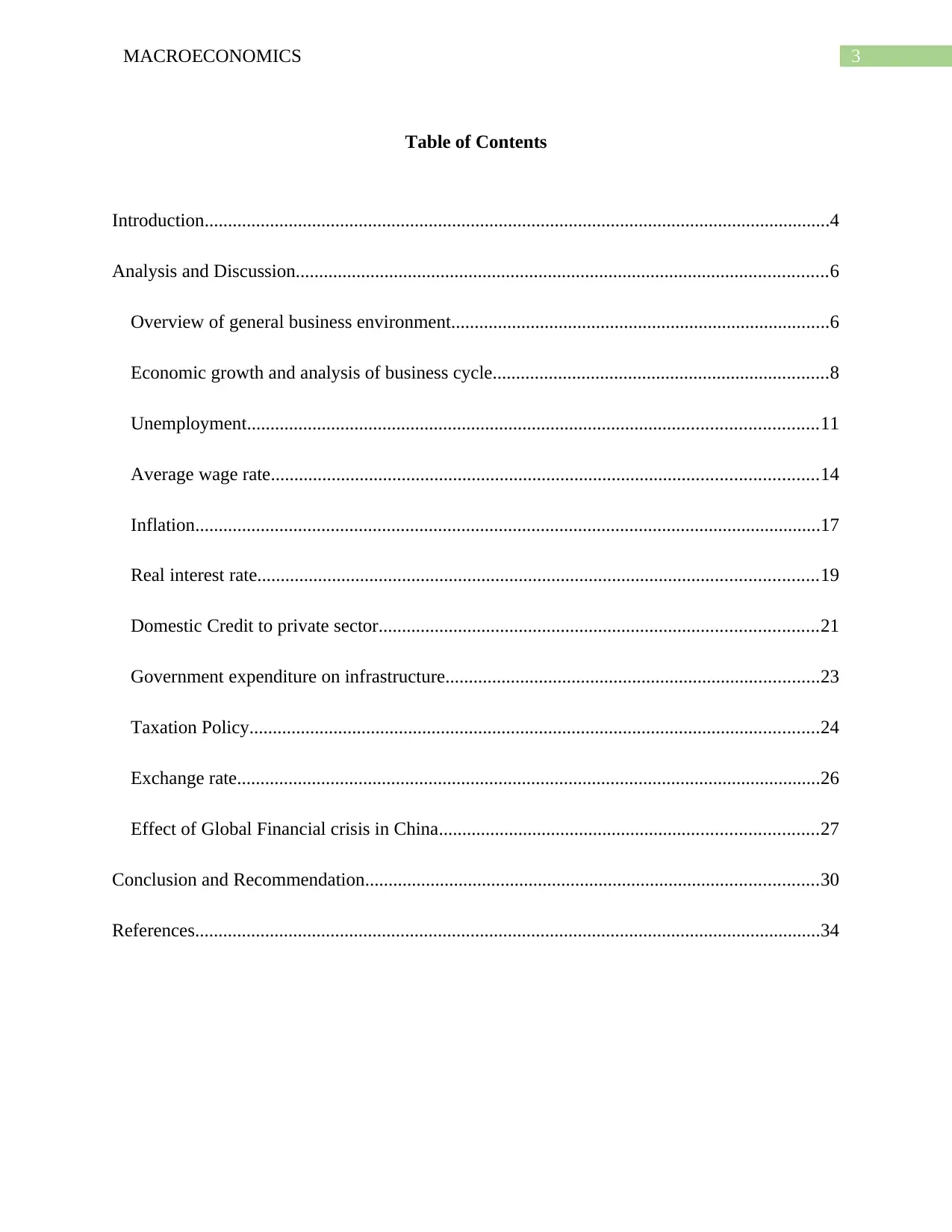
3MACROECONOMICS
Table of Contents
Introduction......................................................................................................................................4
Analysis and Discussion..................................................................................................................6
Overview of general business environment.................................................................................6
Economic growth and analysis of business cycle........................................................................8
Unemployment..........................................................................................................................11
Average wage rate.....................................................................................................................14
Inflation......................................................................................................................................17
Real interest rate........................................................................................................................19
Domestic Credit to private sector..............................................................................................21
Government expenditure on infrastructure................................................................................23
Taxation Policy..........................................................................................................................24
Exchange rate.............................................................................................................................26
Effect of Global Financial crisis in China.................................................................................27
Conclusion and Recommendation.................................................................................................30
References......................................................................................................................................34
Table of Contents
Introduction......................................................................................................................................4
Analysis and Discussion..................................................................................................................6
Overview of general business environment.................................................................................6
Economic growth and analysis of business cycle........................................................................8
Unemployment..........................................................................................................................11
Average wage rate.....................................................................................................................14
Inflation......................................................................................................................................17
Real interest rate........................................................................................................................19
Domestic Credit to private sector..............................................................................................21
Government expenditure on infrastructure................................................................................23
Taxation Policy..........................................................................................................................24
Exchange rate.............................................................................................................................26
Effect of Global Financial crisis in China.................................................................................27
Conclusion and Recommendation.................................................................................................30
References......................................................................................................................................34
Secure Best Marks with AI Grader
Need help grading? Try our AI Grader for instant feedback on your assignments.
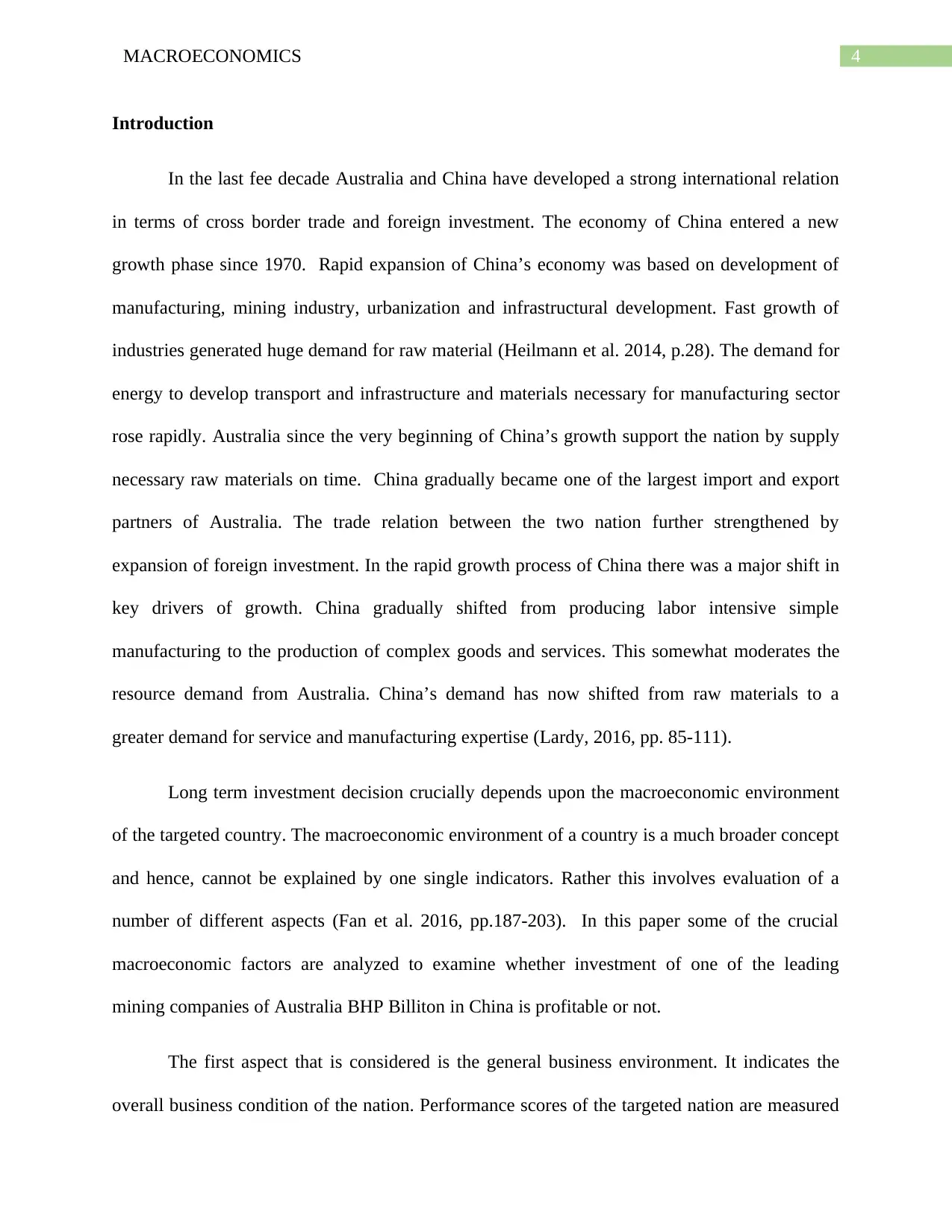
4MACROECONOMICS
Introduction
In the last fee decade Australia and China have developed a strong international relation
in terms of cross border trade and foreign investment. The economy of China entered a new
growth phase since 1970. Rapid expansion of China’s economy was based on development of
manufacturing, mining industry, urbanization and infrastructural development. Fast growth of
industries generated huge demand for raw material (Heilmann et al. 2014, p.28). The demand for
energy to develop transport and infrastructure and materials necessary for manufacturing sector
rose rapidly. Australia since the very beginning of China’s growth support the nation by supply
necessary raw materials on time. China gradually became one of the largest import and export
partners of Australia. The trade relation between the two nation further strengthened by
expansion of foreign investment. In the rapid growth process of China there was a major shift in
key drivers of growth. China gradually shifted from producing labor intensive simple
manufacturing to the production of complex goods and services. This somewhat moderates the
resource demand from Australia. China’s demand has now shifted from raw materials to a
greater demand for service and manufacturing expertise (Lardy, 2016, pp. 85-111).
Long term investment decision crucially depends upon the macroeconomic environment
of the targeted country. The macroeconomic environment of a country is a much broader concept
and hence, cannot be explained by one single indicators. Rather this involves evaluation of a
number of different aspects (Fan et al. 2016, pp.187-203). In this paper some of the crucial
macroeconomic factors are analyzed to examine whether investment of one of the leading
mining companies of Australia BHP Billiton in China is profitable or not.
The first aspect that is considered is the general business environment. It indicates the
overall business condition of the nation. Performance scores of the targeted nation are measured
Introduction
In the last fee decade Australia and China have developed a strong international relation
in terms of cross border trade and foreign investment. The economy of China entered a new
growth phase since 1970. Rapid expansion of China’s economy was based on development of
manufacturing, mining industry, urbanization and infrastructural development. Fast growth of
industries generated huge demand for raw material (Heilmann et al. 2014, p.28). The demand for
energy to develop transport and infrastructure and materials necessary for manufacturing sector
rose rapidly. Australia since the very beginning of China’s growth support the nation by supply
necessary raw materials on time. China gradually became one of the largest import and export
partners of Australia. The trade relation between the two nation further strengthened by
expansion of foreign investment. In the rapid growth process of China there was a major shift in
key drivers of growth. China gradually shifted from producing labor intensive simple
manufacturing to the production of complex goods and services. This somewhat moderates the
resource demand from Australia. China’s demand has now shifted from raw materials to a
greater demand for service and manufacturing expertise (Lardy, 2016, pp. 85-111).
Long term investment decision crucially depends upon the macroeconomic environment
of the targeted country. The macroeconomic environment of a country is a much broader concept
and hence, cannot be explained by one single indicators. Rather this involves evaluation of a
number of different aspects (Fan et al. 2016, pp.187-203). In this paper some of the crucial
macroeconomic factors are analyzed to examine whether investment of one of the leading
mining companies of Australia BHP Billiton in China is profitable or not.
The first aspect that is considered is the general business environment. It indicates the
overall business condition of the nation. Performance scores of the targeted nation are measured
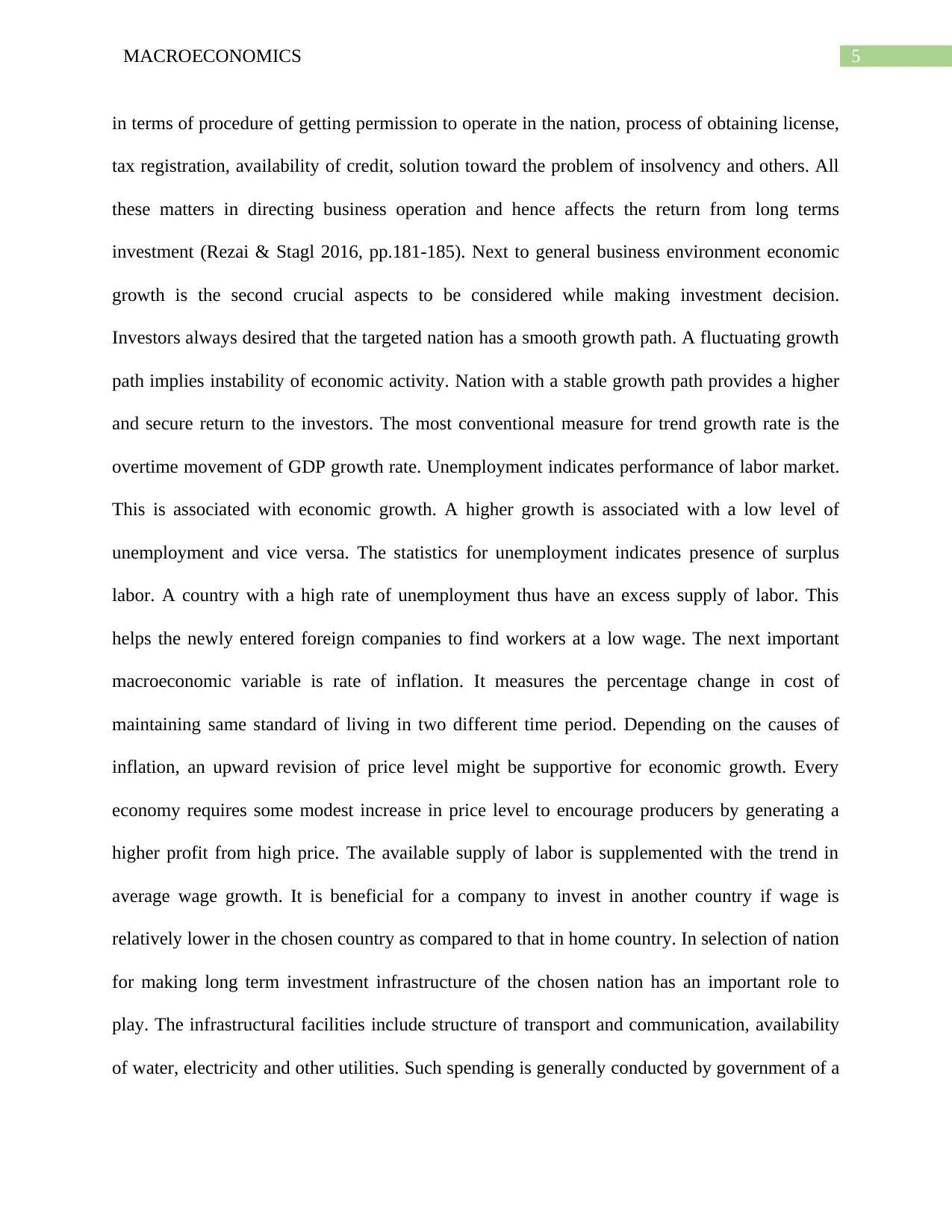
5MACROECONOMICS
in terms of procedure of getting permission to operate in the nation, process of obtaining license,
tax registration, availability of credit, solution toward the problem of insolvency and others. All
these matters in directing business operation and hence affects the return from long terms
investment (Rezai & Stagl 2016, pp.181-185). Next to general business environment economic
growth is the second crucial aspects to be considered while making investment decision.
Investors always desired that the targeted nation has a smooth growth path. A fluctuating growth
path implies instability of economic activity. Nation with a stable growth path provides a higher
and secure return to the investors. The most conventional measure for trend growth rate is the
overtime movement of GDP growth rate. Unemployment indicates performance of labor market.
This is associated with economic growth. A higher growth is associated with a low level of
unemployment and vice versa. The statistics for unemployment indicates presence of surplus
labor. A country with a high rate of unemployment thus have an excess supply of labor. This
helps the newly entered foreign companies to find workers at a low wage. The next important
macroeconomic variable is rate of inflation. It measures the percentage change in cost of
maintaining same standard of living in two different time period. Depending on the causes of
inflation, an upward revision of price level might be supportive for economic growth. Every
economy requires some modest increase in price level to encourage producers by generating a
higher profit from high price. The available supply of labor is supplemented with the trend in
average wage growth. It is beneficial for a company to invest in another country if wage is
relatively lower in the chosen country as compared to that in home country. In selection of nation
for making long term investment infrastructure of the chosen nation has an important role to
play. The infrastructural facilities include structure of transport and communication, availability
of water, electricity and other utilities. Such spending is generally conducted by government of a
in terms of procedure of getting permission to operate in the nation, process of obtaining license,
tax registration, availability of credit, solution toward the problem of insolvency and others. All
these matters in directing business operation and hence affects the return from long terms
investment (Rezai & Stagl 2016, pp.181-185). Next to general business environment economic
growth is the second crucial aspects to be considered while making investment decision.
Investors always desired that the targeted nation has a smooth growth path. A fluctuating growth
path implies instability of economic activity. Nation with a stable growth path provides a higher
and secure return to the investors. The most conventional measure for trend growth rate is the
overtime movement of GDP growth rate. Unemployment indicates performance of labor market.
This is associated with economic growth. A higher growth is associated with a low level of
unemployment and vice versa. The statistics for unemployment indicates presence of surplus
labor. A country with a high rate of unemployment thus have an excess supply of labor. This
helps the newly entered foreign companies to find workers at a low wage. The next important
macroeconomic variable is rate of inflation. It measures the percentage change in cost of
maintaining same standard of living in two different time period. Depending on the causes of
inflation, an upward revision of price level might be supportive for economic growth. Every
economy requires some modest increase in price level to encourage producers by generating a
higher profit from high price. The available supply of labor is supplemented with the trend in
average wage growth. It is beneficial for a company to invest in another country if wage is
relatively lower in the chosen country as compared to that in home country. In selection of nation
for making long term investment infrastructure of the chosen nation has an important role to
play. The infrastructural facilities include structure of transport and communication, availability
of water, electricity and other utilities. Such spending is generally conducted by government of a
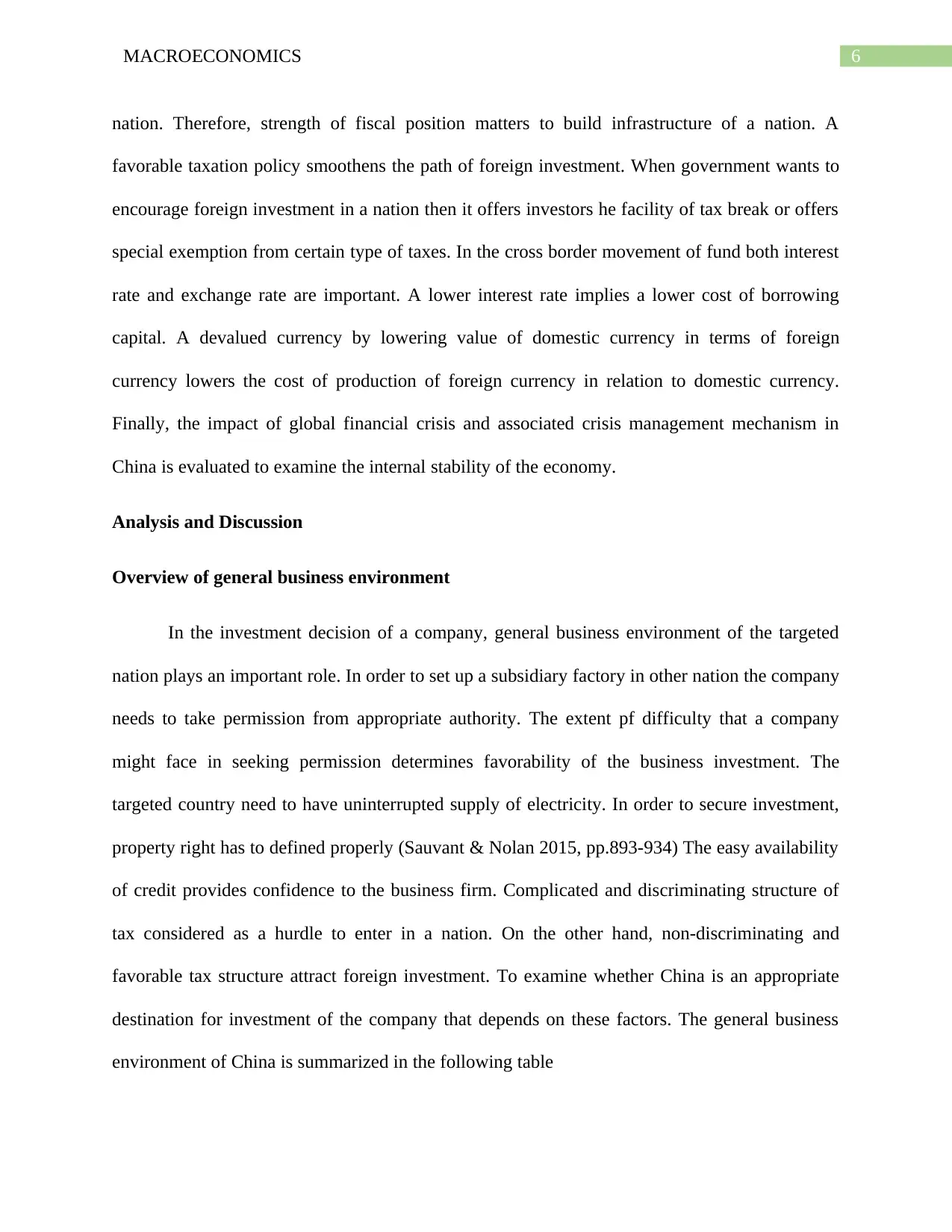
6MACROECONOMICS
nation. Therefore, strength of fiscal position matters to build infrastructure of a nation. A
favorable taxation policy smoothens the path of foreign investment. When government wants to
encourage foreign investment in a nation then it offers investors he facility of tax break or offers
special exemption from certain type of taxes. In the cross border movement of fund both interest
rate and exchange rate are important. A lower interest rate implies a lower cost of borrowing
capital. A devalued currency by lowering value of domestic currency in terms of foreign
currency lowers the cost of production of foreign currency in relation to domestic currency.
Finally, the impact of global financial crisis and associated crisis management mechanism in
China is evaluated to examine the internal stability of the economy.
Analysis and Discussion
Overview of general business environment
In the investment decision of a company, general business environment of the targeted
nation plays an important role. In order to set up a subsidiary factory in other nation the company
needs to take permission from appropriate authority. The extent pf difficulty that a company
might face in seeking permission determines favorability of the business investment. The
targeted country need to have uninterrupted supply of electricity. In order to secure investment,
property right has to defined properly (Sauvant & Nolan 2015, pp.893-934) The easy availability
of credit provides confidence to the business firm. Complicated and discriminating structure of
tax considered as a hurdle to enter in a nation. On the other hand, non-discriminating and
favorable tax structure attract foreign investment. To examine whether China is an appropriate
destination for investment of the company that depends on these factors. The general business
environment of China is summarized in the following table
nation. Therefore, strength of fiscal position matters to build infrastructure of a nation. A
favorable taxation policy smoothens the path of foreign investment. When government wants to
encourage foreign investment in a nation then it offers investors he facility of tax break or offers
special exemption from certain type of taxes. In the cross border movement of fund both interest
rate and exchange rate are important. A lower interest rate implies a lower cost of borrowing
capital. A devalued currency by lowering value of domestic currency in terms of foreign
currency lowers the cost of production of foreign currency in relation to domestic currency.
Finally, the impact of global financial crisis and associated crisis management mechanism in
China is evaluated to examine the internal stability of the economy.
Analysis and Discussion
Overview of general business environment
In the investment decision of a company, general business environment of the targeted
nation plays an important role. In order to set up a subsidiary factory in other nation the company
needs to take permission from appropriate authority. The extent pf difficulty that a company
might face in seeking permission determines favorability of the business investment. The
targeted country need to have uninterrupted supply of electricity. In order to secure investment,
property right has to defined properly (Sauvant & Nolan 2015, pp.893-934) The easy availability
of credit provides confidence to the business firm. Complicated and discriminating structure of
tax considered as a hurdle to enter in a nation. On the other hand, non-discriminating and
favorable tax structure attract foreign investment. To examine whether China is an appropriate
destination for investment of the company that depends on these factors. The general business
environment of China is summarized in the following table
Paraphrase This Document
Need a fresh take? Get an instant paraphrase of this document with our AI Paraphraser
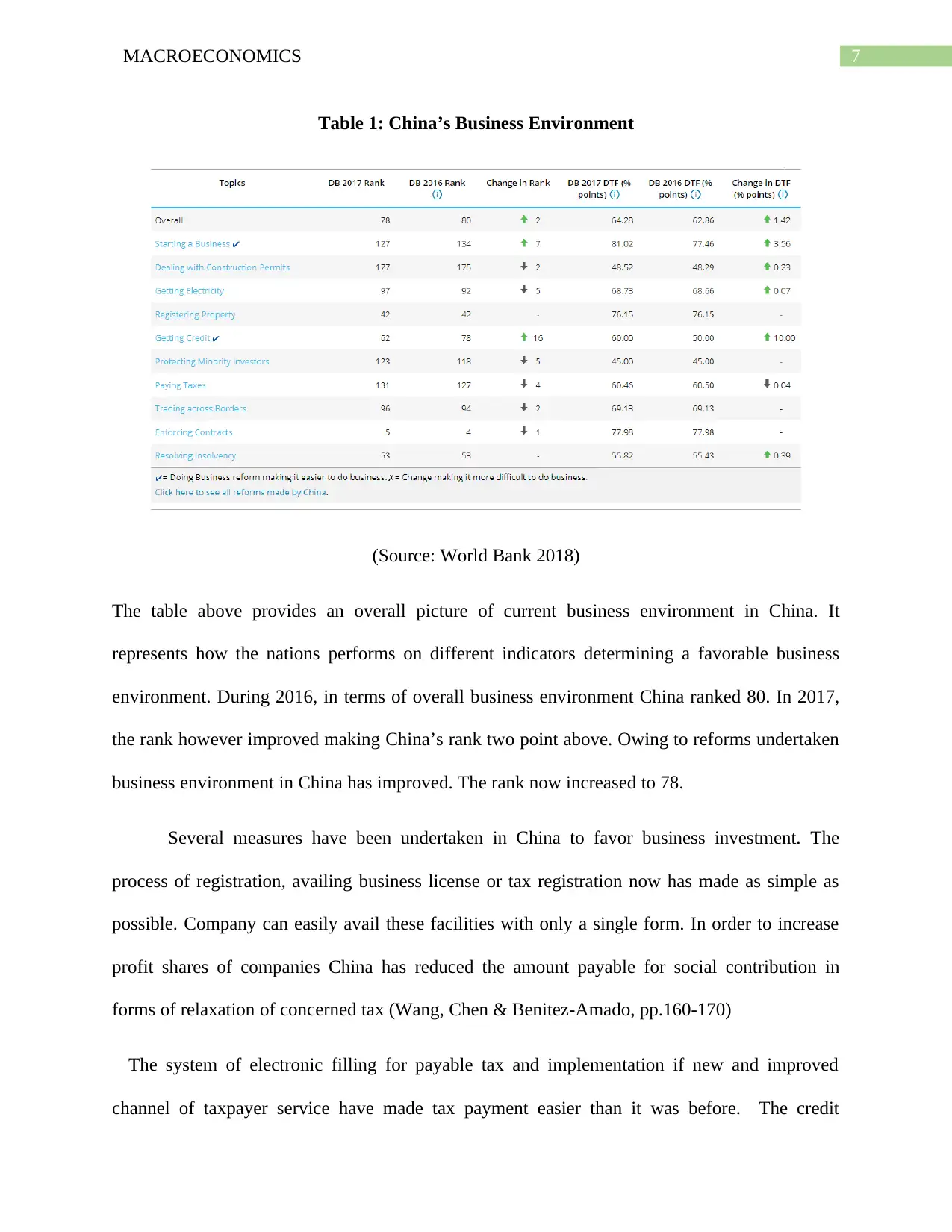
7MACROECONOMICS
Table 1: China’s Business Environment
(Source: World Bank 2018)
The table above provides an overall picture of current business environment in China. It
represents how the nations performs on different indicators determining a favorable business
environment. During 2016, in terms of overall business environment China ranked 80. In 2017,
the rank however improved making China’s rank two point above. Owing to reforms undertaken
business environment in China has improved. The rank now increased to 78.
Several measures have been undertaken in China to favor business investment. The
process of registration, availing business license or tax registration now has made as simple as
possible. Company can easily avail these facilities with only a single form. In order to increase
profit shares of companies China has reduced the amount payable for social contribution in
forms of relaxation of concerned tax (Wang, Chen & Benitez-Amado, pp.160-170)
The system of electronic filling for payable tax and implementation if new and improved
channel of taxpayer service have made tax payment easier than it was before. The credit
Table 1: China’s Business Environment
(Source: World Bank 2018)
The table above provides an overall picture of current business environment in China. It
represents how the nations performs on different indicators determining a favorable business
environment. During 2016, in terms of overall business environment China ranked 80. In 2017,
the rank however improved making China’s rank two point above. Owing to reforms undertaken
business environment in China has improved. The rank now increased to 78.
Several measures have been undertaken in China to favor business investment. The
process of registration, availing business license or tax registration now has made as simple as
possible. Company can easily avail these facilities with only a single form. In order to increase
profit shares of companies China has reduced the amount payable for social contribution in
forms of relaxation of concerned tax (Wang, Chen & Benitez-Amado, pp.160-170)
The system of electronic filling for payable tax and implementation if new and improved
channel of taxpayer service have made tax payment easier than it was before. The credit
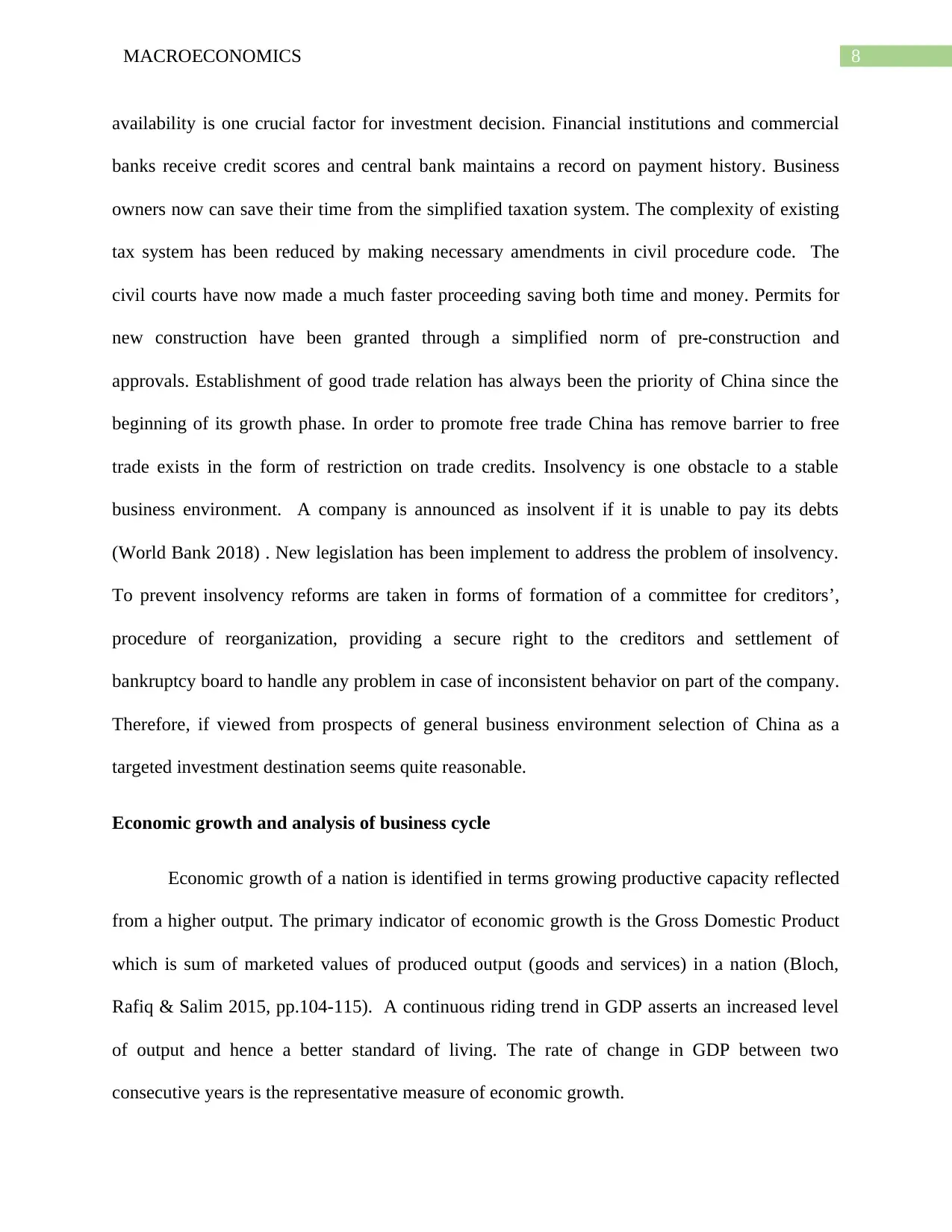
8MACROECONOMICS
availability is one crucial factor for investment decision. Financial institutions and commercial
banks receive credit scores and central bank maintains a record on payment history. Business
owners now can save their time from the simplified taxation system. The complexity of existing
tax system has been reduced by making necessary amendments in civil procedure code. The
civil courts have now made a much faster proceeding saving both time and money. Permits for
new construction have been granted through a simplified norm of pre-construction and
approvals. Establishment of good trade relation has always been the priority of China since the
beginning of its growth phase. In order to promote free trade China has remove barrier to free
trade exists in the form of restriction on trade credits. Insolvency is one obstacle to a stable
business environment. A company is announced as insolvent if it is unable to pay its debts
(World Bank 2018) . New legislation has been implement to address the problem of insolvency.
To prevent insolvency reforms are taken in forms of formation of a committee for creditors’,
procedure of reorganization, providing a secure right to the creditors and settlement of
bankruptcy board to handle any problem in case of inconsistent behavior on part of the company.
Therefore, if viewed from prospects of general business environment selection of China as a
targeted investment destination seems quite reasonable.
Economic growth and analysis of business cycle
Economic growth of a nation is identified in terms growing productive capacity reflected
from a higher output. The primary indicator of economic growth is the Gross Domestic Product
which is sum of marketed values of produced output (goods and services) in a nation (Bloch,
Rafiq & Salim 2015, pp.104-115). A continuous riding trend in GDP asserts an increased level
of output and hence a better standard of living. The rate of change in GDP between two
consecutive years is the representative measure of economic growth.
availability is one crucial factor for investment decision. Financial institutions and commercial
banks receive credit scores and central bank maintains a record on payment history. Business
owners now can save their time from the simplified taxation system. The complexity of existing
tax system has been reduced by making necessary amendments in civil procedure code. The
civil courts have now made a much faster proceeding saving both time and money. Permits for
new construction have been granted through a simplified norm of pre-construction and
approvals. Establishment of good trade relation has always been the priority of China since the
beginning of its growth phase. In order to promote free trade China has remove barrier to free
trade exists in the form of restriction on trade credits. Insolvency is one obstacle to a stable
business environment. A company is announced as insolvent if it is unable to pay its debts
(World Bank 2018) . New legislation has been implement to address the problem of insolvency.
To prevent insolvency reforms are taken in forms of formation of a committee for creditors’,
procedure of reorganization, providing a secure right to the creditors and settlement of
bankruptcy board to handle any problem in case of inconsistent behavior on part of the company.
Therefore, if viewed from prospects of general business environment selection of China as a
targeted investment destination seems quite reasonable.
Economic growth and analysis of business cycle
Economic growth of a nation is identified in terms growing productive capacity reflected
from a higher output. The primary indicator of economic growth is the Gross Domestic Product
which is sum of marketed values of produced output (goods and services) in a nation (Bloch,
Rafiq & Salim 2015, pp.104-115). A continuous riding trend in GDP asserts an increased level
of output and hence a better standard of living. The rate of change in GDP between two
consecutive years is the representative measure of economic growth.
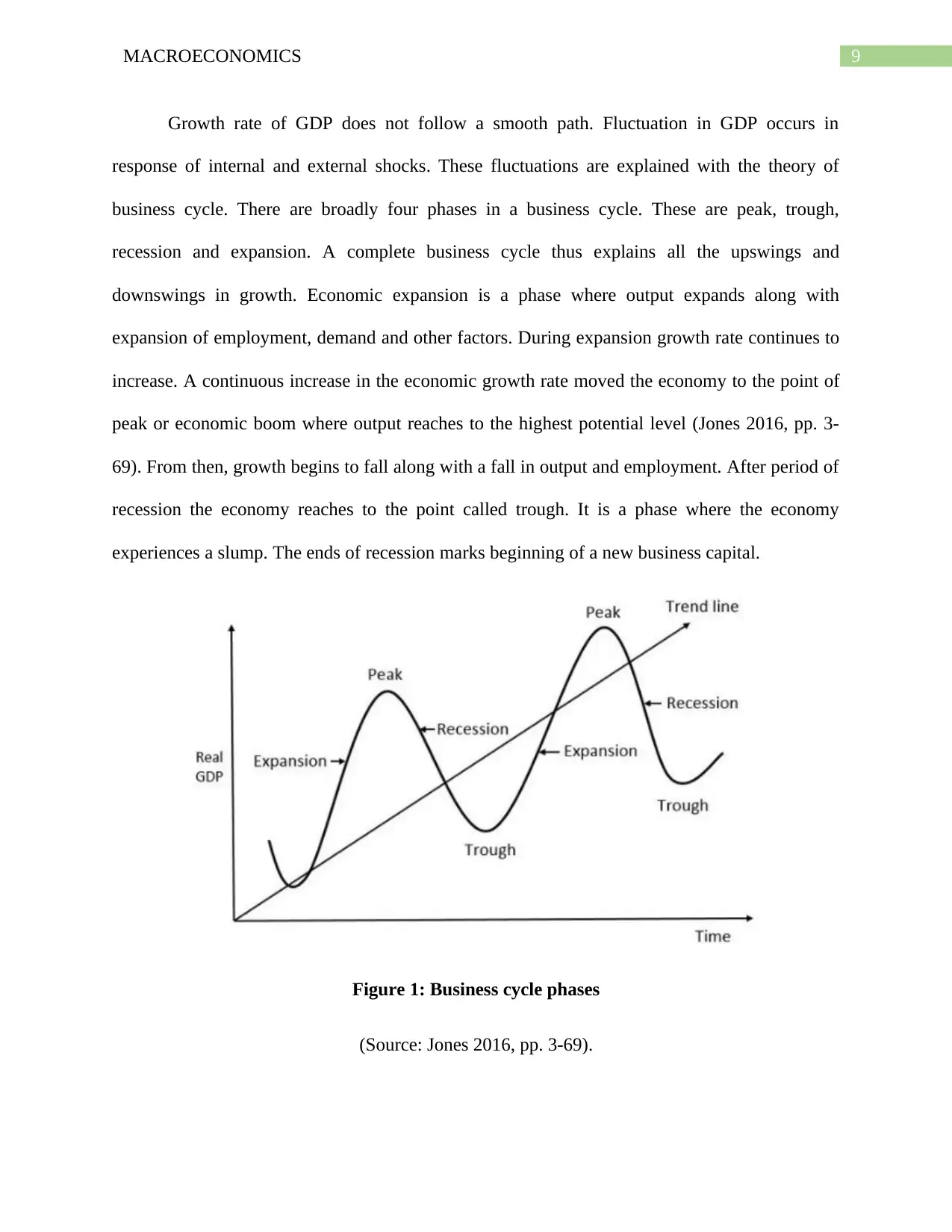
9MACROECONOMICS
Growth rate of GDP does not follow a smooth path. Fluctuation in GDP occurs in
response of internal and external shocks. These fluctuations are explained with the theory of
business cycle. There are broadly four phases in a business cycle. These are peak, trough,
recession and expansion. A complete business cycle thus explains all the upswings and
downswings in growth. Economic expansion is a phase where output expands along with
expansion of employment, demand and other factors. During expansion growth rate continues to
increase. A continuous increase in the economic growth rate moved the economy to the point of
peak or economic boom where output reaches to the highest potential level (Jones 2016, pp. 3-
69). From then, growth begins to fall along with a fall in output and employment. After period of
recession the economy reaches to the point called trough. It is a phase where the economy
experiences a slump. The ends of recession marks beginning of a new business capital.
Figure 1: Business cycle phases
(Source: Jones 2016, pp. 3-69).
Growth rate of GDP does not follow a smooth path. Fluctuation in GDP occurs in
response of internal and external shocks. These fluctuations are explained with the theory of
business cycle. There are broadly four phases in a business cycle. These are peak, trough,
recession and expansion. A complete business cycle thus explains all the upswings and
downswings in growth. Economic expansion is a phase where output expands along with
expansion of employment, demand and other factors. During expansion growth rate continues to
increase. A continuous increase in the economic growth rate moved the economy to the point of
peak or economic boom where output reaches to the highest potential level (Jones 2016, pp. 3-
69). From then, growth begins to fall along with a fall in output and employment. After period of
recession the economy reaches to the point called trough. It is a phase where the economy
experiences a slump. The ends of recession marks beginning of a new business capital.
Figure 1: Business cycle phases
(Source: Jones 2016, pp. 3-69).
Secure Best Marks with AI Grader
Need help grading? Try our AI Grader for instant feedback on your assignments.
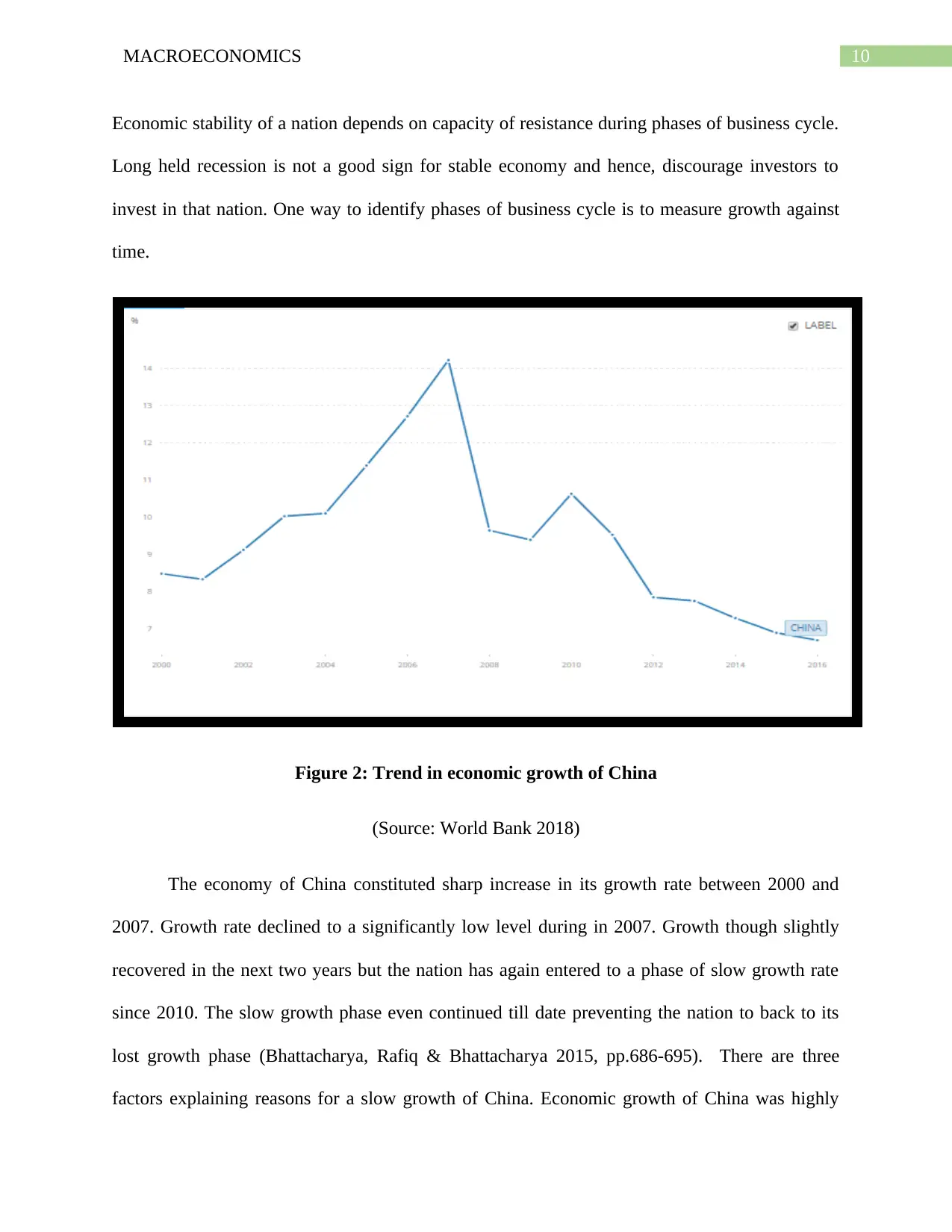
10MACROECONOMICS
Economic stability of a nation depends on capacity of resistance during phases of business cycle.
Long held recession is not a good sign for stable economy and hence, discourage investors to
invest in that nation. One way to identify phases of business cycle is to measure growth against
time.
Figure 2: Trend in economic growth of China
(Source: World Bank 2018)
The economy of China constituted sharp increase in its growth rate between 2000 and
2007. Growth rate declined to a significantly low level during in 2007. Growth though slightly
recovered in the next two years but the nation has again entered to a phase of slow growth rate
since 2010. The slow growth phase even continued till date preventing the nation to back to its
lost growth phase (Bhattacharya, Rafiq & Bhattacharya 2015, pp.686-695). There are three
factors explaining reasons for a slow growth of China. Economic growth of China was highly
Economic stability of a nation depends on capacity of resistance during phases of business cycle.
Long held recession is not a good sign for stable economy and hence, discourage investors to
invest in that nation. One way to identify phases of business cycle is to measure growth against
time.
Figure 2: Trend in economic growth of China
(Source: World Bank 2018)
The economy of China constituted sharp increase in its growth rate between 2000 and
2007. Growth rate declined to a significantly low level during in 2007. Growth though slightly
recovered in the next two years but the nation has again entered to a phase of slow growth rate
since 2010. The slow growth phase even continued till date preventing the nation to back to its
lost growth phase (Bhattacharya, Rafiq & Bhattacharya 2015, pp.686-695). There are three
factors explaining reasons for a slow growth of China. Economic growth of China was highly
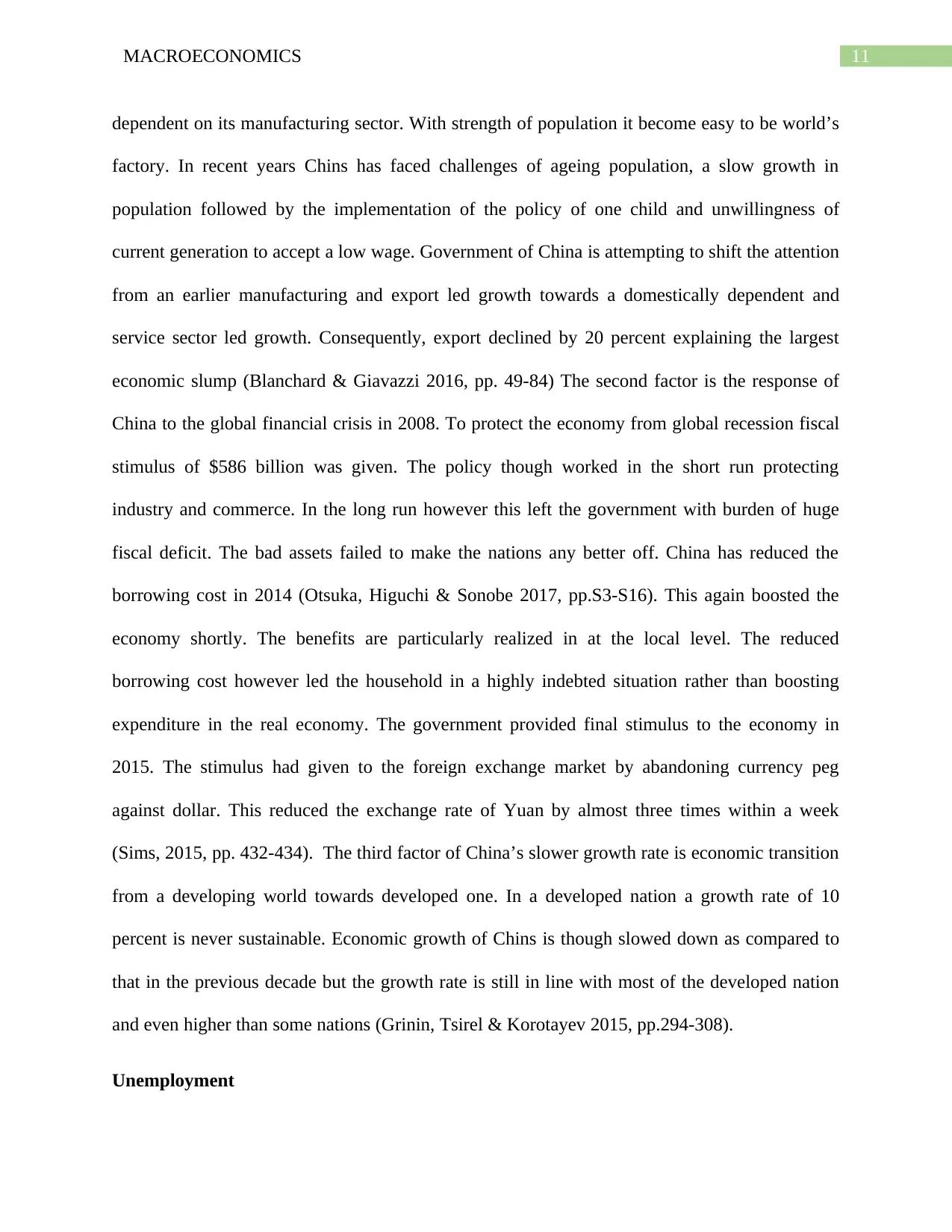
11MACROECONOMICS
dependent on its manufacturing sector. With strength of population it become easy to be world’s
factory. In recent years Chins has faced challenges of ageing population, a slow growth in
population followed by the implementation of the policy of one child and unwillingness of
current generation to accept a low wage. Government of China is attempting to shift the attention
from an earlier manufacturing and export led growth towards a domestically dependent and
service sector led growth. Consequently, export declined by 20 percent explaining the largest
economic slump (Blanchard & Giavazzi 2016, pp. 49-84) The second factor is the response of
China to the global financial crisis in 2008. To protect the economy from global recession fiscal
stimulus of $586 billion was given. The policy though worked in the short run protecting
industry and commerce. In the long run however this left the government with burden of huge
fiscal deficit. The bad assets failed to make the nations any better off. China has reduced the
borrowing cost in 2014 (Otsuka, Higuchi & Sonobe 2017, pp.S3-S16). This again boosted the
economy shortly. The benefits are particularly realized in at the local level. The reduced
borrowing cost however led the household in a highly indebted situation rather than boosting
expenditure in the real economy. The government provided final stimulus to the economy in
2015. The stimulus had given to the foreign exchange market by abandoning currency peg
against dollar. This reduced the exchange rate of Yuan by almost three times within a week
(Sims, 2015, pp. 432-434). The third factor of China’s slower growth rate is economic transition
from a developing world towards developed one. In a developed nation a growth rate of 10
percent is never sustainable. Economic growth of Chins is though slowed down as compared to
that in the previous decade but the growth rate is still in line with most of the developed nation
and even higher than some nations (Grinin, Tsirel & Korotayev 2015, pp.294-308).
Unemployment
dependent on its manufacturing sector. With strength of population it become easy to be world’s
factory. In recent years Chins has faced challenges of ageing population, a slow growth in
population followed by the implementation of the policy of one child and unwillingness of
current generation to accept a low wage. Government of China is attempting to shift the attention
from an earlier manufacturing and export led growth towards a domestically dependent and
service sector led growth. Consequently, export declined by 20 percent explaining the largest
economic slump (Blanchard & Giavazzi 2016, pp. 49-84) The second factor is the response of
China to the global financial crisis in 2008. To protect the economy from global recession fiscal
stimulus of $586 billion was given. The policy though worked in the short run protecting
industry and commerce. In the long run however this left the government with burden of huge
fiscal deficit. The bad assets failed to make the nations any better off. China has reduced the
borrowing cost in 2014 (Otsuka, Higuchi & Sonobe 2017, pp.S3-S16). This again boosted the
economy shortly. The benefits are particularly realized in at the local level. The reduced
borrowing cost however led the household in a highly indebted situation rather than boosting
expenditure in the real economy. The government provided final stimulus to the economy in
2015. The stimulus had given to the foreign exchange market by abandoning currency peg
against dollar. This reduced the exchange rate of Yuan by almost three times within a week
(Sims, 2015, pp. 432-434). The third factor of China’s slower growth rate is economic transition
from a developing world towards developed one. In a developed nation a growth rate of 10
percent is never sustainable. Economic growth of Chins is though slowed down as compared to
that in the previous decade but the growth rate is still in line with most of the developed nation
and even higher than some nations (Grinin, Tsirel & Korotayev 2015, pp.294-308).
Unemployment
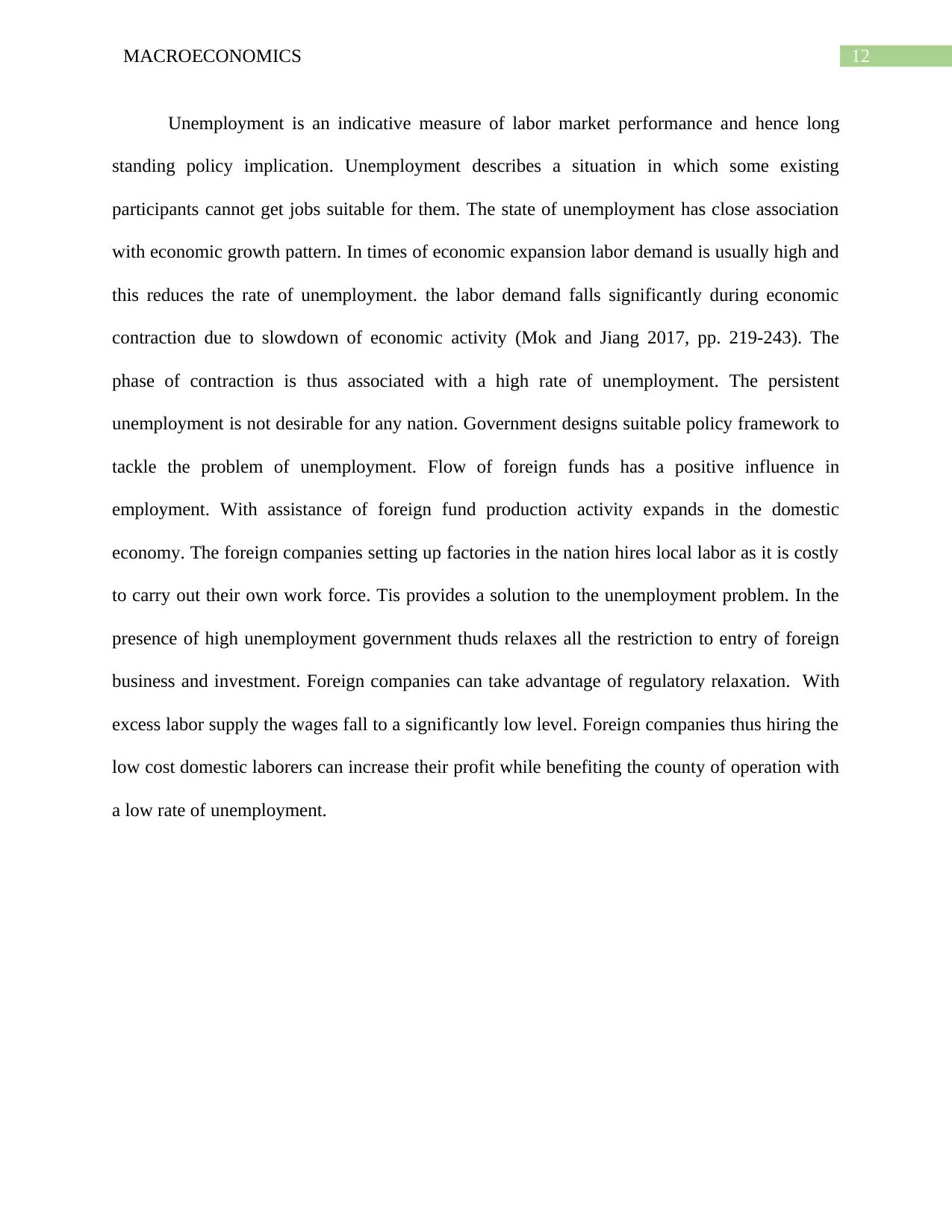
12MACROECONOMICS
Unemployment is an indicative measure of labor market performance and hence long
standing policy implication. Unemployment describes a situation in which some existing
participants cannot get jobs suitable for them. The state of unemployment has close association
with economic growth pattern. In times of economic expansion labor demand is usually high and
this reduces the rate of unemployment. the labor demand falls significantly during economic
contraction due to slowdown of economic activity (Mok and Jiang 2017, pp. 219-243). The
phase of contraction is thus associated with a high rate of unemployment. The persistent
unemployment is not desirable for any nation. Government designs suitable policy framework to
tackle the problem of unemployment. Flow of foreign funds has a positive influence in
employment. With assistance of foreign fund production activity expands in the domestic
economy. The foreign companies setting up factories in the nation hires local labor as it is costly
to carry out their own work force. Tis provides a solution to the unemployment problem. In the
presence of high unemployment government thuds relaxes all the restriction to entry of foreign
business and investment. Foreign companies can take advantage of regulatory relaxation. With
excess labor supply the wages fall to a significantly low level. Foreign companies thus hiring the
low cost domestic laborers can increase their profit while benefiting the county of operation with
a low rate of unemployment.
Unemployment is an indicative measure of labor market performance and hence long
standing policy implication. Unemployment describes a situation in which some existing
participants cannot get jobs suitable for them. The state of unemployment has close association
with economic growth pattern. In times of economic expansion labor demand is usually high and
this reduces the rate of unemployment. the labor demand falls significantly during economic
contraction due to slowdown of economic activity (Mok and Jiang 2017, pp. 219-243). The
phase of contraction is thus associated with a high rate of unemployment. The persistent
unemployment is not desirable for any nation. Government designs suitable policy framework to
tackle the problem of unemployment. Flow of foreign funds has a positive influence in
employment. With assistance of foreign fund production activity expands in the domestic
economy. The foreign companies setting up factories in the nation hires local labor as it is costly
to carry out their own work force. Tis provides a solution to the unemployment problem. In the
presence of high unemployment government thuds relaxes all the restriction to entry of foreign
business and investment. Foreign companies can take advantage of regulatory relaxation. With
excess labor supply the wages fall to a significantly low level. Foreign companies thus hiring the
low cost domestic laborers can increase their profit while benefiting the county of operation with
a low rate of unemployment.
Paraphrase This Document
Need a fresh take? Get an instant paraphrase of this document with our AI Paraphraser
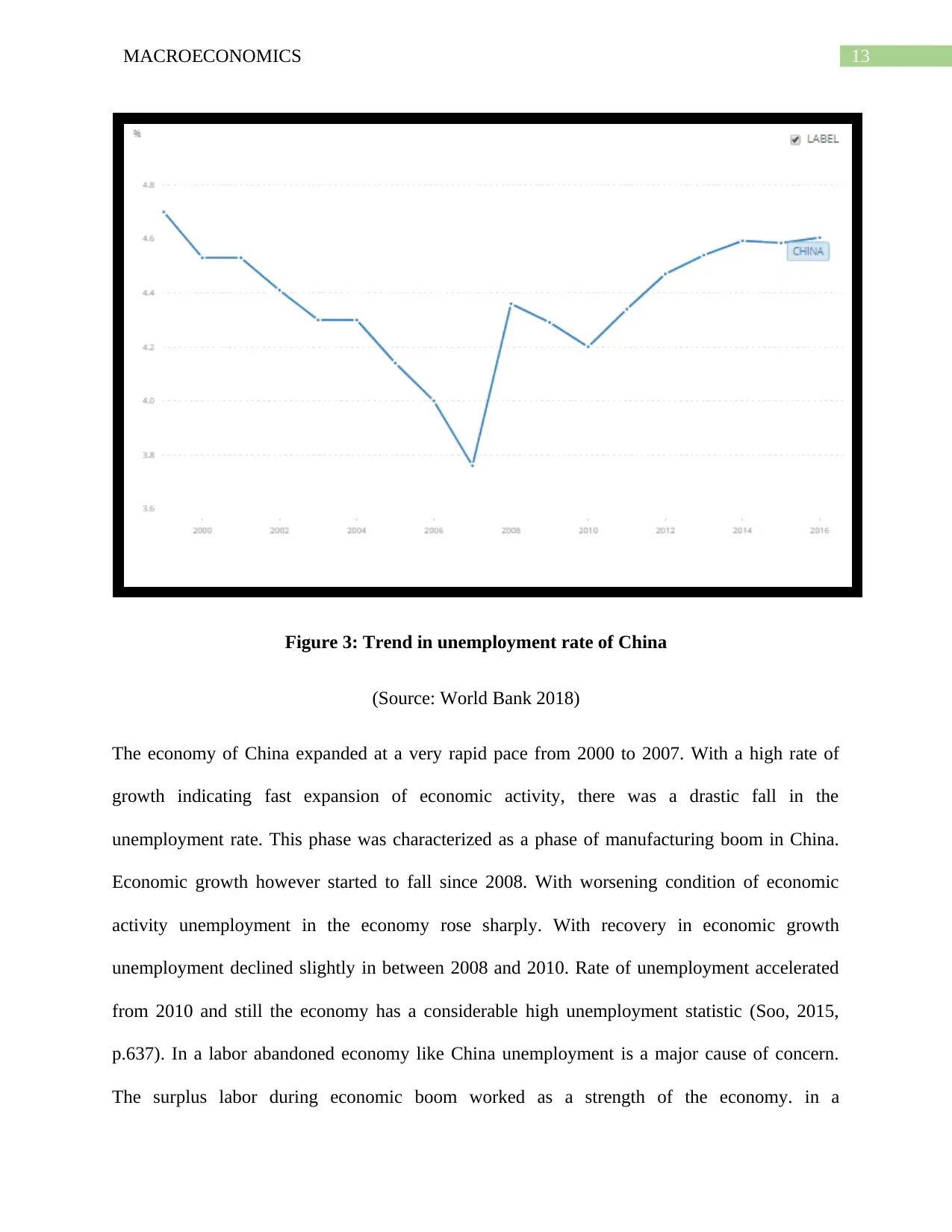
13MACROECONOMICS
Figure 3: Trend in unemployment rate of China
(Source: World Bank 2018)
The economy of China expanded at a very rapid pace from 2000 to 2007. With a high rate of
growth indicating fast expansion of economic activity, there was a drastic fall in the
unemployment rate. This phase was characterized as a phase of manufacturing boom in China.
Economic growth however started to fall since 2008. With worsening condition of economic
activity unemployment in the economy rose sharply. With recovery in economic growth
unemployment declined slightly in between 2008 and 2010. Rate of unemployment accelerated
from 2010 and still the economy has a considerable high unemployment statistic (Soo, 2015,
p.637). In a labor abandoned economy like China unemployment is a major cause of concern.
The surplus labor during economic boom worked as a strength of the economy. in a
Figure 3: Trend in unemployment rate of China
(Source: World Bank 2018)
The economy of China expanded at a very rapid pace from 2000 to 2007. With a high rate of
growth indicating fast expansion of economic activity, there was a drastic fall in the
unemployment rate. This phase was characterized as a phase of manufacturing boom in China.
Economic growth however started to fall since 2008. With worsening condition of economic
activity unemployment in the economy rose sharply. With recovery in economic growth
unemployment declined slightly in between 2008 and 2010. Rate of unemployment accelerated
from 2010 and still the economy has a considerable high unemployment statistic (Soo, 2015,
p.637). In a labor abandoned economy like China unemployment is a major cause of concern.
The surplus labor during economic boom worked as a strength of the economy. in a
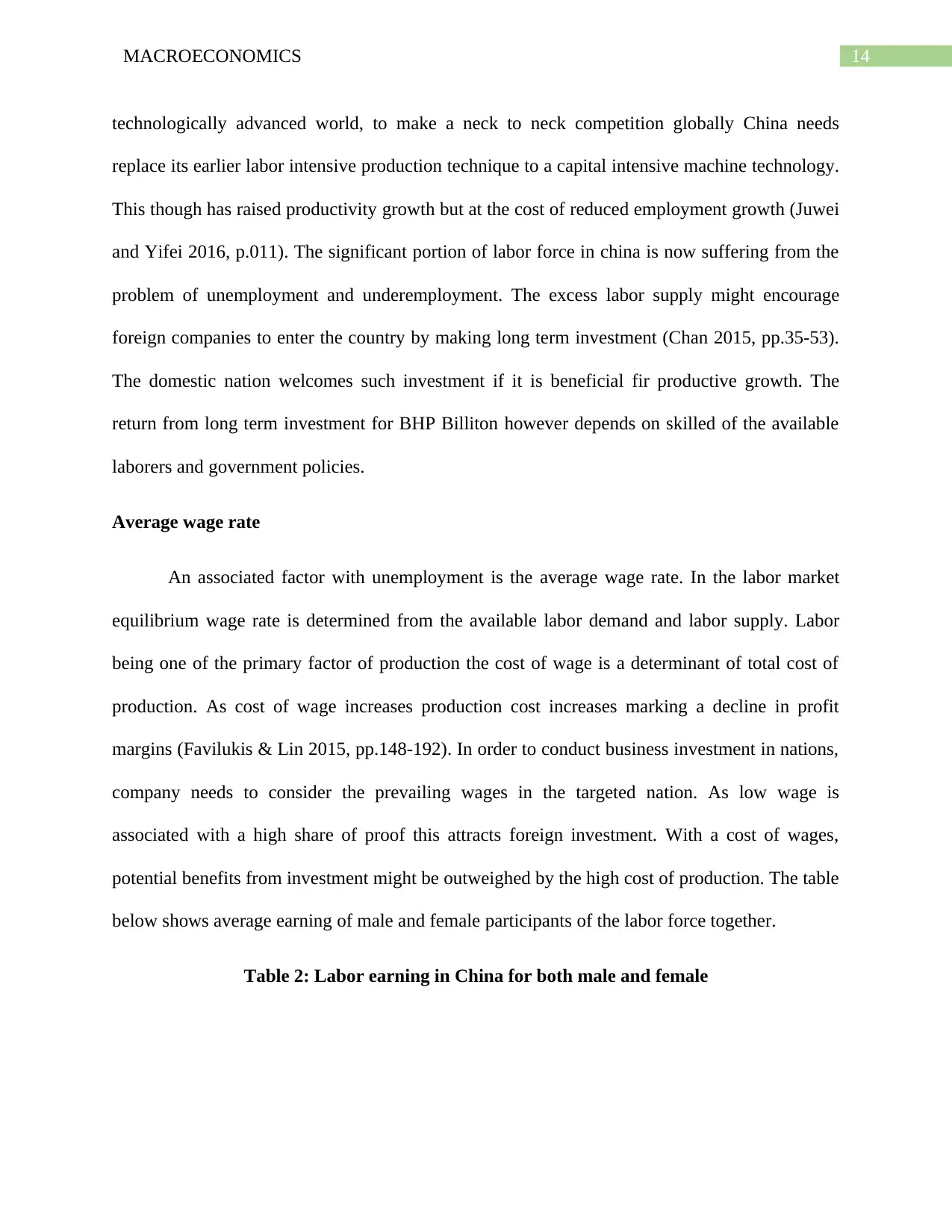
14MACROECONOMICS
technologically advanced world, to make a neck to neck competition globally China needs
replace its earlier labor intensive production technique to a capital intensive machine technology.
This though has raised productivity growth but at the cost of reduced employment growth (Juwei
and Yifei 2016, p.011). The significant portion of labor force in china is now suffering from the
problem of unemployment and underemployment. The excess labor supply might encourage
foreign companies to enter the country by making long term investment (Chan 2015, pp.35-53).
The domestic nation welcomes such investment if it is beneficial fir productive growth. The
return from long term investment for BHP Billiton however depends on skilled of the available
laborers and government policies.
Average wage rate
An associated factor with unemployment is the average wage rate. In the labor market
equilibrium wage rate is determined from the available labor demand and labor supply. Labor
being one of the primary factor of production the cost of wage is a determinant of total cost of
production. As cost of wage increases production cost increases marking a decline in profit
margins (Favilukis & Lin 2015, pp.148-192). In order to conduct business investment in nations,
company needs to consider the prevailing wages in the targeted nation. As low wage is
associated with a high share of proof this attracts foreign investment. With a cost of wages,
potential benefits from investment might be outweighed by the high cost of production. The table
below shows average earning of male and female participants of the labor force together.
Table 2: Labor earning in China for both male and female
technologically advanced world, to make a neck to neck competition globally China needs
replace its earlier labor intensive production technique to a capital intensive machine technology.
This though has raised productivity growth but at the cost of reduced employment growth (Juwei
and Yifei 2016, p.011). The significant portion of labor force in china is now suffering from the
problem of unemployment and underemployment. The excess labor supply might encourage
foreign companies to enter the country by making long term investment (Chan 2015, pp.35-53).
The domestic nation welcomes such investment if it is beneficial fir productive growth. The
return from long term investment for BHP Billiton however depends on skilled of the available
laborers and government policies.
Average wage rate
An associated factor with unemployment is the average wage rate. In the labor market
equilibrium wage rate is determined from the available labor demand and labor supply. Labor
being one of the primary factor of production the cost of wage is a determinant of total cost of
production. As cost of wage increases production cost increases marking a decline in profit
margins (Favilukis & Lin 2015, pp.148-192). In order to conduct business investment in nations,
company needs to consider the prevailing wages in the targeted nation. As low wage is
associated with a high share of proof this attracts foreign investment. With a cost of wages,
potential benefits from investment might be outweighed by the high cost of production. The table
below shows average earning of male and female participants of the labor force together.
Table 2: Labor earning in China for both male and female
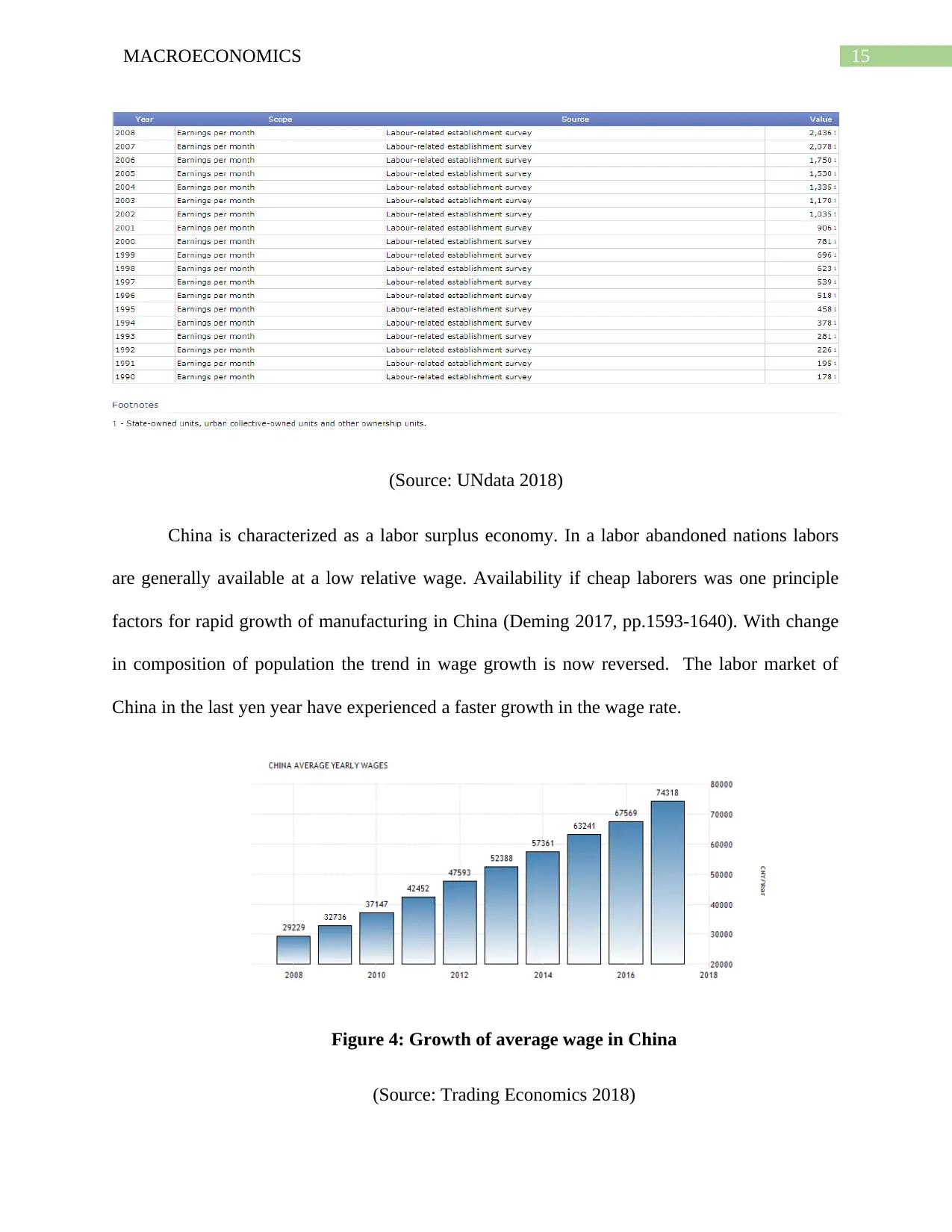
15MACROECONOMICS
(Source: UNdata 2018)
China is characterized as a labor surplus economy. In a labor abandoned nations labors
are generally available at a low relative wage. Availability if cheap laborers was one principle
factors for rapid growth of manufacturing in China (Deming 2017, pp.1593-1640). With change
in composition of population the trend in wage growth is now reversed. The labor market of
China in the last yen year have experienced a faster growth in the wage rate.
Figure 4: Growth of average wage in China
(Source: Trading Economics 2018)
(Source: UNdata 2018)
China is characterized as a labor surplus economy. In a labor abandoned nations labors
are generally available at a low relative wage. Availability if cheap laborers was one principle
factors for rapid growth of manufacturing in China (Deming 2017, pp.1593-1640). With change
in composition of population the trend in wage growth is now reversed. The labor market of
China in the last yen year have experienced a faster growth in the wage rate.
Figure 4: Growth of average wage in China
(Source: Trading Economics 2018)
Secure Best Marks with AI Grader
Need help grading? Try our AI Grader for instant feedback on your assignments.
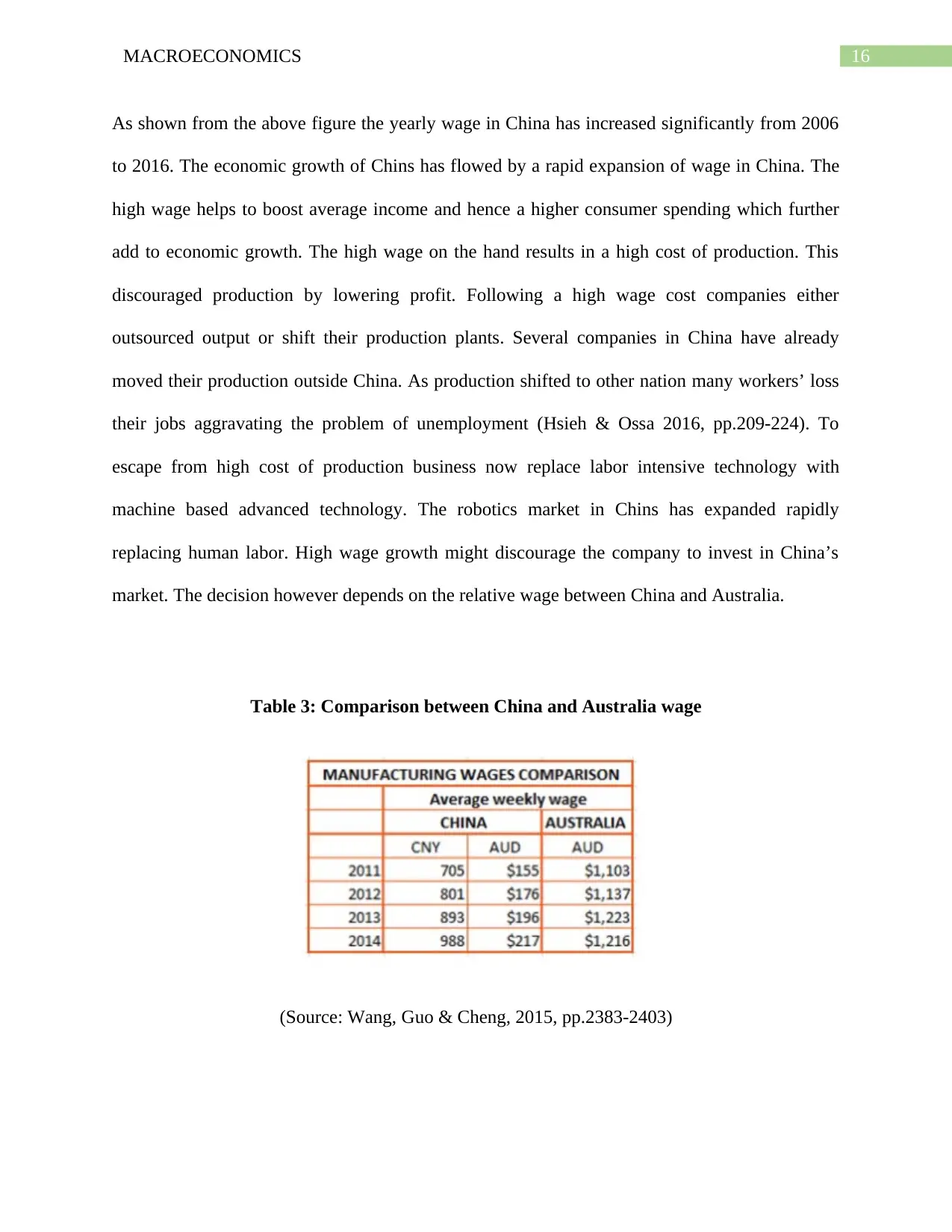
16MACROECONOMICS
As shown from the above figure the yearly wage in China has increased significantly from 2006
to 2016. The economic growth of Chins has flowed by a rapid expansion of wage in China. The
high wage helps to boost average income and hence a higher consumer spending which further
add to economic growth. The high wage on the hand results in a high cost of production. This
discouraged production by lowering profit. Following a high wage cost companies either
outsourced output or shift their production plants. Several companies in China have already
moved their production outside China. As production shifted to other nation many workers’ loss
their jobs aggravating the problem of unemployment (Hsieh & Ossa 2016, pp.209-224). To
escape from high cost of production business now replace labor intensive technology with
machine based advanced technology. The robotics market in Chins has expanded rapidly
replacing human labor. High wage growth might discourage the company to invest in China’s
market. The decision however depends on the relative wage between China and Australia.
Table 3: Comparison between China and Australia wage
(Source: Wang, Guo & Cheng, 2015, pp.2383-2403)
As shown from the above figure the yearly wage in China has increased significantly from 2006
to 2016. The economic growth of Chins has flowed by a rapid expansion of wage in China. The
high wage helps to boost average income and hence a higher consumer spending which further
add to economic growth. The high wage on the hand results in a high cost of production. This
discouraged production by lowering profit. Following a high wage cost companies either
outsourced output or shift their production plants. Several companies in China have already
moved their production outside China. As production shifted to other nation many workers’ loss
their jobs aggravating the problem of unemployment (Hsieh & Ossa 2016, pp.209-224). To
escape from high cost of production business now replace labor intensive technology with
machine based advanced technology. The robotics market in Chins has expanded rapidly
replacing human labor. High wage growth might discourage the company to invest in China’s
market. The decision however depends on the relative wage between China and Australia.
Table 3: Comparison between China and Australia wage
(Source: Wang, Guo & Cheng, 2015, pp.2383-2403)
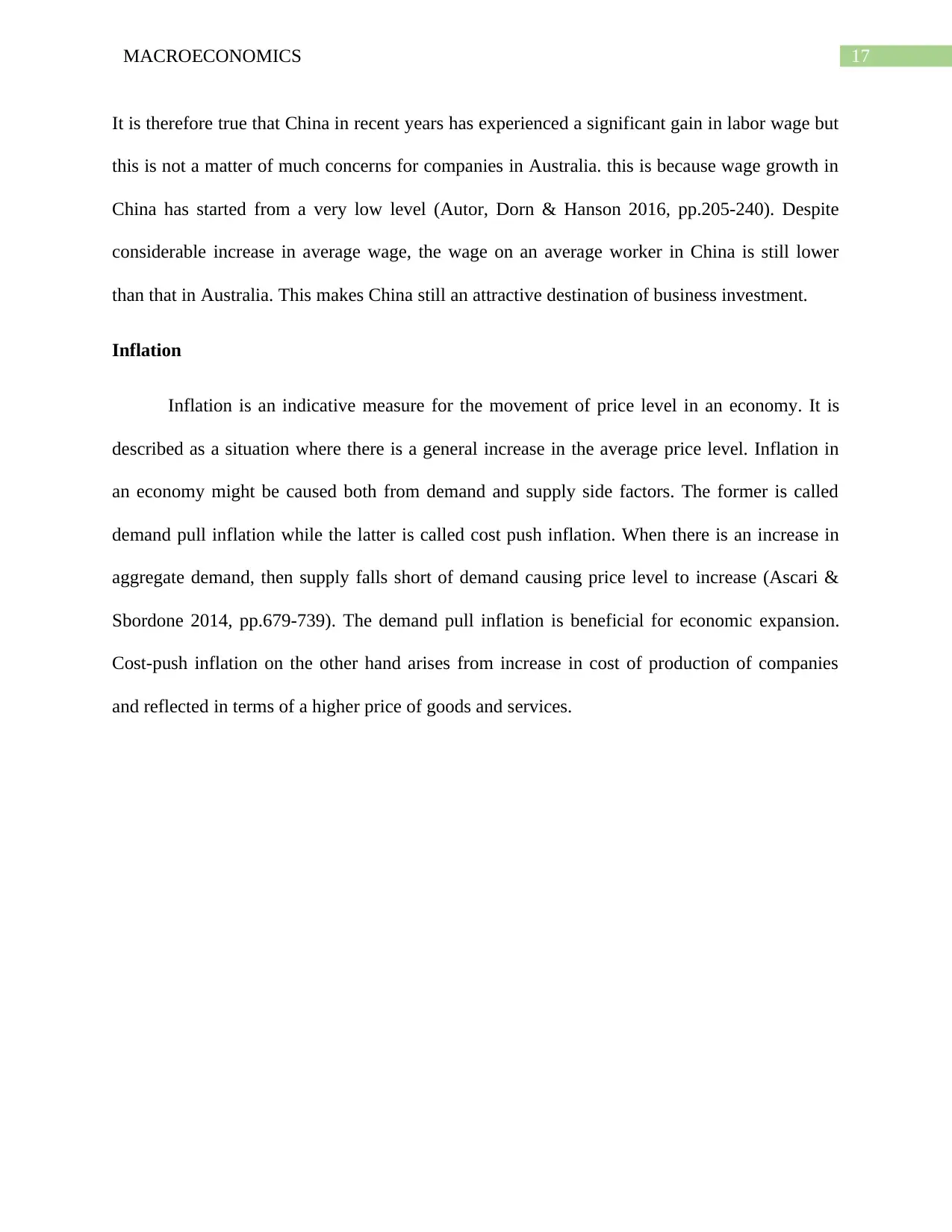
17MACROECONOMICS
It is therefore true that China in recent years has experienced a significant gain in labor wage but
this is not a matter of much concerns for companies in Australia. this is because wage growth in
China has started from a very low level (Autor, Dorn & Hanson 2016, pp.205-240). Despite
considerable increase in average wage, the wage on an average worker in China is still lower
than that in Australia. This makes China still an attractive destination of business investment.
Inflation
Inflation is an indicative measure for the movement of price level in an economy. It is
described as a situation where there is a general increase in the average price level. Inflation in
an economy might be caused both from demand and supply side factors. The former is called
demand pull inflation while the latter is called cost push inflation. When there is an increase in
aggregate demand, then supply falls short of demand causing price level to increase (Ascari &
Sbordone 2014, pp.679-739). The demand pull inflation is beneficial for economic expansion.
Cost-push inflation on the other hand arises from increase in cost of production of companies
and reflected in terms of a higher price of goods and services.
It is therefore true that China in recent years has experienced a significant gain in labor wage but
this is not a matter of much concerns for companies in Australia. this is because wage growth in
China has started from a very low level (Autor, Dorn & Hanson 2016, pp.205-240). Despite
considerable increase in average wage, the wage on an average worker in China is still lower
than that in Australia. This makes China still an attractive destination of business investment.
Inflation
Inflation is an indicative measure for the movement of price level in an economy. It is
described as a situation where there is a general increase in the average price level. Inflation in
an economy might be caused both from demand and supply side factors. The former is called
demand pull inflation while the latter is called cost push inflation. When there is an increase in
aggregate demand, then supply falls short of demand causing price level to increase (Ascari &
Sbordone 2014, pp.679-739). The demand pull inflation is beneficial for economic expansion.
Cost-push inflation on the other hand arises from increase in cost of production of companies
and reflected in terms of a higher price of goods and services.
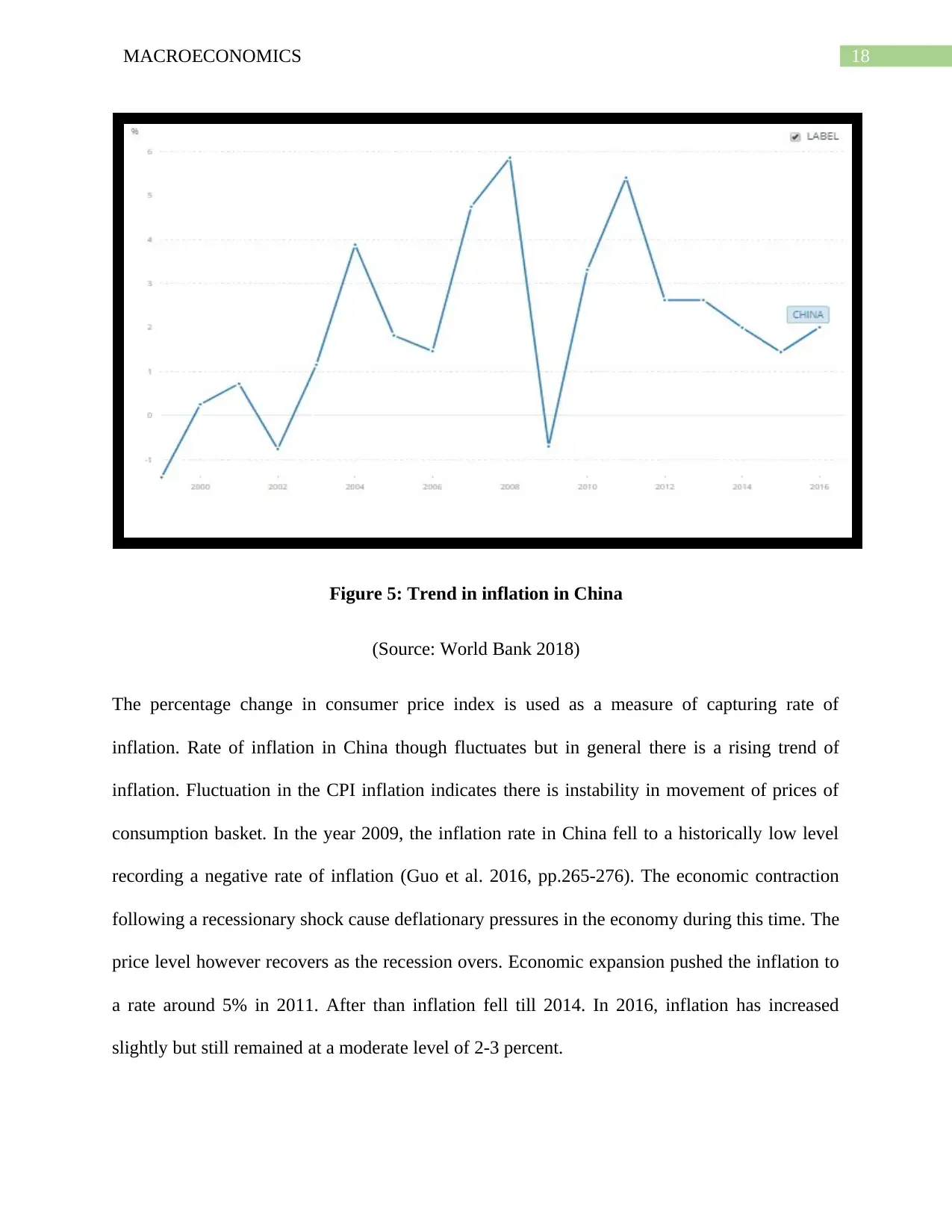
18MACROECONOMICS
Figure 5: Trend in inflation in China
(Source: World Bank 2018)
The percentage change in consumer price index is used as a measure of capturing rate of
inflation. Rate of inflation in China though fluctuates but in general there is a rising trend of
inflation. Fluctuation in the CPI inflation indicates there is instability in movement of prices of
consumption basket. In the year 2009, the inflation rate in China fell to a historically low level
recording a negative rate of inflation (Guo et al. 2016, pp.265-276). The economic contraction
following a recessionary shock cause deflationary pressures in the economy during this time. The
price level however recovers as the recession overs. Economic expansion pushed the inflation to
a rate around 5% in 2011. After than inflation fell till 2014. In 2016, inflation has increased
slightly but still remained at a moderate level of 2-3 percent.
Figure 5: Trend in inflation in China
(Source: World Bank 2018)
The percentage change in consumer price index is used as a measure of capturing rate of
inflation. Rate of inflation in China though fluctuates but in general there is a rising trend of
inflation. Fluctuation in the CPI inflation indicates there is instability in movement of prices of
consumption basket. In the year 2009, the inflation rate in China fell to a historically low level
recording a negative rate of inflation (Guo et al. 2016, pp.265-276). The economic contraction
following a recessionary shock cause deflationary pressures in the economy during this time. The
price level however recovers as the recession overs. Economic expansion pushed the inflation to
a rate around 5% in 2011. After than inflation fell till 2014. In 2016, inflation has increased
slightly but still remained at a moderate level of 2-3 percent.
Paraphrase This Document
Need a fresh take? Get an instant paraphrase of this document with our AI Paraphraser
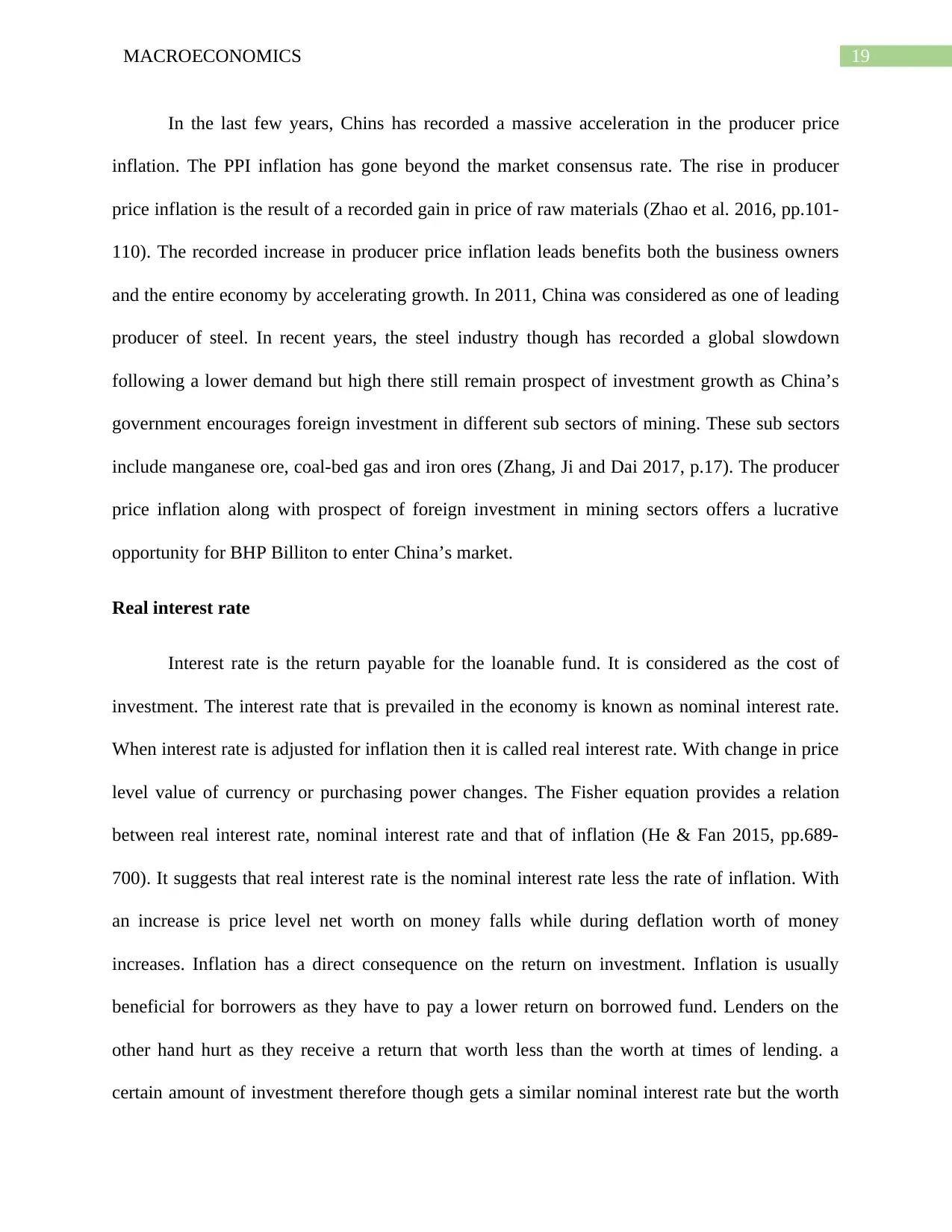
19MACROECONOMICS
In the last few years, Chins has recorded a massive acceleration in the producer price
inflation. The PPI inflation has gone beyond the market consensus rate. The rise in producer
price inflation is the result of a recorded gain in price of raw materials (Zhao et al. 2016, pp.101-
110). The recorded increase in producer price inflation leads benefits both the business owners
and the entire economy by accelerating growth. In 2011, China was considered as one of leading
producer of steel. In recent years, the steel industry though has recorded a global slowdown
following a lower demand but high there still remain prospect of investment growth as China’s
government encourages foreign investment in different sub sectors of mining. These sub sectors
include manganese ore, coal-bed gas and iron ores (Zhang, Ji and Dai 2017, p.17). The producer
price inflation along with prospect of foreign investment in mining sectors offers a lucrative
opportunity for BHP Billiton to enter China’s market.
Real interest rate
Interest rate is the return payable for the loanable fund. It is considered as the cost of
investment. The interest rate that is prevailed in the economy is known as nominal interest rate.
When interest rate is adjusted for inflation then it is called real interest rate. With change in price
level value of currency or purchasing power changes. The Fisher equation provides a relation
between real interest rate, nominal interest rate and that of inflation (He & Fan 2015, pp.689-
700). It suggests that real interest rate is the nominal interest rate less the rate of inflation. With
an increase is price level net worth on money falls while during deflation worth of money
increases. Inflation has a direct consequence on the return on investment. Inflation is usually
beneficial for borrowers as they have to pay a lower return on borrowed fund. Lenders on the
other hand hurt as they receive a return that worth less than the worth at times of lending. a
certain amount of investment therefore though gets a similar nominal interest rate but the worth
In the last few years, Chins has recorded a massive acceleration in the producer price
inflation. The PPI inflation has gone beyond the market consensus rate. The rise in producer
price inflation is the result of a recorded gain in price of raw materials (Zhao et al. 2016, pp.101-
110). The recorded increase in producer price inflation leads benefits both the business owners
and the entire economy by accelerating growth. In 2011, China was considered as one of leading
producer of steel. In recent years, the steel industry though has recorded a global slowdown
following a lower demand but high there still remain prospect of investment growth as China’s
government encourages foreign investment in different sub sectors of mining. These sub sectors
include manganese ore, coal-bed gas and iron ores (Zhang, Ji and Dai 2017, p.17). The producer
price inflation along with prospect of foreign investment in mining sectors offers a lucrative
opportunity for BHP Billiton to enter China’s market.
Real interest rate
Interest rate is the return payable for the loanable fund. It is considered as the cost of
investment. The interest rate that is prevailed in the economy is known as nominal interest rate.
When interest rate is adjusted for inflation then it is called real interest rate. With change in price
level value of currency or purchasing power changes. The Fisher equation provides a relation
between real interest rate, nominal interest rate and that of inflation (He & Fan 2015, pp.689-
700). It suggests that real interest rate is the nominal interest rate less the rate of inflation. With
an increase is price level net worth on money falls while during deflation worth of money
increases. Inflation has a direct consequence on the return on investment. Inflation is usually
beneficial for borrowers as they have to pay a lower return on borrowed fund. Lenders on the
other hand hurt as they receive a return that worth less than the worth at times of lending. a
certain amount of investment therefore though gets a similar nominal interest rate but the worth
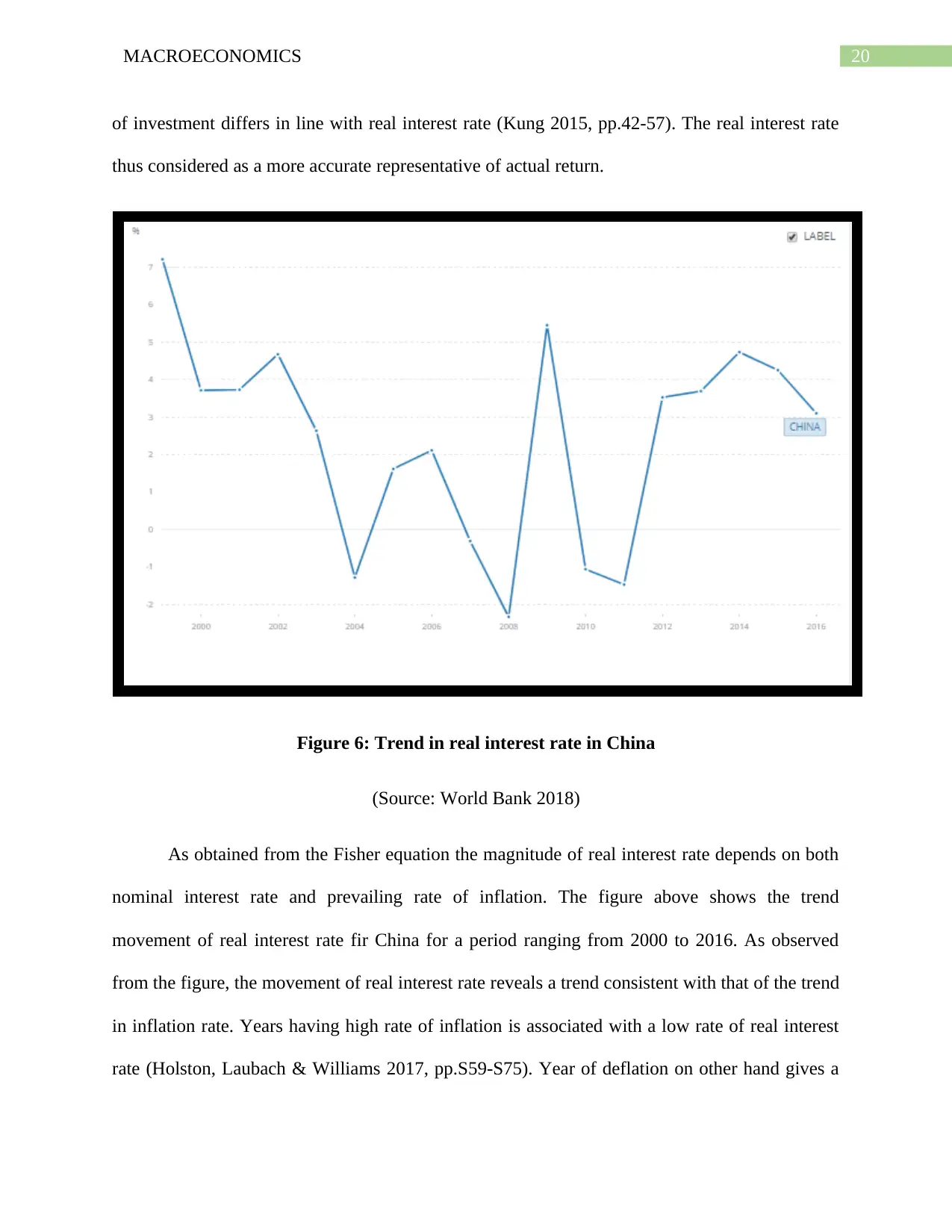
20MACROECONOMICS
of investment differs in line with real interest rate (Kung 2015, pp.42-57). The real interest rate
thus considered as a more accurate representative of actual return.
Figure 6: Trend in real interest rate in China
(Source: World Bank 2018)
As obtained from the Fisher equation the magnitude of real interest rate depends on both
nominal interest rate and prevailing rate of inflation. The figure above shows the trend
movement of real interest rate fir China for a period ranging from 2000 to 2016. As observed
from the figure, the movement of real interest rate reveals a trend consistent with that of the trend
in inflation rate. Years having high rate of inflation is associated with a low rate of real interest
rate (Holston, Laubach & Williams 2017, pp.S59-S75). Year of deflation on other hand gives a
of investment differs in line with real interest rate (Kung 2015, pp.42-57). The real interest rate
thus considered as a more accurate representative of actual return.
Figure 6: Trend in real interest rate in China
(Source: World Bank 2018)
As obtained from the Fisher equation the magnitude of real interest rate depends on both
nominal interest rate and prevailing rate of inflation. The figure above shows the trend
movement of real interest rate fir China for a period ranging from 2000 to 2016. As observed
from the figure, the movement of real interest rate reveals a trend consistent with that of the trend
in inflation rate. Years having high rate of inflation is associated with a low rate of real interest
rate (Holston, Laubach & Williams 2017, pp.S59-S75). Year of deflation on other hand gives a
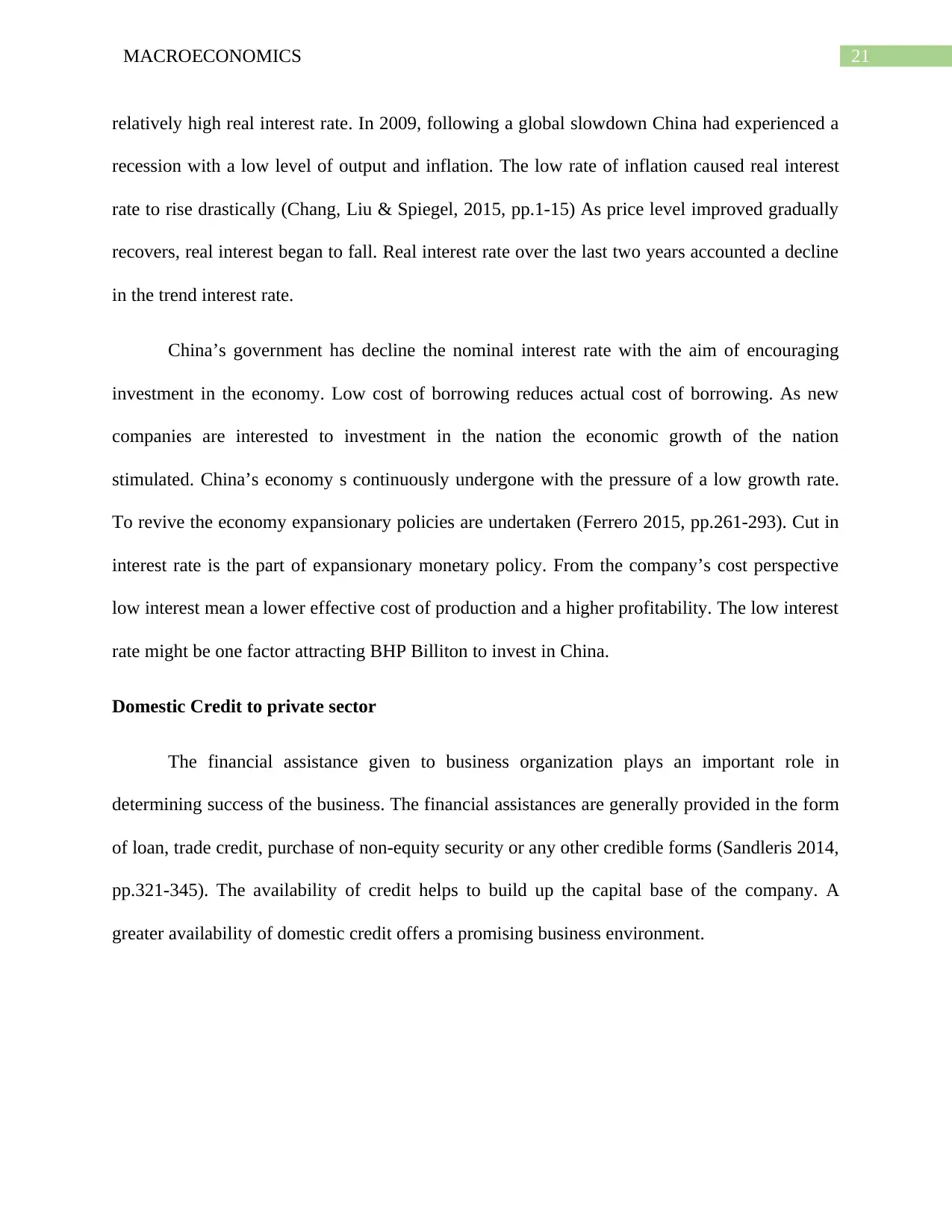
21MACROECONOMICS
relatively high real interest rate. In 2009, following a global slowdown China had experienced a
recession with a low level of output and inflation. The low rate of inflation caused real interest
rate to rise drastically (Chang, Liu & Spiegel, 2015, pp.1-15) As price level improved gradually
recovers, real interest began to fall. Real interest rate over the last two years accounted a decline
in the trend interest rate.
China’s government has decline the nominal interest rate with the aim of encouraging
investment in the economy. Low cost of borrowing reduces actual cost of borrowing. As new
companies are interested to investment in the nation the economic growth of the nation
stimulated. China’s economy s continuously undergone with the pressure of a low growth rate.
To revive the economy expansionary policies are undertaken (Ferrero 2015, pp.261-293). Cut in
interest rate is the part of expansionary monetary policy. From the company’s cost perspective
low interest mean a lower effective cost of production and a higher profitability. The low interest
rate might be one factor attracting BHP Billiton to invest in China.
Domestic Credit to private sector
The financial assistance given to business organization plays an important role in
determining success of the business. The financial assistances are generally provided in the form
of loan, trade credit, purchase of non-equity security or any other credible forms (Sandleris 2014,
pp.321-345). The availability of credit helps to build up the capital base of the company. A
greater availability of domestic credit offers a promising business environment.
relatively high real interest rate. In 2009, following a global slowdown China had experienced a
recession with a low level of output and inflation. The low rate of inflation caused real interest
rate to rise drastically (Chang, Liu & Spiegel, 2015, pp.1-15) As price level improved gradually
recovers, real interest began to fall. Real interest rate over the last two years accounted a decline
in the trend interest rate.
China’s government has decline the nominal interest rate with the aim of encouraging
investment in the economy. Low cost of borrowing reduces actual cost of borrowing. As new
companies are interested to investment in the nation the economic growth of the nation
stimulated. China’s economy s continuously undergone with the pressure of a low growth rate.
To revive the economy expansionary policies are undertaken (Ferrero 2015, pp.261-293). Cut in
interest rate is the part of expansionary monetary policy. From the company’s cost perspective
low interest mean a lower effective cost of production and a higher profitability. The low interest
rate might be one factor attracting BHP Billiton to invest in China.
Domestic Credit to private sector
The financial assistance given to business organization plays an important role in
determining success of the business. The financial assistances are generally provided in the form
of loan, trade credit, purchase of non-equity security or any other credible forms (Sandleris 2014,
pp.321-345). The availability of credit helps to build up the capital base of the company. A
greater availability of domestic credit offers a promising business environment.
Secure Best Marks with AI Grader
Need help grading? Try our AI Grader for instant feedback on your assignments.
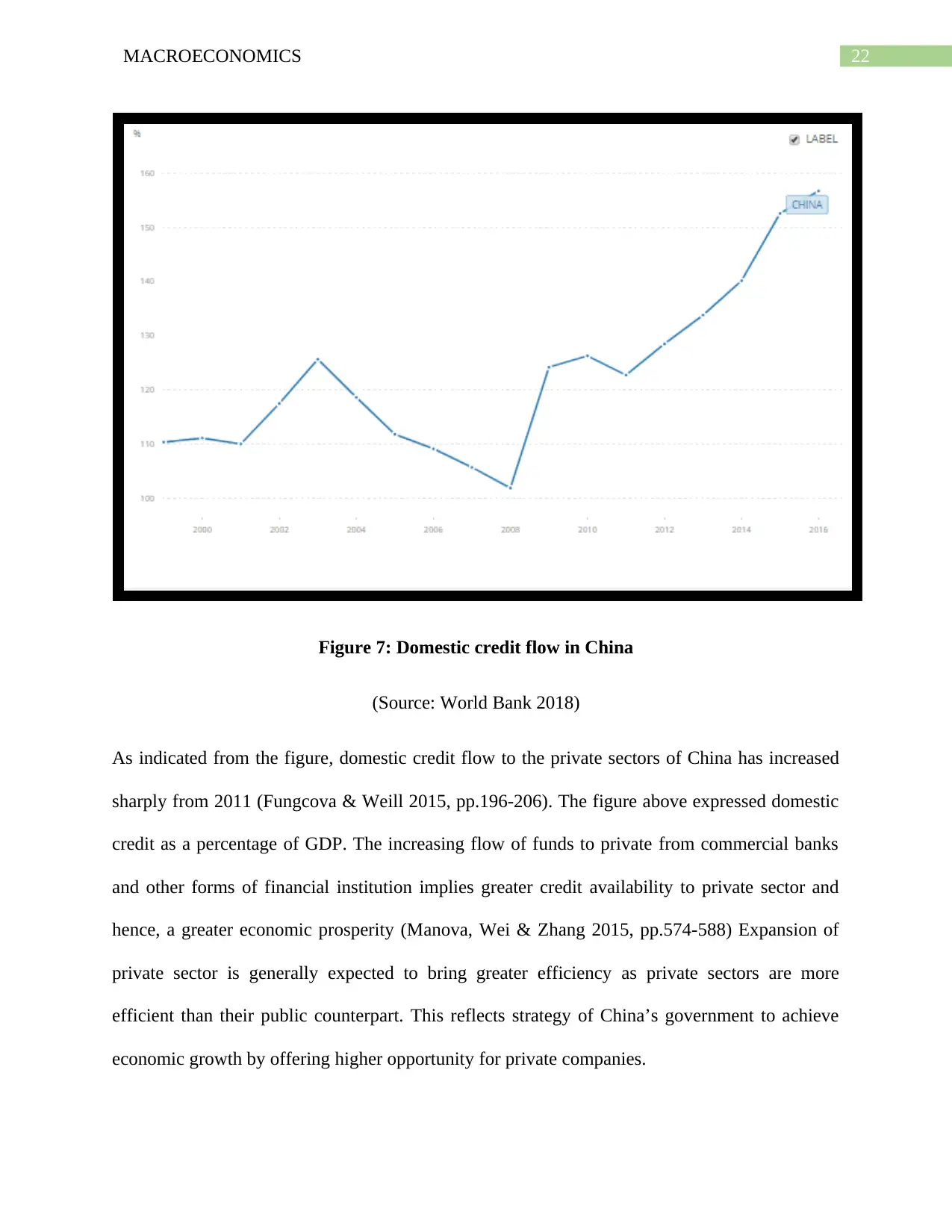
22MACROECONOMICS
Figure 7: Domestic credit flow in China
(Source: World Bank 2018)
As indicated from the figure, domestic credit flow to the private sectors of China has increased
sharply from 2011 (Fungcova & Weill 2015, pp.196-206). The figure above expressed domestic
credit as a percentage of GDP. The increasing flow of funds to private from commercial banks
and other forms of financial institution implies greater credit availability to private sector and
hence, a greater economic prosperity (Manova, Wei & Zhang 2015, pp.574-588) Expansion of
private sector is generally expected to bring greater efficiency as private sectors are more
efficient than their public counterpart. This reflects strategy of China’s government to achieve
economic growth by offering higher opportunity for private companies.
Figure 7: Domestic credit flow in China
(Source: World Bank 2018)
As indicated from the figure, domestic credit flow to the private sectors of China has increased
sharply from 2011 (Fungcova & Weill 2015, pp.196-206). The figure above expressed domestic
credit as a percentage of GDP. The increasing flow of funds to private from commercial banks
and other forms of financial institution implies greater credit availability to private sector and
hence, a greater economic prosperity (Manova, Wei & Zhang 2015, pp.574-588) Expansion of
private sector is generally expected to bring greater efficiency as private sectors are more
efficient than their public counterpart. This reflects strategy of China’s government to achieve
economic growth by offering higher opportunity for private companies.
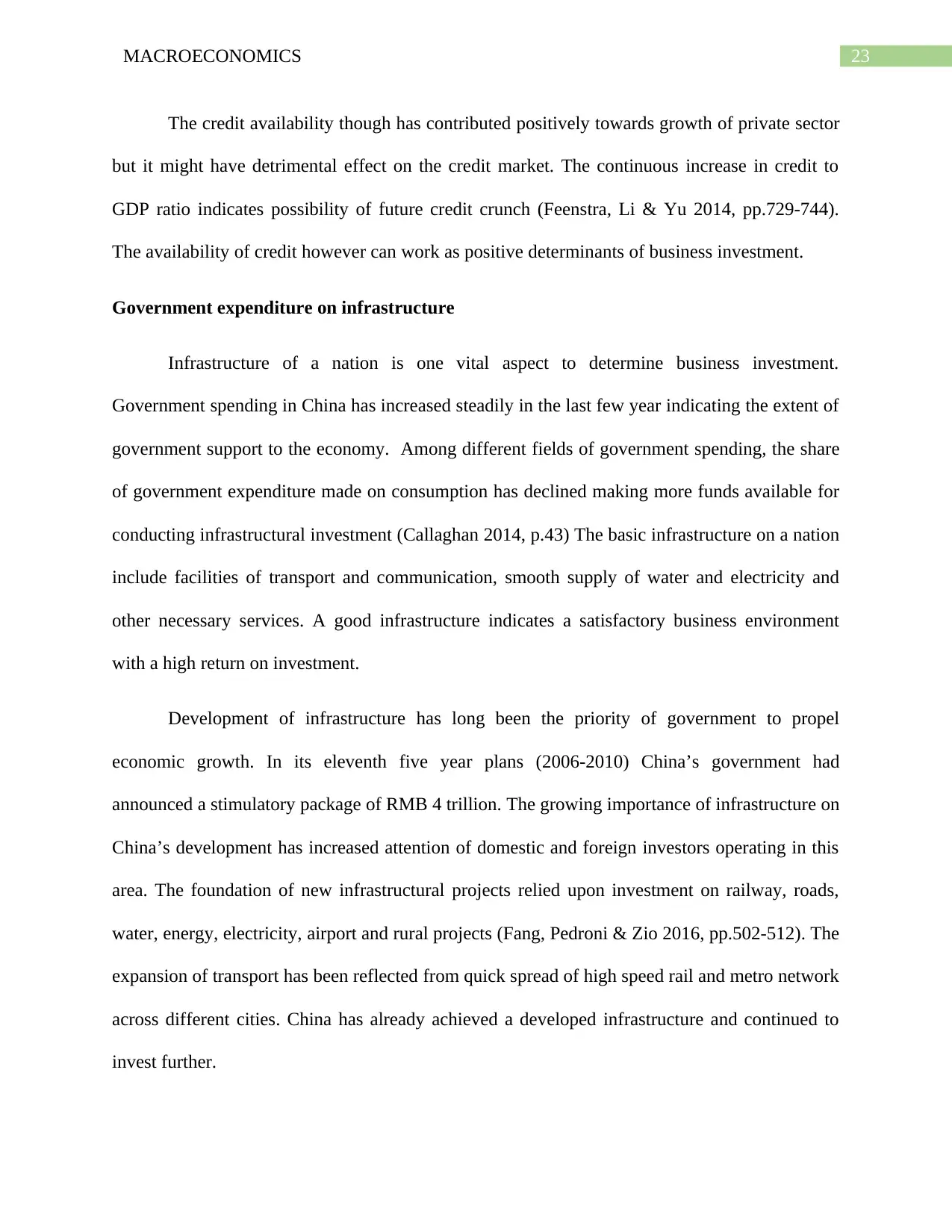
23MACROECONOMICS
The credit availability though has contributed positively towards growth of private sector
but it might have detrimental effect on the credit market. The continuous increase in credit to
GDP ratio indicates possibility of future credit crunch (Feenstra, Li & Yu 2014, pp.729-744).
The availability of credit however can work as positive determinants of business investment.
Government expenditure on infrastructure
Infrastructure of a nation is one vital aspect to determine business investment.
Government spending in China has increased steadily in the last few year indicating the extent of
government support to the economy. Among different fields of government spending, the share
of government expenditure made on consumption has declined making more funds available for
conducting infrastructural investment (Callaghan 2014, p.43) The basic infrastructure on a nation
include facilities of transport and communication, smooth supply of water and electricity and
other necessary services. A good infrastructure indicates a satisfactory business environment
with a high return on investment.
Development of infrastructure has long been the priority of government to propel
economic growth. In its eleventh five year plans (2006-2010) China’s government had
announced a stimulatory package of RMB 4 trillion. The growing importance of infrastructure on
China’s development has increased attention of domestic and foreign investors operating in this
area. The foundation of new infrastructural projects relied upon investment on railway, roads,
water, energy, electricity, airport and rural projects (Fang, Pedroni & Zio 2016, pp.502-512). The
expansion of transport has been reflected from quick spread of high speed rail and metro network
across different cities. China has already achieved a developed infrastructure and continued to
invest further.
The credit availability though has contributed positively towards growth of private sector
but it might have detrimental effect on the credit market. The continuous increase in credit to
GDP ratio indicates possibility of future credit crunch (Feenstra, Li & Yu 2014, pp.729-744).
The availability of credit however can work as positive determinants of business investment.
Government expenditure on infrastructure
Infrastructure of a nation is one vital aspect to determine business investment.
Government spending in China has increased steadily in the last few year indicating the extent of
government support to the economy. Among different fields of government spending, the share
of government expenditure made on consumption has declined making more funds available for
conducting infrastructural investment (Callaghan 2014, p.43) The basic infrastructure on a nation
include facilities of transport and communication, smooth supply of water and electricity and
other necessary services. A good infrastructure indicates a satisfactory business environment
with a high return on investment.
Development of infrastructure has long been the priority of government to propel
economic growth. In its eleventh five year plans (2006-2010) China’s government had
announced a stimulatory package of RMB 4 trillion. The growing importance of infrastructure on
China’s development has increased attention of domestic and foreign investors operating in this
area. The foundation of new infrastructural projects relied upon investment on railway, roads,
water, energy, electricity, airport and rural projects (Fang, Pedroni & Zio 2016, pp.502-512). The
expansion of transport has been reflected from quick spread of high speed rail and metro network
across different cities. China has already achieved a developed infrastructure and continued to
invest further.
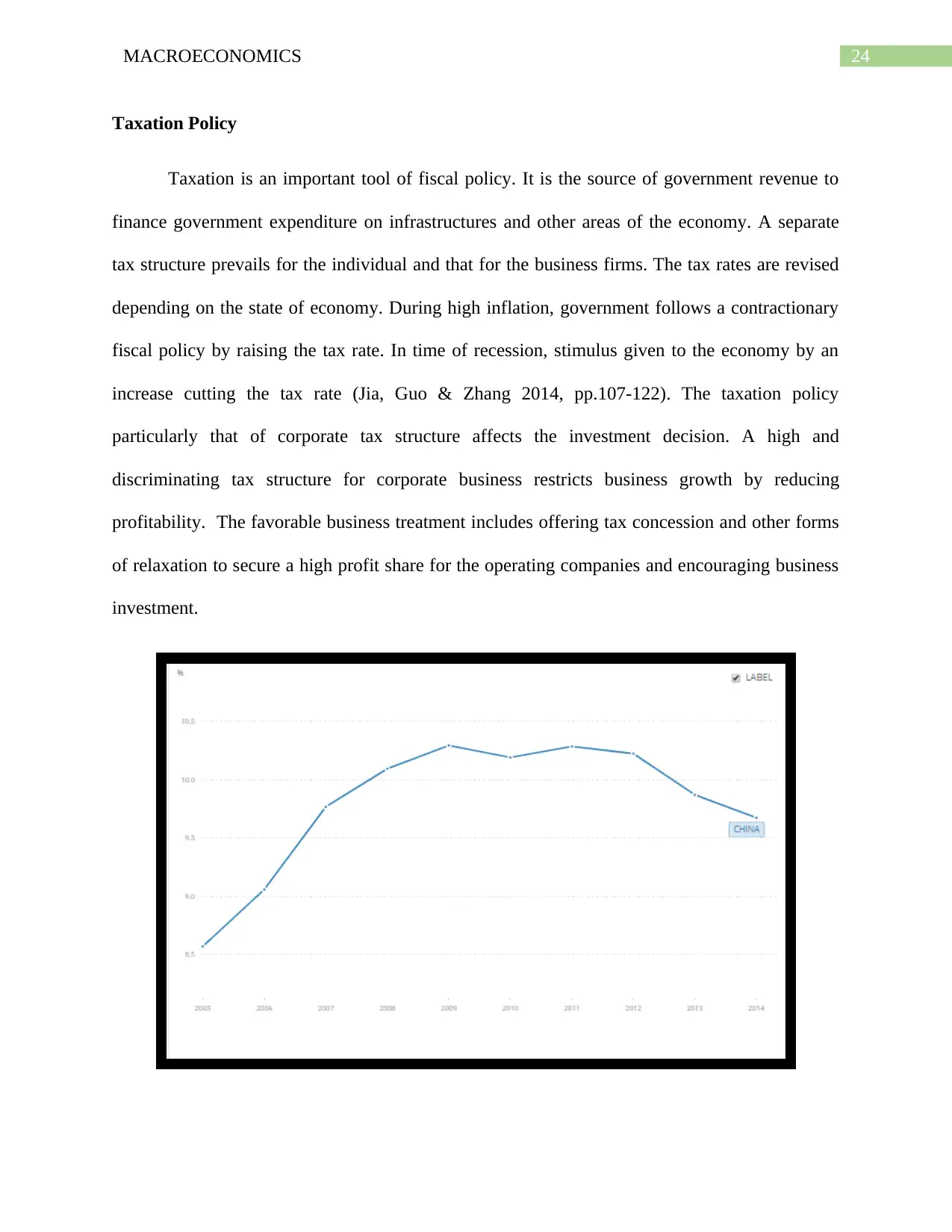
24MACROECONOMICS
Taxation Policy
Taxation is an important tool of fiscal policy. It is the source of government revenue to
finance government expenditure on infrastructures and other areas of the economy. A separate
tax structure prevails for the individual and that for the business firms. The tax rates are revised
depending on the state of economy. During high inflation, government follows a contractionary
fiscal policy by raising the tax rate. In time of recession, stimulus given to the economy by an
increase cutting the tax rate (Jia, Guo & Zhang 2014, pp.107-122). The taxation policy
particularly that of corporate tax structure affects the investment decision. A high and
discriminating tax structure for corporate business restricts business growth by reducing
profitability. The favorable business treatment includes offering tax concession and other forms
of relaxation to secure a high profit share for the operating companies and encouraging business
investment.
Taxation Policy
Taxation is an important tool of fiscal policy. It is the source of government revenue to
finance government expenditure on infrastructures and other areas of the economy. A separate
tax structure prevails for the individual and that for the business firms. The tax rates are revised
depending on the state of economy. During high inflation, government follows a contractionary
fiscal policy by raising the tax rate. In time of recession, stimulus given to the economy by an
increase cutting the tax rate (Jia, Guo & Zhang 2014, pp.107-122). The taxation policy
particularly that of corporate tax structure affects the investment decision. A high and
discriminating tax structure for corporate business restricts business growth by reducing
profitability. The favorable business treatment includes offering tax concession and other forms
of relaxation to secure a high profit share for the operating companies and encouraging business
investment.
Paraphrase This Document
Need a fresh take? Get an instant paraphrase of this document with our AI Paraphraser
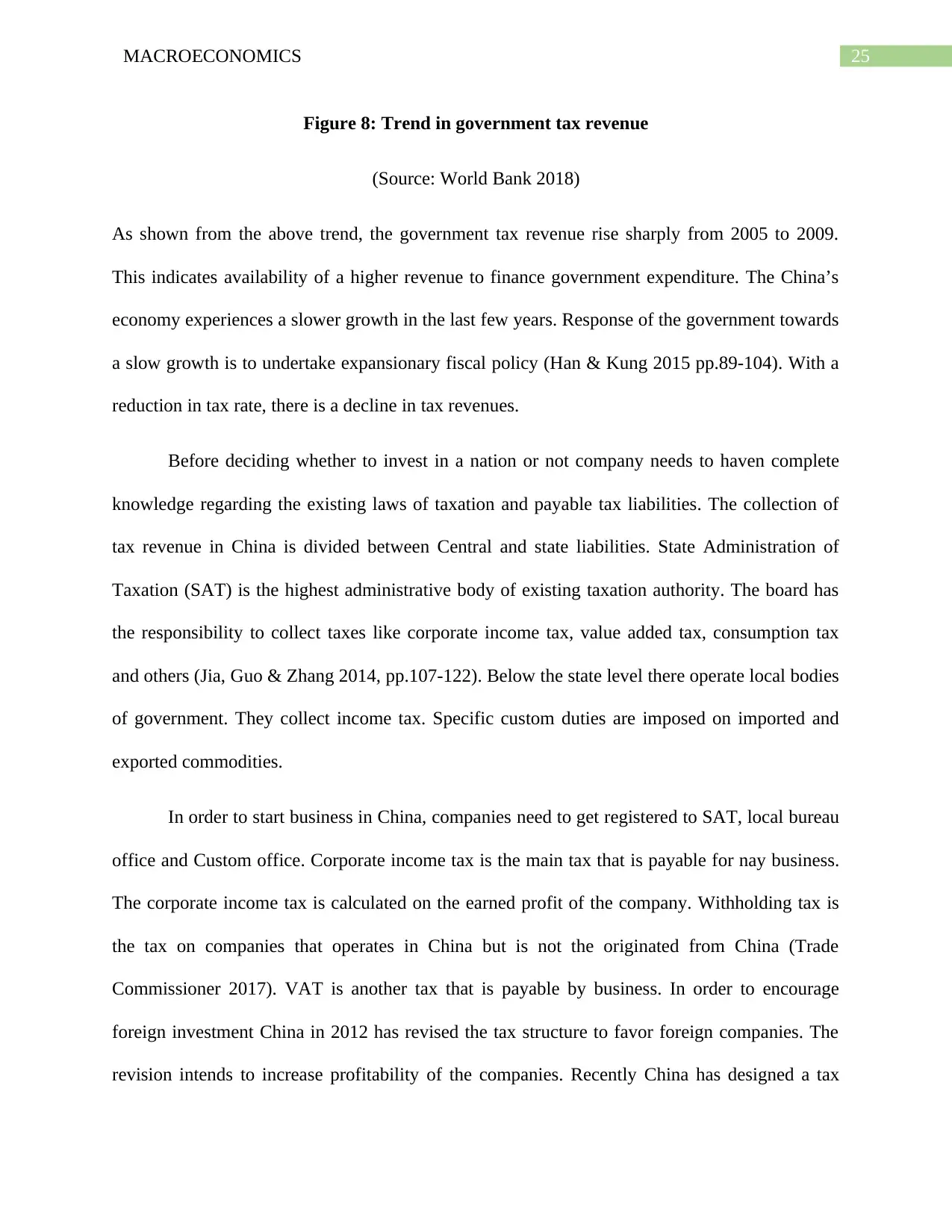
25MACROECONOMICS
Figure 8: Trend in government tax revenue
(Source: World Bank 2018)
As shown from the above trend, the government tax revenue rise sharply from 2005 to 2009.
This indicates availability of a higher revenue to finance government expenditure. The China’s
economy experiences a slower growth in the last few years. Response of the government towards
a slow growth is to undertake expansionary fiscal policy (Han & Kung 2015 pp.89-104). With a
reduction in tax rate, there is a decline in tax revenues.
Before deciding whether to invest in a nation or not company needs to haven complete
knowledge regarding the existing laws of taxation and payable tax liabilities. The collection of
tax revenue in China is divided between Central and state liabilities. State Administration of
Taxation (SAT) is the highest administrative body of existing taxation authority. The board has
the responsibility to collect taxes like corporate income tax, value added tax, consumption tax
and others (Jia, Guo & Zhang 2014, pp.107-122). Below the state level there operate local bodies
of government. They collect income tax. Specific custom duties are imposed on imported and
exported commodities.
In order to start business in China, companies need to get registered to SAT, local bureau
office and Custom office. Corporate income tax is the main tax that is payable for nay business.
The corporate income tax is calculated on the earned profit of the company. Withholding tax is
the tax on companies that operates in China but is not the originated from China (Trade
Commissioner 2017). VAT is another tax that is payable by business. In order to encourage
foreign investment China in 2012 has revised the tax structure to favor foreign companies. The
revision intends to increase profitability of the companies. Recently China has designed a tax
Figure 8: Trend in government tax revenue
(Source: World Bank 2018)
As shown from the above trend, the government tax revenue rise sharply from 2005 to 2009.
This indicates availability of a higher revenue to finance government expenditure. The China’s
economy experiences a slower growth in the last few years. Response of the government towards
a slow growth is to undertake expansionary fiscal policy (Han & Kung 2015 pp.89-104). With a
reduction in tax rate, there is a decline in tax revenues.
Before deciding whether to invest in a nation or not company needs to haven complete
knowledge regarding the existing laws of taxation and payable tax liabilities. The collection of
tax revenue in China is divided between Central and state liabilities. State Administration of
Taxation (SAT) is the highest administrative body of existing taxation authority. The board has
the responsibility to collect taxes like corporate income tax, value added tax, consumption tax
and others (Jia, Guo & Zhang 2014, pp.107-122). Below the state level there operate local bodies
of government. They collect income tax. Specific custom duties are imposed on imported and
exported commodities.
In order to start business in China, companies need to get registered to SAT, local bureau
office and Custom office. Corporate income tax is the main tax that is payable for nay business.
The corporate income tax is calculated on the earned profit of the company. Withholding tax is
the tax on companies that operates in China but is not the originated from China (Trade
Commissioner 2017). VAT is another tax that is payable by business. In order to encourage
foreign investment China in 2012 has revised the tax structure to favor foreign companies. The
revision intends to increase profitability of the companies. Recently China has designed a tax
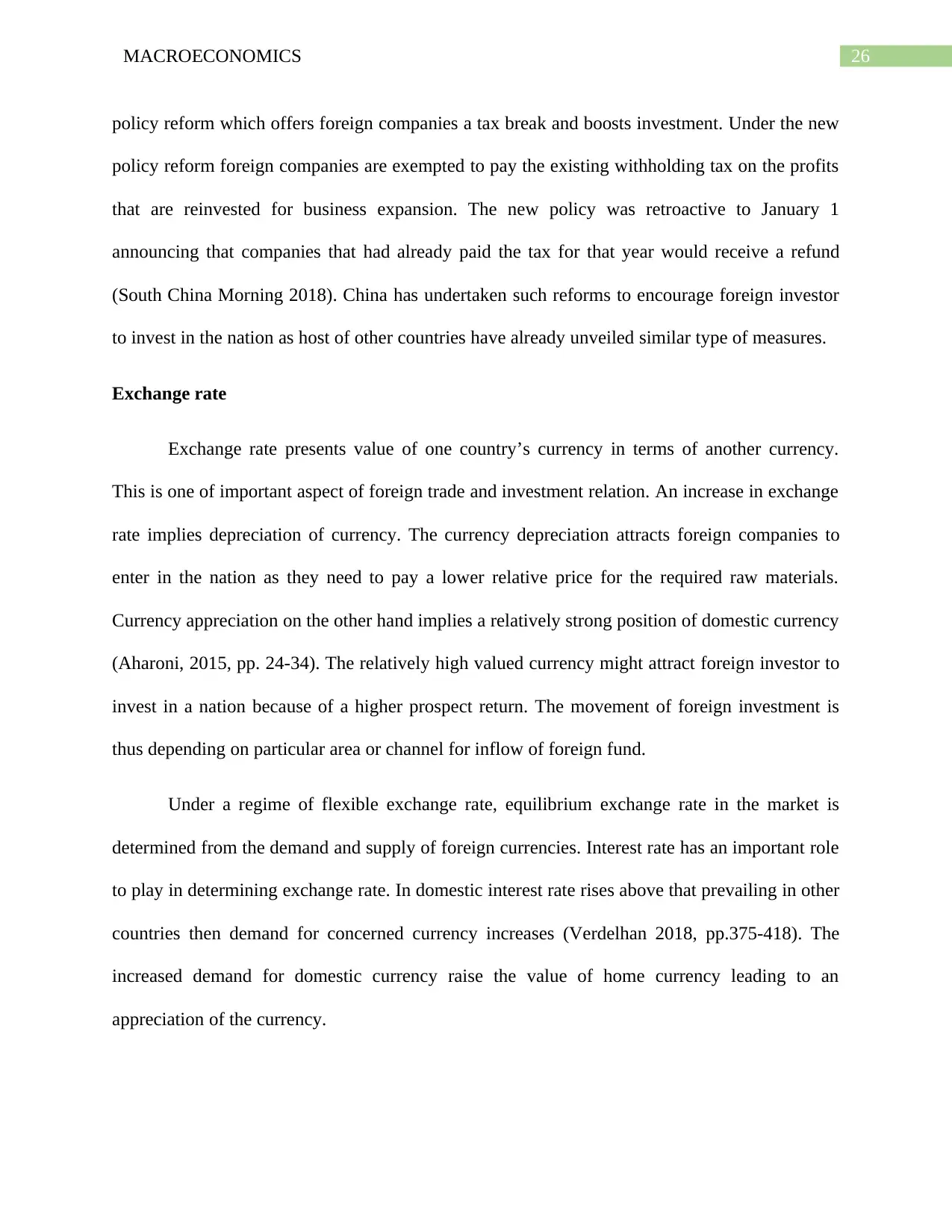
26MACROECONOMICS
policy reform which offers foreign companies a tax break and boosts investment. Under the new
policy reform foreign companies are exempted to pay the existing withholding tax on the profits
that are reinvested for business expansion. The new policy was retroactive to January 1
announcing that companies that had already paid the tax for that year would receive a refund
(South China Morning 2018). China has undertaken such reforms to encourage foreign investor
to invest in the nation as host of other countries have already unveiled similar type of measures.
Exchange rate
Exchange rate presents value of one country’s currency in terms of another currency.
This is one of important aspect of foreign trade and investment relation. An increase in exchange
rate implies depreciation of currency. The currency depreciation attracts foreign companies to
enter in the nation as they need to pay a lower relative price for the required raw materials.
Currency appreciation on the other hand implies a relatively strong position of domestic currency
(Aharoni, 2015, pp. 24-34). The relatively high valued currency might attract foreign investor to
invest in a nation because of a higher prospect return. The movement of foreign investment is
thus depending on particular area or channel for inflow of foreign fund.
Under a regime of flexible exchange rate, equilibrium exchange rate in the market is
determined from the demand and supply of foreign currencies. Interest rate has an important role
to play in determining exchange rate. In domestic interest rate rises above that prevailing in other
countries then demand for concerned currency increases (Verdelhan 2018, pp.375-418). The
increased demand for domestic currency raise the value of home currency leading to an
appreciation of the currency.
policy reform which offers foreign companies a tax break and boosts investment. Under the new
policy reform foreign companies are exempted to pay the existing withholding tax on the profits
that are reinvested for business expansion. The new policy was retroactive to January 1
announcing that companies that had already paid the tax for that year would receive a refund
(South China Morning 2018). China has undertaken such reforms to encourage foreign investor
to invest in the nation as host of other countries have already unveiled similar type of measures.
Exchange rate
Exchange rate presents value of one country’s currency in terms of another currency.
This is one of important aspect of foreign trade and investment relation. An increase in exchange
rate implies depreciation of currency. The currency depreciation attracts foreign companies to
enter in the nation as they need to pay a lower relative price for the required raw materials.
Currency appreciation on the other hand implies a relatively strong position of domestic currency
(Aharoni, 2015, pp. 24-34). The relatively high valued currency might attract foreign investor to
invest in a nation because of a higher prospect return. The movement of foreign investment is
thus depending on particular area or channel for inflow of foreign fund.
Under a regime of flexible exchange rate, equilibrium exchange rate in the market is
determined from the demand and supply of foreign currencies. Interest rate has an important role
to play in determining exchange rate. In domestic interest rate rises above that prevailing in other
countries then demand for concerned currency increases (Verdelhan 2018, pp.375-418). The
increased demand for domestic currency raise the value of home currency leading to an
appreciation of the currency.
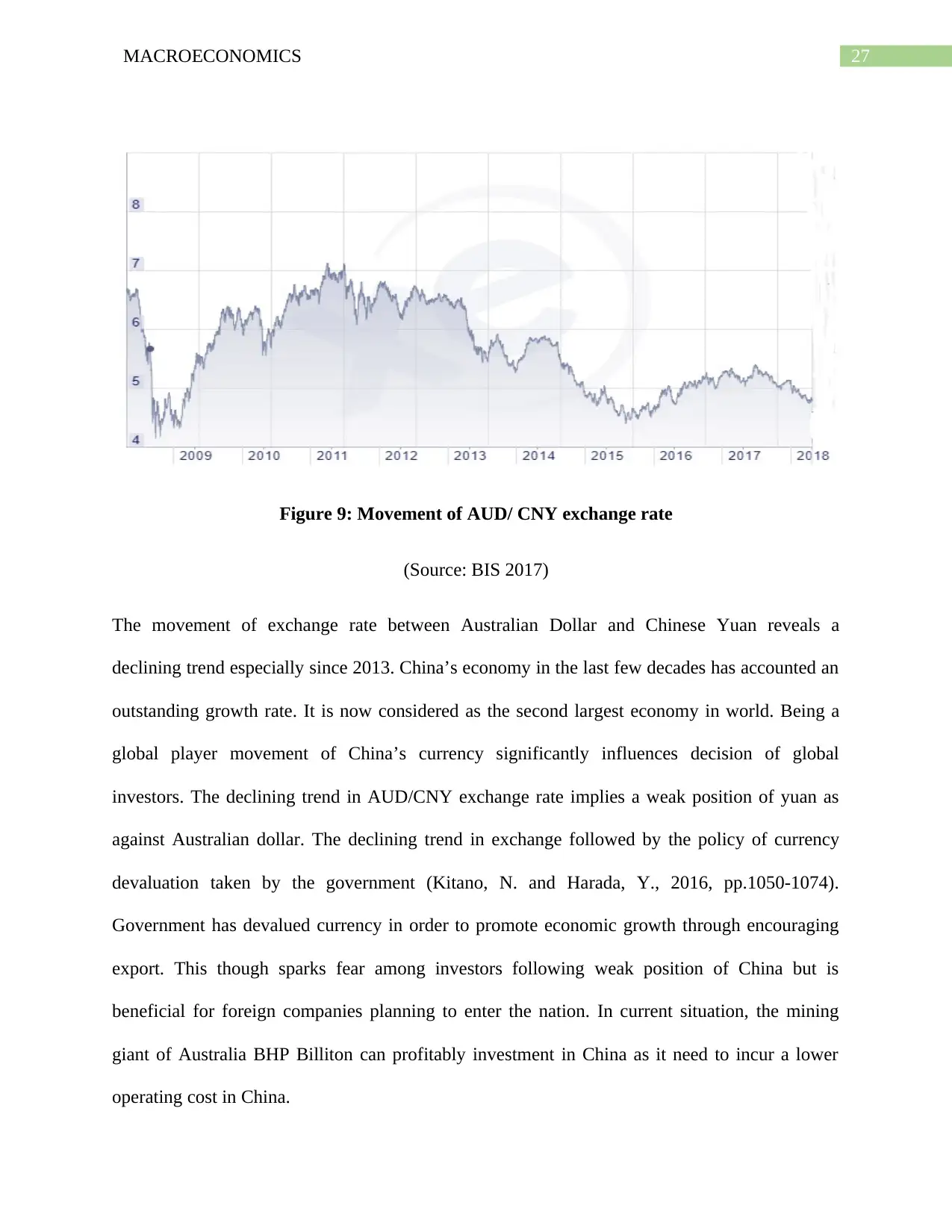
27MACROECONOMICS
Figure 9: Movement of AUD/ CNY exchange rate
(Source: BIS 2017)
The movement of exchange rate between Australian Dollar and Chinese Yuan reveals a
declining trend especially since 2013. China’s economy in the last few decades has accounted an
outstanding growth rate. It is now considered as the second largest economy in world. Being a
global player movement of China’s currency significantly influences decision of global
investors. The declining trend in AUD/CNY exchange rate implies a weak position of yuan as
against Australian dollar. The declining trend in exchange followed by the policy of currency
devaluation taken by the government (Kitano, N. and Harada, Y., 2016, pp.1050-1074).
Government has devalued currency in order to promote economic growth through encouraging
export. This though sparks fear among investors following weak position of China but is
beneficial for foreign companies planning to enter the nation. In current situation, the mining
giant of Australia BHP Billiton can profitably investment in China as it need to incur a lower
operating cost in China.
Figure 9: Movement of AUD/ CNY exchange rate
(Source: BIS 2017)
The movement of exchange rate between Australian Dollar and Chinese Yuan reveals a
declining trend especially since 2013. China’s economy in the last few decades has accounted an
outstanding growth rate. It is now considered as the second largest economy in world. Being a
global player movement of China’s currency significantly influences decision of global
investors. The declining trend in AUD/CNY exchange rate implies a weak position of yuan as
against Australian dollar. The declining trend in exchange followed by the policy of currency
devaluation taken by the government (Kitano, N. and Harada, Y., 2016, pp.1050-1074).
Government has devalued currency in order to promote economic growth through encouraging
export. This though sparks fear among investors following weak position of China but is
beneficial for foreign companies planning to enter the nation. In current situation, the mining
giant of Australia BHP Billiton can profitably investment in China as it need to incur a lower
operating cost in China.
Secure Best Marks with AI Grader
Need help grading? Try our AI Grader for instant feedback on your assignments.
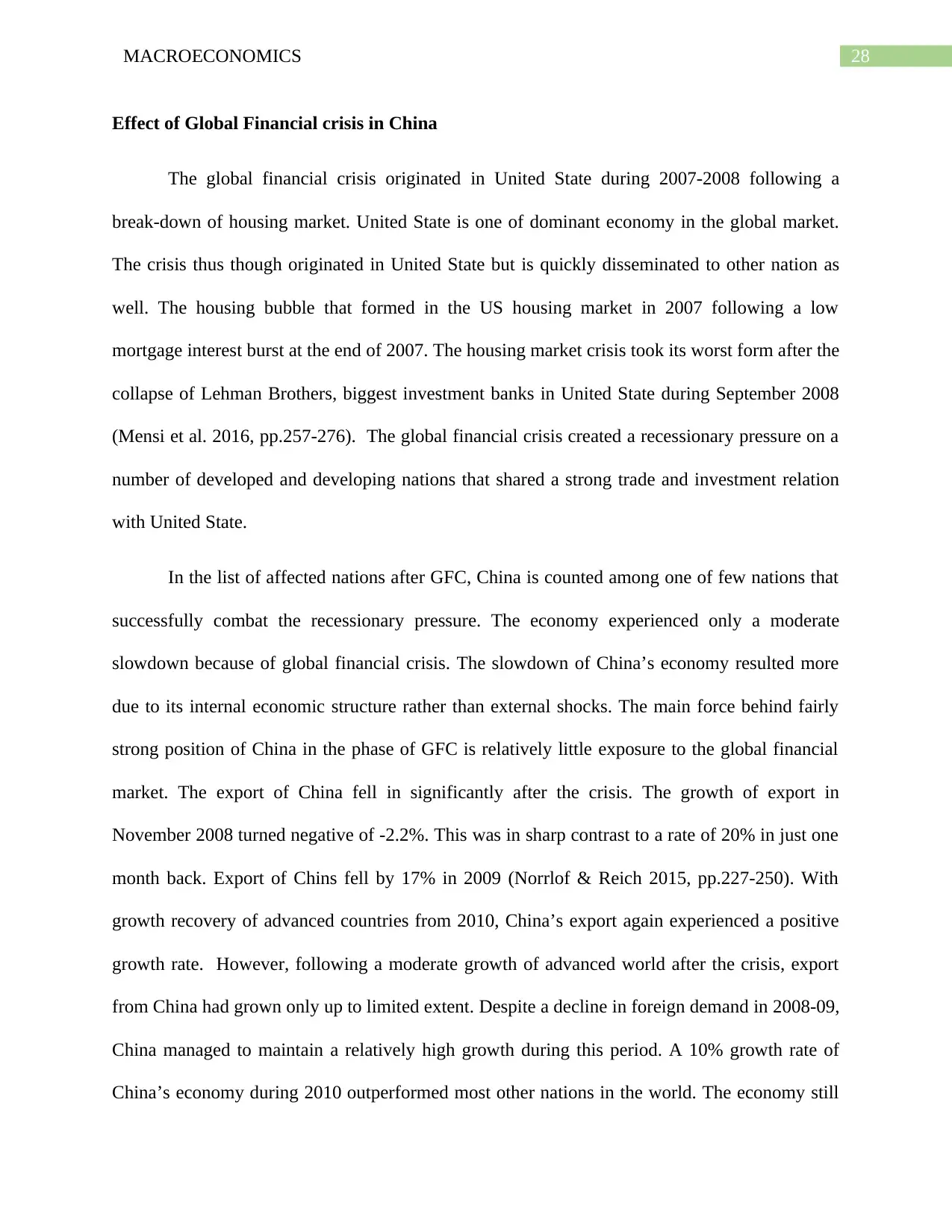
28MACROECONOMICS
Effect of Global Financial crisis in China
The global financial crisis originated in United State during 2007-2008 following a
break-down of housing market. United State is one of dominant economy in the global market.
The crisis thus though originated in United State but is quickly disseminated to other nation as
well. The housing bubble that formed in the US housing market in 2007 following a low
mortgage interest burst at the end of 2007. The housing market crisis took its worst form after the
collapse of Lehman Brothers, biggest investment banks in United State during September 2008
(Mensi et al. 2016, pp.257-276). The global financial crisis created a recessionary pressure on a
number of developed and developing nations that shared a strong trade and investment relation
with United State.
In the list of affected nations after GFC, China is counted among one of few nations that
successfully combat the recessionary pressure. The economy experienced only a moderate
slowdown because of global financial crisis. The slowdown of China’s economy resulted more
due to its internal economic structure rather than external shocks. The main force behind fairly
strong position of China in the phase of GFC is relatively little exposure to the global financial
market. The export of China fell in significantly after the crisis. The growth of export in
November 2008 turned negative of -2.2%. This was in sharp contrast to a rate of 20% in just one
month back. Export of Chins fell by 17% in 2009 (Norrlof & Reich 2015, pp.227-250). With
growth recovery of advanced countries from 2010, China’s export again experienced a positive
growth rate. However, following a moderate growth of advanced world after the crisis, export
from China had grown only up to limited extent. Despite a decline in foreign demand in 2008-09,
China managed to maintain a relatively high growth during this period. A 10% growth rate of
China’s economy during 2010 outperformed most other nations in the world. The economy still
Effect of Global Financial crisis in China
The global financial crisis originated in United State during 2007-2008 following a
break-down of housing market. United State is one of dominant economy in the global market.
The crisis thus though originated in United State but is quickly disseminated to other nation as
well. The housing bubble that formed in the US housing market in 2007 following a low
mortgage interest burst at the end of 2007. The housing market crisis took its worst form after the
collapse of Lehman Brothers, biggest investment banks in United State during September 2008
(Mensi et al. 2016, pp.257-276). The global financial crisis created a recessionary pressure on a
number of developed and developing nations that shared a strong trade and investment relation
with United State.
In the list of affected nations after GFC, China is counted among one of few nations that
successfully combat the recessionary pressure. The economy experienced only a moderate
slowdown because of global financial crisis. The slowdown of China’s economy resulted more
due to its internal economic structure rather than external shocks. The main force behind fairly
strong position of China in the phase of GFC is relatively little exposure to the global financial
market. The export of China fell in significantly after the crisis. The growth of export in
November 2008 turned negative of -2.2%. This was in sharp contrast to a rate of 20% in just one
month back. Export of Chins fell by 17% in 2009 (Norrlof & Reich 2015, pp.227-250). With
growth recovery of advanced countries from 2010, China’s export again experienced a positive
growth rate. However, following a moderate growth of advanced world after the crisis, export
from China had grown only up to limited extent. Despite a decline in foreign demand in 2008-09,
China managed to maintain a relatively high growth during this period. A 10% growth rate of
China’s economy during 2010 outperformed most other nations in the world. The economy still
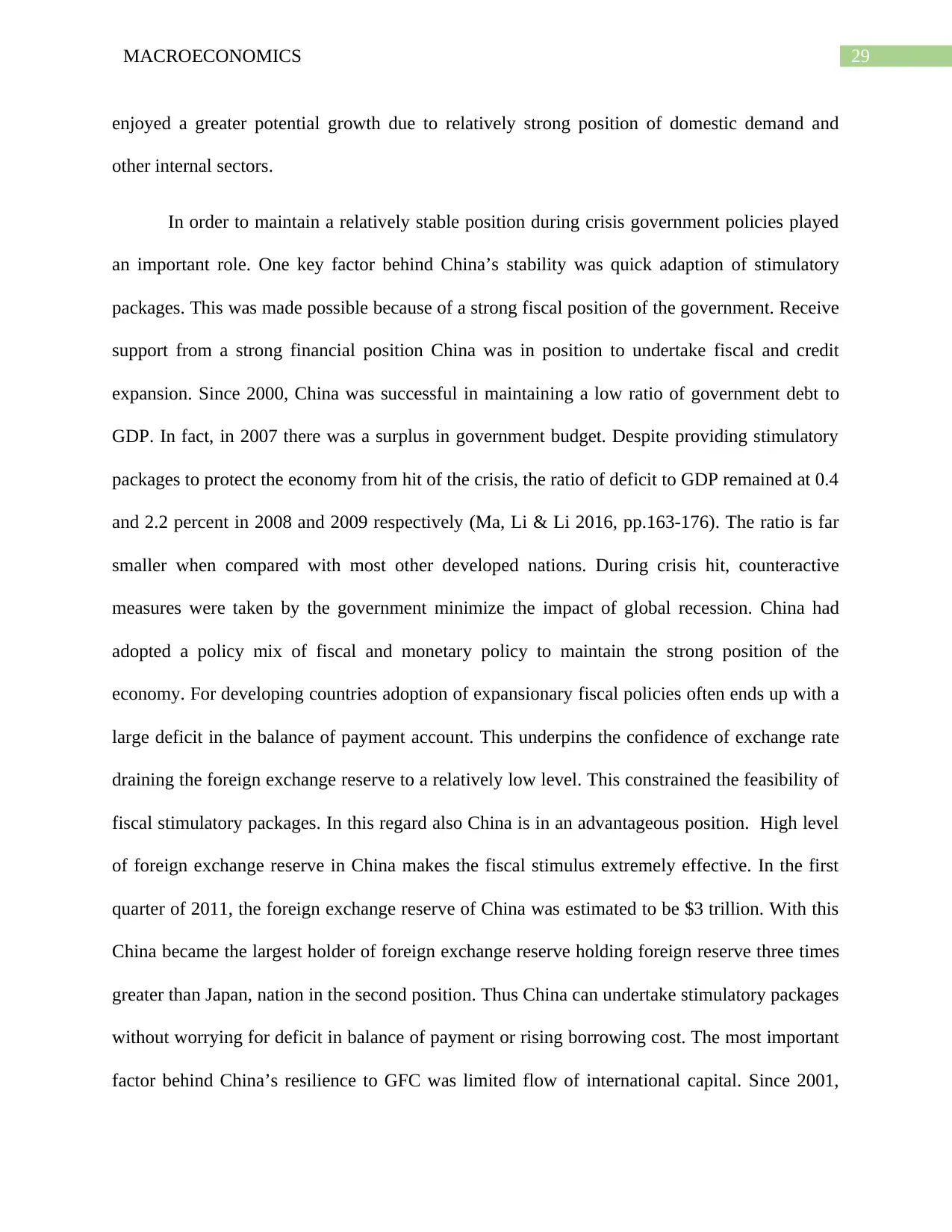
29MACROECONOMICS
enjoyed a greater potential growth due to relatively strong position of domestic demand and
other internal sectors.
In order to maintain a relatively stable position during crisis government policies played
an important role. One key factor behind China’s stability was quick adaption of stimulatory
packages. This was made possible because of a strong fiscal position of the government. Receive
support from a strong financial position China was in position to undertake fiscal and credit
expansion. Since 2000, China was successful in maintaining a low ratio of government debt to
GDP. In fact, in 2007 there was a surplus in government budget. Despite providing stimulatory
packages to protect the economy from hit of the crisis, the ratio of deficit to GDP remained at 0.4
and 2.2 percent in 2008 and 2009 respectively (Ma, Li & Li 2016, pp.163-176). The ratio is far
smaller when compared with most other developed nations. During crisis hit, counteractive
measures were taken by the government minimize the impact of global recession. China had
adopted a policy mix of fiscal and monetary policy to maintain the strong position of the
economy. For developing countries adoption of expansionary fiscal policies often ends up with a
large deficit in the balance of payment account. This underpins the confidence of exchange rate
draining the foreign exchange reserve to a relatively low level. This constrained the feasibility of
fiscal stimulatory packages. In this regard also China is in an advantageous position. High level
of foreign exchange reserve in China makes the fiscal stimulus extremely effective. In the first
quarter of 2011, the foreign exchange reserve of China was estimated to be $3 trillion. With this
China became the largest holder of foreign exchange reserve holding foreign reserve three times
greater than Japan, nation in the second position. Thus China can undertake stimulatory packages
without worrying for deficit in balance of payment or rising borrowing cost. The most important
factor behind China’s resilience to GFC was limited flow of international capital. Since 2001,
enjoyed a greater potential growth due to relatively strong position of domestic demand and
other internal sectors.
In order to maintain a relatively stable position during crisis government policies played
an important role. One key factor behind China’s stability was quick adaption of stimulatory
packages. This was made possible because of a strong fiscal position of the government. Receive
support from a strong financial position China was in position to undertake fiscal and credit
expansion. Since 2000, China was successful in maintaining a low ratio of government debt to
GDP. In fact, in 2007 there was a surplus in government budget. Despite providing stimulatory
packages to protect the economy from hit of the crisis, the ratio of deficit to GDP remained at 0.4
and 2.2 percent in 2008 and 2009 respectively (Ma, Li & Li 2016, pp.163-176). The ratio is far
smaller when compared with most other developed nations. During crisis hit, counteractive
measures were taken by the government minimize the impact of global recession. China had
adopted a policy mix of fiscal and monetary policy to maintain the strong position of the
economy. For developing countries adoption of expansionary fiscal policies often ends up with a
large deficit in the balance of payment account. This underpins the confidence of exchange rate
draining the foreign exchange reserve to a relatively low level. This constrained the feasibility of
fiscal stimulatory packages. In this regard also China is in an advantageous position. High level
of foreign exchange reserve in China makes the fiscal stimulus extremely effective. In the first
quarter of 2011, the foreign exchange reserve of China was estimated to be $3 trillion. With this
China became the largest holder of foreign exchange reserve holding foreign reserve three times
greater than Japan, nation in the second position. Thus China can undertake stimulatory packages
without worrying for deficit in balance of payment or rising borrowing cost. The most important
factor behind China’s resilience to GFC was limited flow of international capital. Since 2001,
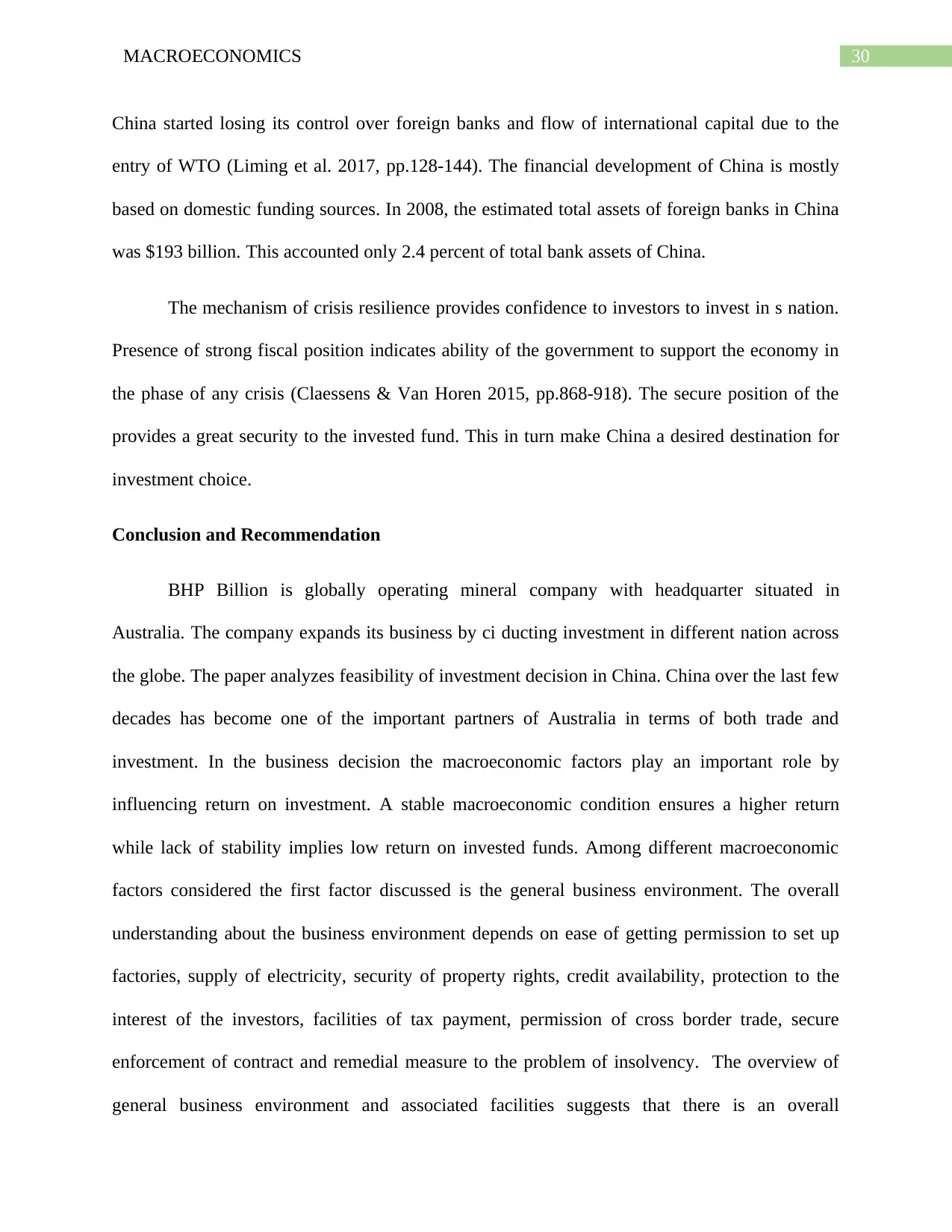
30MACROECONOMICS
China started losing its control over foreign banks and flow of international capital due to the
entry of WTO (Liming et al. 2017, pp.128-144). The financial development of China is mostly
based on domestic funding sources. In 2008, the estimated total assets of foreign banks in China
was $193 billion. This accounted only 2.4 percent of total bank assets of China.
The mechanism of crisis resilience provides confidence to investors to invest in s nation.
Presence of strong fiscal position indicates ability of the government to support the economy in
the phase of any crisis (Claessens & Van Horen 2015, pp.868-918). The secure position of the
provides a great security to the invested fund. This in turn make China a desired destination for
investment choice.
Conclusion and Recommendation
BHP Billion is globally operating mineral company with headquarter situated in
Australia. The company expands its business by ci ducting investment in different nation across
the globe. The paper analyzes feasibility of investment decision in China. China over the last few
decades has become one of the important partners of Australia in terms of both trade and
investment. In the business decision the macroeconomic factors play an important role by
influencing return on investment. A stable macroeconomic condition ensures a higher return
while lack of stability implies low return on invested funds. Among different macroeconomic
factors considered the first factor discussed is the general business environment. The overall
understanding about the business environment depends on ease of getting permission to set up
factories, supply of electricity, security of property rights, credit availability, protection to the
interest of the investors, facilities of tax payment, permission of cross border trade, secure
enforcement of contract and remedial measure to the problem of insolvency. The overview of
general business environment and associated facilities suggests that there is an overall
China started losing its control over foreign banks and flow of international capital due to the
entry of WTO (Liming et al. 2017, pp.128-144). The financial development of China is mostly
based on domestic funding sources. In 2008, the estimated total assets of foreign banks in China
was $193 billion. This accounted only 2.4 percent of total bank assets of China.
The mechanism of crisis resilience provides confidence to investors to invest in s nation.
Presence of strong fiscal position indicates ability of the government to support the economy in
the phase of any crisis (Claessens & Van Horen 2015, pp.868-918). The secure position of the
provides a great security to the invested fund. This in turn make China a desired destination for
investment choice.
Conclusion and Recommendation
BHP Billion is globally operating mineral company with headquarter situated in
Australia. The company expands its business by ci ducting investment in different nation across
the globe. The paper analyzes feasibility of investment decision in China. China over the last few
decades has become one of the important partners of Australia in terms of both trade and
investment. In the business decision the macroeconomic factors play an important role by
influencing return on investment. A stable macroeconomic condition ensures a higher return
while lack of stability implies low return on invested funds. Among different macroeconomic
factors considered the first factor discussed is the general business environment. The overall
understanding about the business environment depends on ease of getting permission to set up
factories, supply of electricity, security of property rights, credit availability, protection to the
interest of the investors, facilities of tax payment, permission of cross border trade, secure
enforcement of contract and remedial measure to the problem of insolvency. The overview of
general business environment and associated facilities suggests that there is an overall
Paraphrase This Document
Need a fresh take? Get an instant paraphrase of this document with our AI Paraphraser
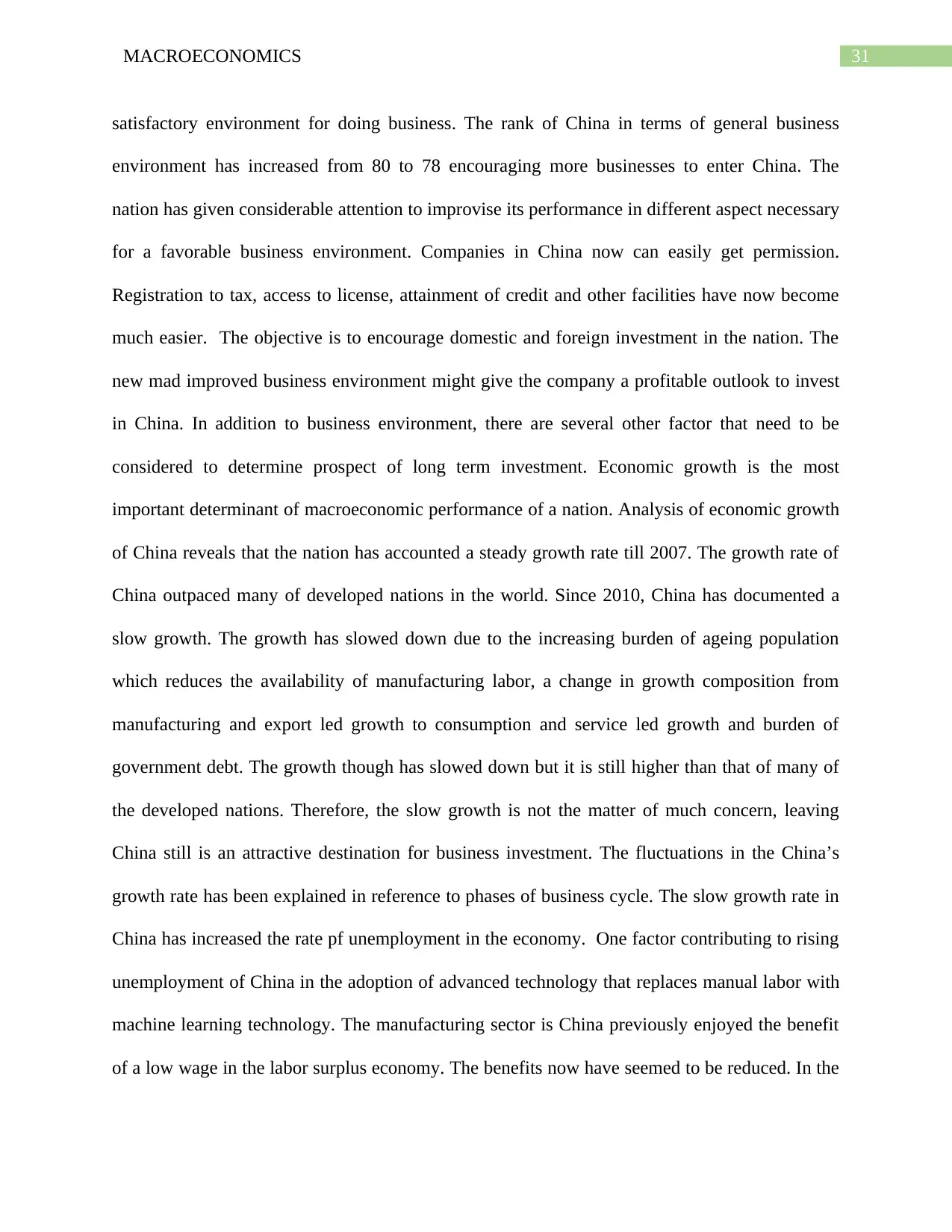
31MACROECONOMICS
satisfactory environment for doing business. The rank of China in terms of general business
environment has increased from 80 to 78 encouraging more businesses to enter China. The
nation has given considerable attention to improvise its performance in different aspect necessary
for a favorable business environment. Companies in China now can easily get permission.
Registration to tax, access to license, attainment of credit and other facilities have now become
much easier. The objective is to encourage domestic and foreign investment in the nation. The
new mad improved business environment might give the company a profitable outlook to invest
in China. In addition to business environment, there are several other factor that need to be
considered to determine prospect of long term investment. Economic growth is the most
important determinant of macroeconomic performance of a nation. Analysis of economic growth
of China reveals that the nation has accounted a steady growth rate till 2007. The growth rate of
China outpaced many of developed nations in the world. Since 2010, China has documented a
slow growth. The growth has slowed down due to the increasing burden of ageing population
which reduces the availability of manufacturing labor, a change in growth composition from
manufacturing and export led growth to consumption and service led growth and burden of
government debt. The growth though has slowed down but it is still higher than that of many of
the developed nations. Therefore, the slow growth is not the matter of much concern, leaving
China still is an attractive destination for business investment. The fluctuations in the China’s
growth rate has been explained in reference to phases of business cycle. The slow growth rate in
China has increased the rate pf unemployment in the economy. One factor contributing to rising
unemployment of China in the adoption of advanced technology that replaces manual labor with
machine learning technology. The manufacturing sector is China previously enjoyed the benefit
of a low wage in the labor surplus economy. The benefits now have seemed to be reduced. In the
satisfactory environment for doing business. The rank of China in terms of general business
environment has increased from 80 to 78 encouraging more businesses to enter China. The
nation has given considerable attention to improvise its performance in different aspect necessary
for a favorable business environment. Companies in China now can easily get permission.
Registration to tax, access to license, attainment of credit and other facilities have now become
much easier. The objective is to encourage domestic and foreign investment in the nation. The
new mad improved business environment might give the company a profitable outlook to invest
in China. In addition to business environment, there are several other factor that need to be
considered to determine prospect of long term investment. Economic growth is the most
important determinant of macroeconomic performance of a nation. Analysis of economic growth
of China reveals that the nation has accounted a steady growth rate till 2007. The growth rate of
China outpaced many of developed nations in the world. Since 2010, China has documented a
slow growth. The growth has slowed down due to the increasing burden of ageing population
which reduces the availability of manufacturing labor, a change in growth composition from
manufacturing and export led growth to consumption and service led growth and burden of
government debt. The growth though has slowed down but it is still higher than that of many of
the developed nations. Therefore, the slow growth is not the matter of much concern, leaving
China still is an attractive destination for business investment. The fluctuations in the China’s
growth rate has been explained in reference to phases of business cycle. The slow growth rate in
China has increased the rate pf unemployment in the economy. One factor contributing to rising
unemployment of China in the adoption of advanced technology that replaces manual labor with
machine learning technology. The manufacturing sector is China previously enjoyed the benefit
of a low wage in the labor surplus economy. The benefits now have seemed to be reduced. In the
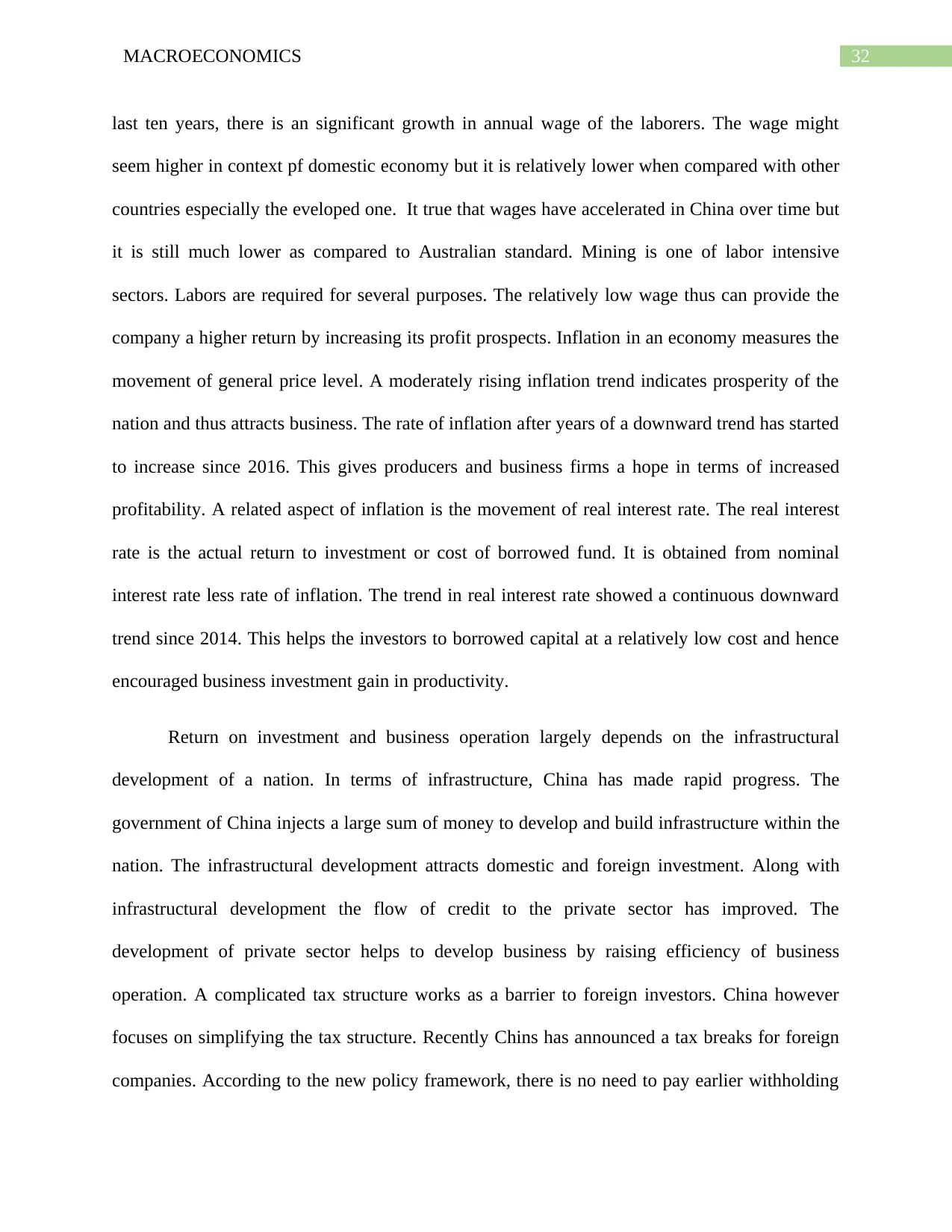
32MACROECONOMICS
last ten years, there is an significant growth in annual wage of the laborers. The wage might
seem higher in context pf domestic economy but it is relatively lower when compared with other
countries especially the eveloped one. It true that wages have accelerated in China over time but
it is still much lower as compared to Australian standard. Mining is one of labor intensive
sectors. Labors are required for several purposes. The relatively low wage thus can provide the
company a higher return by increasing its profit prospects. Inflation in an economy measures the
movement of general price level. A moderately rising inflation trend indicates prosperity of the
nation and thus attracts business. The rate of inflation after years of a downward trend has started
to increase since 2016. This gives producers and business firms a hope in terms of increased
profitability. A related aspect of inflation is the movement of real interest rate. The real interest
rate is the actual return to investment or cost of borrowed fund. It is obtained from nominal
interest rate less rate of inflation. The trend in real interest rate showed a continuous downward
trend since 2014. This helps the investors to borrowed capital at a relatively low cost and hence
encouraged business investment gain in productivity.
Return on investment and business operation largely depends on the infrastructural
development of a nation. In terms of infrastructure, China has made rapid progress. The
government of China injects a large sum of money to develop and build infrastructure within the
nation. The infrastructural development attracts domestic and foreign investment. Along with
infrastructural development the flow of credit to the private sector has improved. The
development of private sector helps to develop business by raising efficiency of business
operation. A complicated tax structure works as a barrier to foreign investors. China however
focuses on simplifying the tax structure. Recently Chins has announced a tax breaks for foreign
companies. According to the new policy framework, there is no need to pay earlier withholding
last ten years, there is an significant growth in annual wage of the laborers. The wage might
seem higher in context pf domestic economy but it is relatively lower when compared with other
countries especially the eveloped one. It true that wages have accelerated in China over time but
it is still much lower as compared to Australian standard. Mining is one of labor intensive
sectors. Labors are required for several purposes. The relatively low wage thus can provide the
company a higher return by increasing its profit prospects. Inflation in an economy measures the
movement of general price level. A moderately rising inflation trend indicates prosperity of the
nation and thus attracts business. The rate of inflation after years of a downward trend has started
to increase since 2016. This gives producers and business firms a hope in terms of increased
profitability. A related aspect of inflation is the movement of real interest rate. The real interest
rate is the actual return to investment or cost of borrowed fund. It is obtained from nominal
interest rate less rate of inflation. The trend in real interest rate showed a continuous downward
trend since 2014. This helps the investors to borrowed capital at a relatively low cost and hence
encouraged business investment gain in productivity.
Return on investment and business operation largely depends on the infrastructural
development of a nation. In terms of infrastructure, China has made rapid progress. The
government of China injects a large sum of money to develop and build infrastructure within the
nation. The infrastructural development attracts domestic and foreign investment. Along with
infrastructural development the flow of credit to the private sector has improved. The
development of private sector helps to develop business by raising efficiency of business
operation. A complicated tax structure works as a barrier to foreign investors. China however
focuses on simplifying the tax structure. Recently Chins has announced a tax breaks for foreign
companies. According to the new policy framework, there is no need to pay earlier withholding
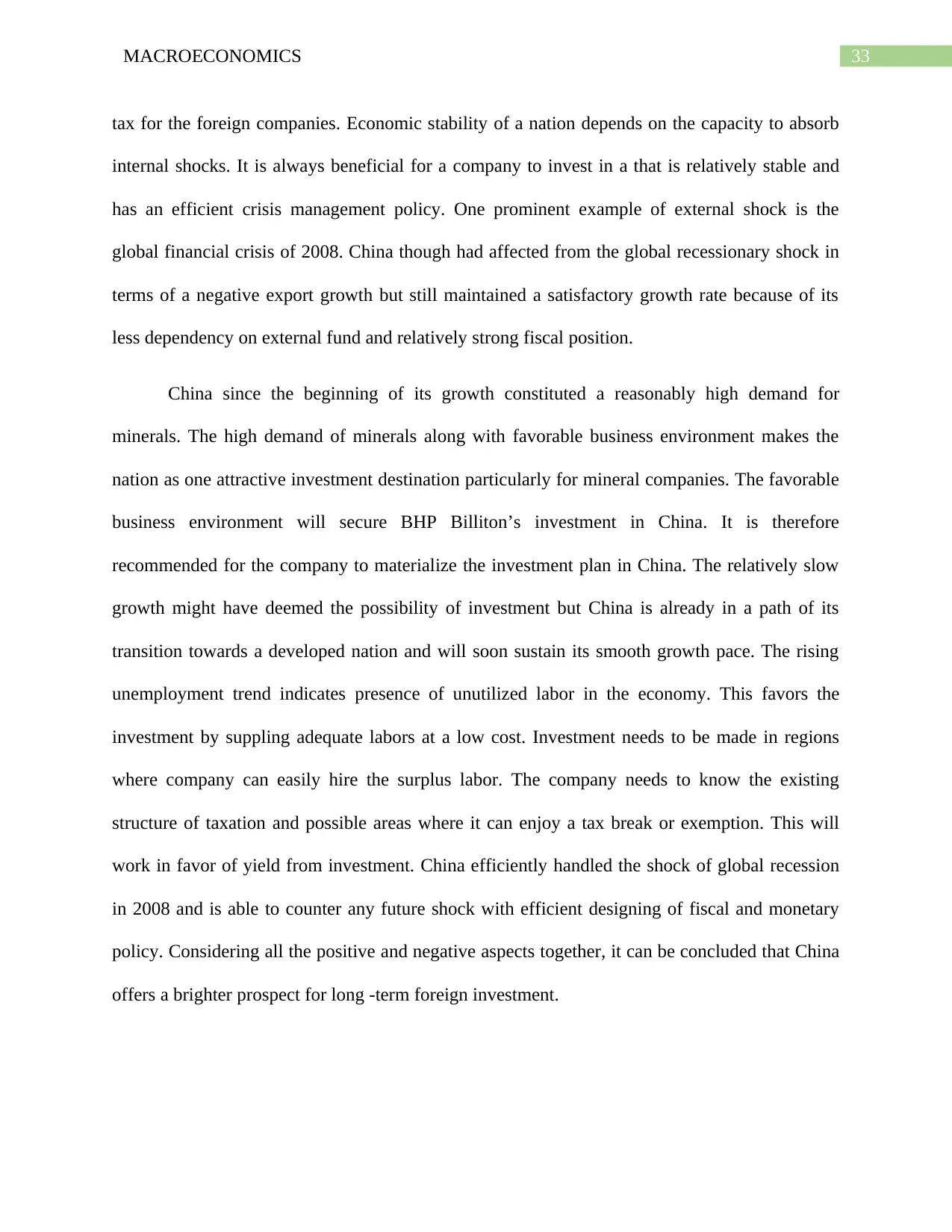
33MACROECONOMICS
tax for the foreign companies. Economic stability of a nation depends on the capacity to absorb
internal shocks. It is always beneficial for a company to invest in a that is relatively stable and
has an efficient crisis management policy. One prominent example of external shock is the
global financial crisis of 2008. China though had affected from the global recessionary shock in
terms of a negative export growth but still maintained a satisfactory growth rate because of its
less dependency on external fund and relatively strong fiscal position.
China since the beginning of its growth constituted a reasonably high demand for
minerals. The high demand of minerals along with favorable business environment makes the
nation as one attractive investment destination particularly for mineral companies. The favorable
business environment will secure BHP Billiton’s investment in China. It is therefore
recommended for the company to materialize the investment plan in China. The relatively slow
growth might have deemed the possibility of investment but China is already in a path of its
transition towards a developed nation and will soon sustain its smooth growth pace. The rising
unemployment trend indicates presence of unutilized labor in the economy. This favors the
investment by suppling adequate labors at a low cost. Investment needs to be made in regions
where company can easily hire the surplus labor. The company needs to know the existing
structure of taxation and possible areas where it can enjoy a tax break or exemption. This will
work in favor of yield from investment. China efficiently handled the shock of global recession
in 2008 and is able to counter any future shock with efficient designing of fiscal and monetary
policy. Considering all the positive and negative aspects together, it can be concluded that China
offers a brighter prospect for long -term foreign investment.
tax for the foreign companies. Economic stability of a nation depends on the capacity to absorb
internal shocks. It is always beneficial for a company to invest in a that is relatively stable and
has an efficient crisis management policy. One prominent example of external shock is the
global financial crisis of 2008. China though had affected from the global recessionary shock in
terms of a negative export growth but still maintained a satisfactory growth rate because of its
less dependency on external fund and relatively strong fiscal position.
China since the beginning of its growth constituted a reasonably high demand for
minerals. The high demand of minerals along with favorable business environment makes the
nation as one attractive investment destination particularly for mineral companies. The favorable
business environment will secure BHP Billiton’s investment in China. It is therefore
recommended for the company to materialize the investment plan in China. The relatively slow
growth might have deemed the possibility of investment but China is already in a path of its
transition towards a developed nation and will soon sustain its smooth growth pace. The rising
unemployment trend indicates presence of unutilized labor in the economy. This favors the
investment by suppling adequate labors at a low cost. Investment needs to be made in regions
where company can easily hire the surplus labor. The company needs to know the existing
structure of taxation and possible areas where it can enjoy a tax break or exemption. This will
work in favor of yield from investment. China efficiently handled the shock of global recession
in 2008 and is able to counter any future shock with efficient designing of fiscal and monetary
policy. Considering all the positive and negative aspects together, it can be concluded that China
offers a brighter prospect for long -term foreign investment.
Secure Best Marks with AI Grader
Need help grading? Try our AI Grader for instant feedback on your assignments.
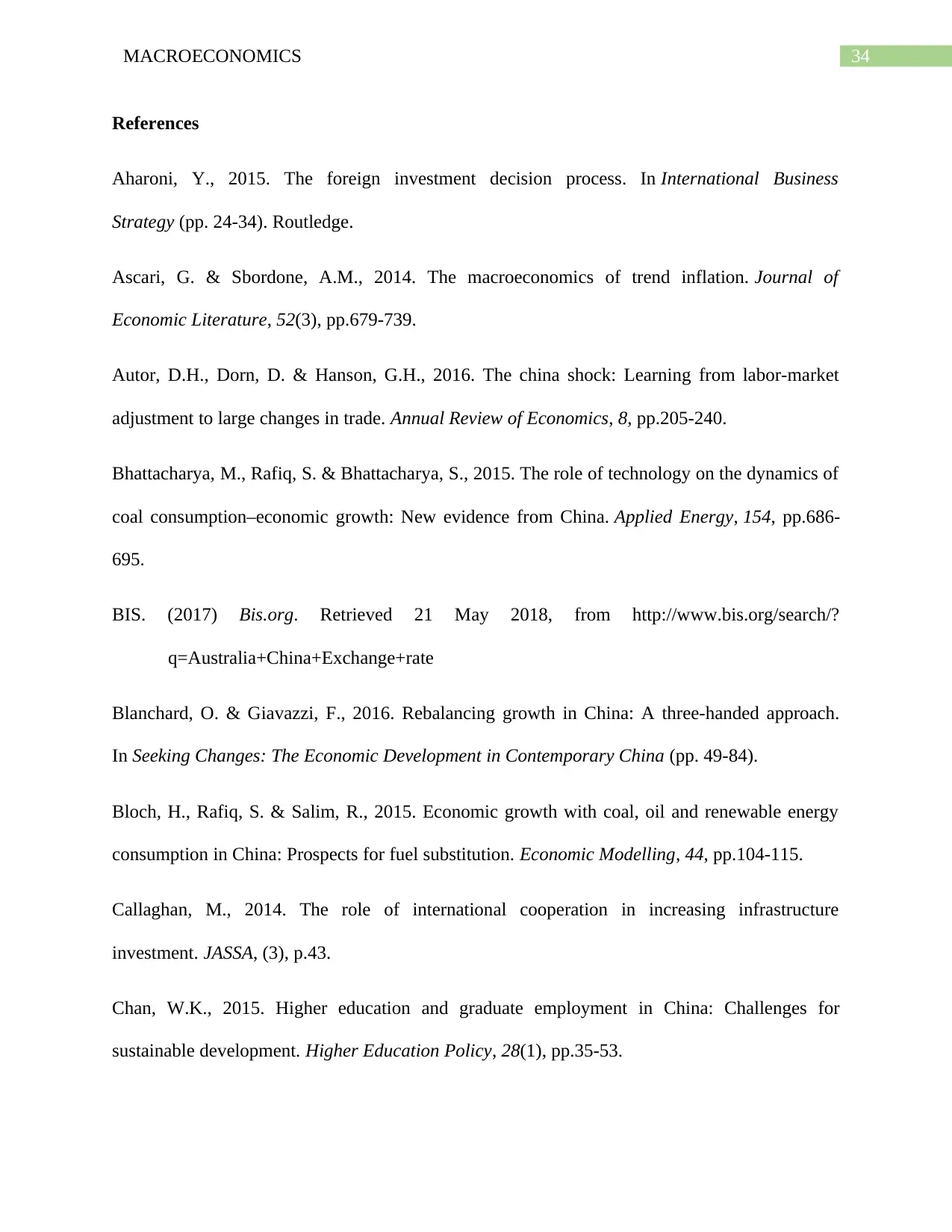
34MACROECONOMICS
References
Aharoni, Y., 2015. The foreign investment decision process. In International Business
Strategy (pp. 24-34). Routledge.
Ascari, G. & Sbordone, A.M., 2014. The macroeconomics of trend inflation. Journal of
Economic Literature, 52(3), pp.679-739.
Autor, D.H., Dorn, D. & Hanson, G.H., 2016. The china shock: Learning from labor-market
adjustment to large changes in trade. Annual Review of Economics, 8, pp.205-240.
Bhattacharya, M., Rafiq, S. & Bhattacharya, S., 2015. The role of technology on the dynamics of
coal consumption–economic growth: New evidence from China. Applied Energy, 154, pp.686-
695.
BIS. (2017) Bis.org. Retrieved 21 May 2018, from http://www.bis.org/search/?
q=Australia+China+Exchange+rate
Blanchard, O. & Giavazzi, F., 2016. Rebalancing growth in China: A three-handed approach.
In Seeking Changes: The Economic Development in Contemporary China (pp. 49-84).
Bloch, H., Rafiq, S. & Salim, R., 2015. Economic growth with coal, oil and renewable energy
consumption in China: Prospects for fuel substitution. Economic Modelling, 44, pp.104-115.
Callaghan, M., 2014. The role of international cooperation in increasing infrastructure
investment. JASSA, (3), p.43.
Chan, W.K., 2015. Higher education and graduate employment in China: Challenges for
sustainable development. Higher Education Policy, 28(1), pp.35-53.
References
Aharoni, Y., 2015. The foreign investment decision process. In International Business
Strategy (pp. 24-34). Routledge.
Ascari, G. & Sbordone, A.M., 2014. The macroeconomics of trend inflation. Journal of
Economic Literature, 52(3), pp.679-739.
Autor, D.H., Dorn, D. & Hanson, G.H., 2016. The china shock: Learning from labor-market
adjustment to large changes in trade. Annual Review of Economics, 8, pp.205-240.
Bhattacharya, M., Rafiq, S. & Bhattacharya, S., 2015. The role of technology on the dynamics of
coal consumption–economic growth: New evidence from China. Applied Energy, 154, pp.686-
695.
BIS. (2017) Bis.org. Retrieved 21 May 2018, from http://www.bis.org/search/?
q=Australia+China+Exchange+rate
Blanchard, O. & Giavazzi, F., 2016. Rebalancing growth in China: A three-handed approach.
In Seeking Changes: The Economic Development in Contemporary China (pp. 49-84).
Bloch, H., Rafiq, S. & Salim, R., 2015. Economic growth with coal, oil and renewable energy
consumption in China: Prospects for fuel substitution. Economic Modelling, 44, pp.104-115.
Callaghan, M., 2014. The role of international cooperation in increasing infrastructure
investment. JASSA, (3), p.43.
Chan, W.K., 2015. Higher education and graduate employment in China: Challenges for
sustainable development. Higher Education Policy, 28(1), pp.35-53.
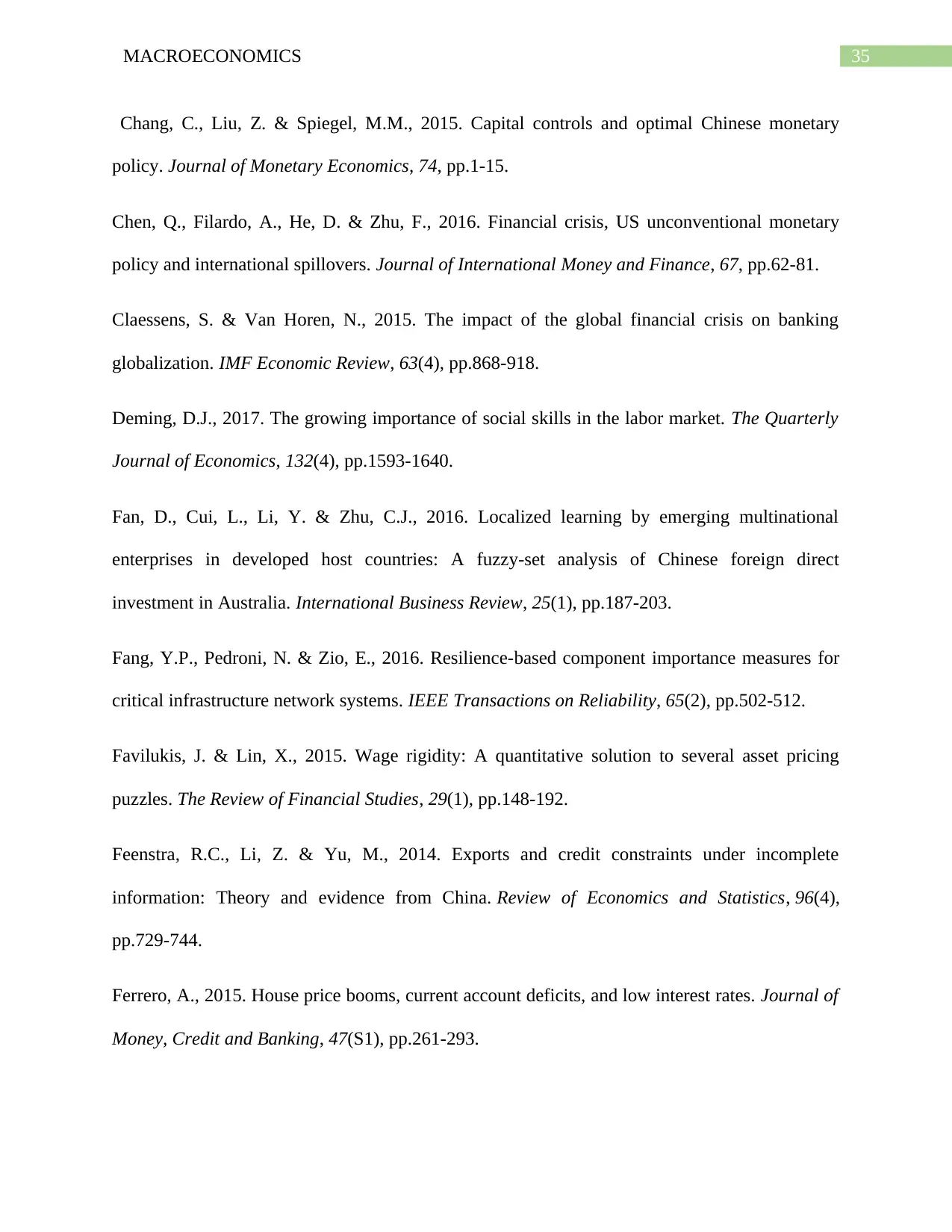
35MACROECONOMICS
Chang, C., Liu, Z. & Spiegel, M.M., 2015. Capital controls and optimal Chinese monetary
policy. Journal of Monetary Economics, 74, pp.1-15.
Chen, Q., Filardo, A., He, D. & Zhu, F., 2016. Financial crisis, US unconventional monetary
policy and international spillovers. Journal of International Money and Finance, 67, pp.62-81.
Claessens, S. & Van Horen, N., 2015. The impact of the global financial crisis on banking
globalization. IMF Economic Review, 63(4), pp.868-918.
Deming, D.J., 2017. The growing importance of social skills in the labor market. The Quarterly
Journal of Economics, 132(4), pp.1593-1640.
Fan, D., Cui, L., Li, Y. & Zhu, C.J., 2016. Localized learning by emerging multinational
enterprises in developed host countries: A fuzzy-set analysis of Chinese foreign direct
investment in Australia. International Business Review, 25(1), pp.187-203.
Fang, Y.P., Pedroni, N. & Zio, E., 2016. Resilience-based component importance measures for
critical infrastructure network systems. IEEE Transactions on Reliability, 65(2), pp.502-512.
Favilukis, J. & Lin, X., 2015. Wage rigidity: A quantitative solution to several asset pricing
puzzles. The Review of Financial Studies, 29(1), pp.148-192.
Feenstra, R.C., Li, Z. & Yu, M., 2014. Exports and credit constraints under incomplete
information: Theory and evidence from China. Review of Economics and Statistics, 96(4),
pp.729-744.
Ferrero, A., 2015. House price booms, current account deficits, and low interest rates. Journal of
Money, Credit and Banking, 47(S1), pp.261-293.
Chang, C., Liu, Z. & Spiegel, M.M., 2015. Capital controls and optimal Chinese monetary
policy. Journal of Monetary Economics, 74, pp.1-15.
Chen, Q., Filardo, A., He, D. & Zhu, F., 2016. Financial crisis, US unconventional monetary
policy and international spillovers. Journal of International Money and Finance, 67, pp.62-81.
Claessens, S. & Van Horen, N., 2015. The impact of the global financial crisis on banking
globalization. IMF Economic Review, 63(4), pp.868-918.
Deming, D.J., 2017. The growing importance of social skills in the labor market. The Quarterly
Journal of Economics, 132(4), pp.1593-1640.
Fan, D., Cui, L., Li, Y. & Zhu, C.J., 2016. Localized learning by emerging multinational
enterprises in developed host countries: A fuzzy-set analysis of Chinese foreign direct
investment in Australia. International Business Review, 25(1), pp.187-203.
Fang, Y.P., Pedroni, N. & Zio, E., 2016. Resilience-based component importance measures for
critical infrastructure network systems. IEEE Transactions on Reliability, 65(2), pp.502-512.
Favilukis, J. & Lin, X., 2015. Wage rigidity: A quantitative solution to several asset pricing
puzzles. The Review of Financial Studies, 29(1), pp.148-192.
Feenstra, R.C., Li, Z. & Yu, M., 2014. Exports and credit constraints under incomplete
information: Theory and evidence from China. Review of Economics and Statistics, 96(4),
pp.729-744.
Ferrero, A., 2015. House price booms, current account deficits, and low interest rates. Journal of
Money, Credit and Banking, 47(S1), pp.261-293.
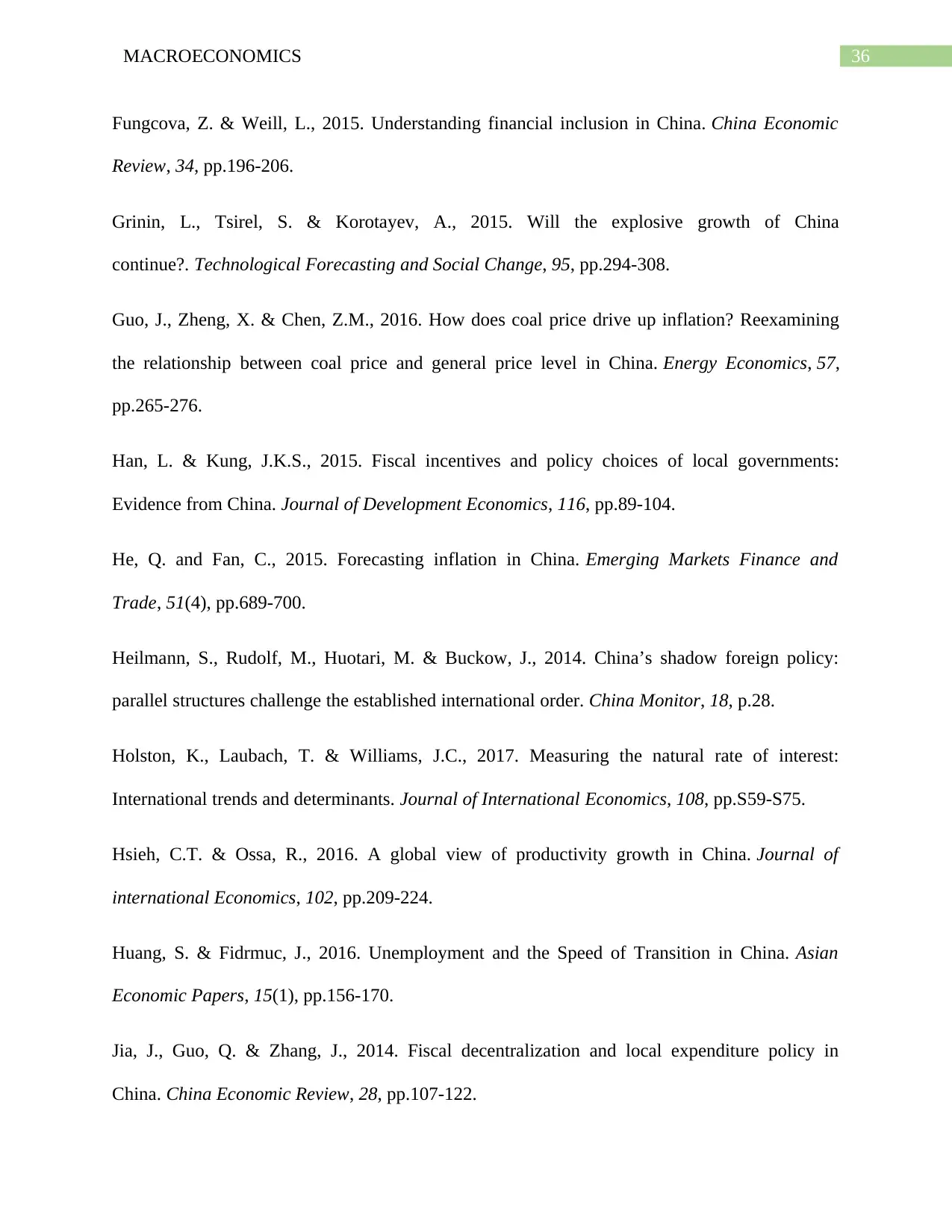
36MACROECONOMICS
Fungcova, Z. & Weill, L., 2015. Understanding financial inclusion in China. China Economic
Review, 34, pp.196-206.
Grinin, L., Tsirel, S. & Korotayev, A., 2015. Will the explosive growth of China
continue?. Technological Forecasting and Social Change, 95, pp.294-308.
Guo, J., Zheng, X. & Chen, Z.M., 2016. How does coal price drive up inflation? Reexamining
the relationship between coal price and general price level in China. Energy Economics, 57,
pp.265-276.
Han, L. & Kung, J.K.S., 2015. Fiscal incentives and policy choices of local governments:
Evidence from China. Journal of Development Economics, 116, pp.89-104.
He, Q. and Fan, C., 2015. Forecasting inflation in China. Emerging Markets Finance and
Trade, 51(4), pp.689-700.
Heilmann, S., Rudolf, M., Huotari, M. & Buckow, J., 2014. China’s shadow foreign policy:
parallel structures challenge the established international order. China Monitor, 18, p.28.
Holston, K., Laubach, T. & Williams, J.C., 2017. Measuring the natural rate of interest:
International trends and determinants. Journal of International Economics, 108, pp.S59-S75.
Hsieh, C.T. & Ossa, R., 2016. A global view of productivity growth in China. Journal of
international Economics, 102, pp.209-224.
Huang, S. & Fidrmuc, J., 2016. Unemployment and the Speed of Transition in China. Asian
Economic Papers, 15(1), pp.156-170.
Jia, J., Guo, Q. & Zhang, J., 2014. Fiscal decentralization and local expenditure policy in
China. China Economic Review, 28, pp.107-122.
Fungcova, Z. & Weill, L., 2015. Understanding financial inclusion in China. China Economic
Review, 34, pp.196-206.
Grinin, L., Tsirel, S. & Korotayev, A., 2015. Will the explosive growth of China
continue?. Technological Forecasting and Social Change, 95, pp.294-308.
Guo, J., Zheng, X. & Chen, Z.M., 2016. How does coal price drive up inflation? Reexamining
the relationship between coal price and general price level in China. Energy Economics, 57,
pp.265-276.
Han, L. & Kung, J.K.S., 2015. Fiscal incentives and policy choices of local governments:
Evidence from China. Journal of Development Economics, 116, pp.89-104.
He, Q. and Fan, C., 2015. Forecasting inflation in China. Emerging Markets Finance and
Trade, 51(4), pp.689-700.
Heilmann, S., Rudolf, M., Huotari, M. & Buckow, J., 2014. China’s shadow foreign policy:
parallel structures challenge the established international order. China Monitor, 18, p.28.
Holston, K., Laubach, T. & Williams, J.C., 2017. Measuring the natural rate of interest:
International trends and determinants. Journal of International Economics, 108, pp.S59-S75.
Hsieh, C.T. & Ossa, R., 2016. A global view of productivity growth in China. Journal of
international Economics, 102, pp.209-224.
Huang, S. & Fidrmuc, J., 2016. Unemployment and the Speed of Transition in China. Asian
Economic Papers, 15(1), pp.156-170.
Jia, J., Guo, Q. & Zhang, J., 2014. Fiscal decentralization and local expenditure policy in
China. China Economic Review, 28, pp.107-122.
Paraphrase This Document
Need a fresh take? Get an instant paraphrase of this document with our AI Paraphraser
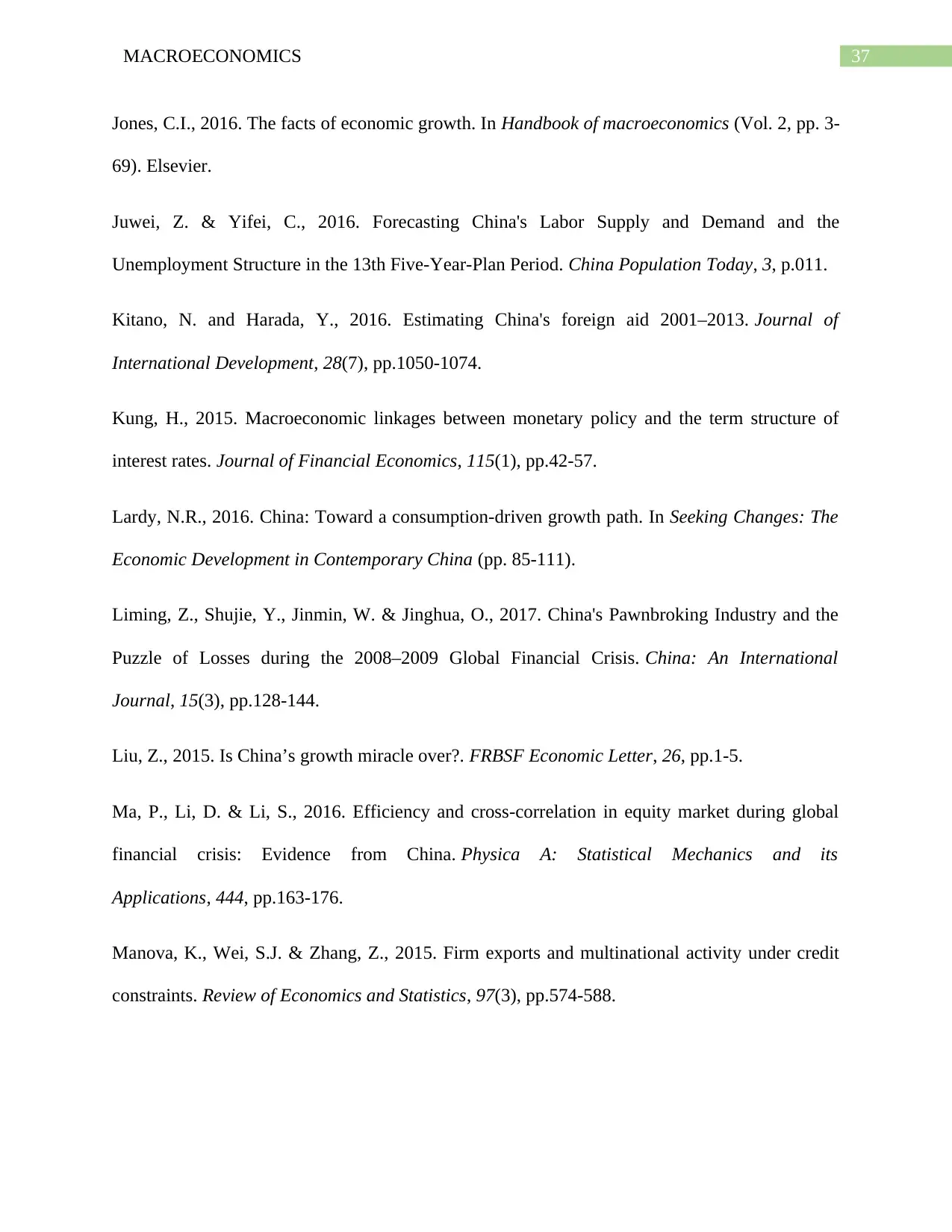
37MACROECONOMICS
Jones, C.I., 2016. The facts of economic growth. In Handbook of macroeconomics (Vol. 2, pp. 3-
69). Elsevier.
Juwei, Z. & Yifei, C., 2016. Forecasting China's Labor Supply and Demand and the
Unemployment Structure in the 13th Five-Year-Plan Period. China Population Today, 3, p.011.
Kitano, N. and Harada, Y., 2016. Estimating China's foreign aid 2001–2013. Journal of
International Development, 28(7), pp.1050-1074.
Kung, H., 2015. Macroeconomic linkages between monetary policy and the term structure of
interest rates. Journal of Financial Economics, 115(1), pp.42-57.
Lardy, N.R., 2016. China: Toward a consumption-driven growth path. In Seeking Changes: The
Economic Development in Contemporary China (pp. 85-111).
Liming, Z., Shujie, Y., Jinmin, W. & Jinghua, O., 2017. China's Pawnbroking Industry and the
Puzzle of Losses during the 2008–2009 Global Financial Crisis. China: An International
Journal, 15(3), pp.128-144.
Liu, Z., 2015. Is China’s growth miracle over?. FRBSF Economic Letter, 26, pp.1-5.
Ma, P., Li, D. & Li, S., 2016. Efficiency and cross-correlation in equity market during global
financial crisis: Evidence from China. Physica A: Statistical Mechanics and its
Applications, 444, pp.163-176.
Manova, K., Wei, S.J. & Zhang, Z., 2015. Firm exports and multinational activity under credit
constraints. Review of Economics and Statistics, 97(3), pp.574-588.
Jones, C.I., 2016. The facts of economic growth. In Handbook of macroeconomics (Vol. 2, pp. 3-
69). Elsevier.
Juwei, Z. & Yifei, C., 2016. Forecasting China's Labor Supply and Demand and the
Unemployment Structure in the 13th Five-Year-Plan Period. China Population Today, 3, p.011.
Kitano, N. and Harada, Y., 2016. Estimating China's foreign aid 2001–2013. Journal of
International Development, 28(7), pp.1050-1074.
Kung, H., 2015. Macroeconomic linkages between monetary policy and the term structure of
interest rates. Journal of Financial Economics, 115(1), pp.42-57.
Lardy, N.R., 2016. China: Toward a consumption-driven growth path. In Seeking Changes: The
Economic Development in Contemporary China (pp. 85-111).
Liming, Z., Shujie, Y., Jinmin, W. & Jinghua, O., 2017. China's Pawnbroking Industry and the
Puzzle of Losses during the 2008–2009 Global Financial Crisis. China: An International
Journal, 15(3), pp.128-144.
Liu, Z., 2015. Is China’s growth miracle over?. FRBSF Economic Letter, 26, pp.1-5.
Ma, P., Li, D. & Li, S., 2016. Efficiency and cross-correlation in equity market during global
financial crisis: Evidence from China. Physica A: Statistical Mechanics and its
Applications, 444, pp.163-176.
Manova, K., Wei, S.J. & Zhang, Z., 2015. Firm exports and multinational activity under credit
constraints. Review of Economics and Statistics, 97(3), pp.574-588.
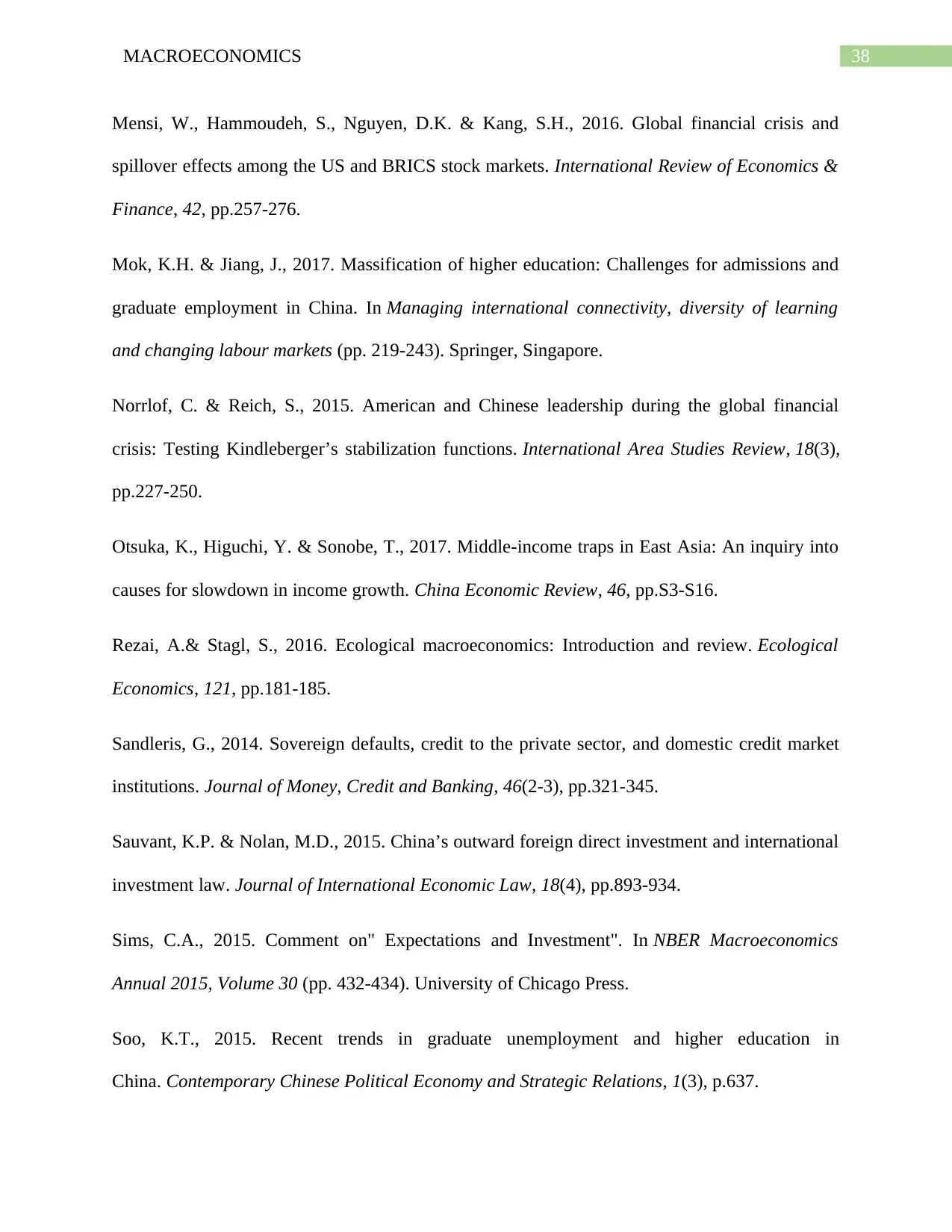
38MACROECONOMICS
Mensi, W., Hammoudeh, S., Nguyen, D.K. & Kang, S.H., 2016. Global financial crisis and
spillover effects among the US and BRICS stock markets. International Review of Economics &
Finance, 42, pp.257-276.
Mok, K.H. & Jiang, J., 2017. Massification of higher education: Challenges for admissions and
graduate employment in China. In Managing international connectivity, diversity of learning
and changing labour markets (pp. 219-243). Springer, Singapore.
Norrlof, C. & Reich, S., 2015. American and Chinese leadership during the global financial
crisis: Testing Kindleberger’s stabilization functions. International Area Studies Review, 18(3),
pp.227-250.
Otsuka, K., Higuchi, Y. & Sonobe, T., 2017. Middle-income traps in East Asia: An inquiry into
causes for slowdown in income growth. China Economic Review, 46, pp.S3-S16.
Rezai, A.& Stagl, S., 2016. Ecological macroeconomics: Introduction and review. Ecological
Economics, 121, pp.181-185.
Sandleris, G., 2014. Sovereign defaults, credit to the private sector, and domestic credit market
institutions. Journal of Money, Credit and Banking, 46(2-3), pp.321-345.
Sauvant, K.P. & Nolan, M.D., 2015. China’s outward foreign direct investment and international
investment law. Journal of International Economic Law, 18(4), pp.893-934.
Sims, C.A., 2015. Comment on" Expectations and Investment". In NBER Macroeconomics
Annual 2015, Volume 30 (pp. 432-434). University of Chicago Press.
Soo, K.T., 2015. Recent trends in graduate unemployment and higher education in
China. Contemporary Chinese Political Economy and Strategic Relations, 1(3), p.637.
Mensi, W., Hammoudeh, S., Nguyen, D.K. & Kang, S.H., 2016. Global financial crisis and
spillover effects among the US and BRICS stock markets. International Review of Economics &
Finance, 42, pp.257-276.
Mok, K.H. & Jiang, J., 2017. Massification of higher education: Challenges for admissions and
graduate employment in China. In Managing international connectivity, diversity of learning
and changing labour markets (pp. 219-243). Springer, Singapore.
Norrlof, C. & Reich, S., 2015. American and Chinese leadership during the global financial
crisis: Testing Kindleberger’s stabilization functions. International Area Studies Review, 18(3),
pp.227-250.
Otsuka, K., Higuchi, Y. & Sonobe, T., 2017. Middle-income traps in East Asia: An inquiry into
causes for slowdown in income growth. China Economic Review, 46, pp.S3-S16.
Rezai, A.& Stagl, S., 2016. Ecological macroeconomics: Introduction and review. Ecological
Economics, 121, pp.181-185.
Sandleris, G., 2014. Sovereign defaults, credit to the private sector, and domestic credit market
institutions. Journal of Money, Credit and Banking, 46(2-3), pp.321-345.
Sauvant, K.P. & Nolan, M.D., 2015. China’s outward foreign direct investment and international
investment law. Journal of International Economic Law, 18(4), pp.893-934.
Sims, C.A., 2015. Comment on" Expectations and Investment". In NBER Macroeconomics
Annual 2015, Volume 30 (pp. 432-434). University of Chicago Press.
Soo, K.T., 2015. Recent trends in graduate unemployment and higher education in
China. Contemporary Chinese Political Economy and Strategic Relations, 1(3), p.637.
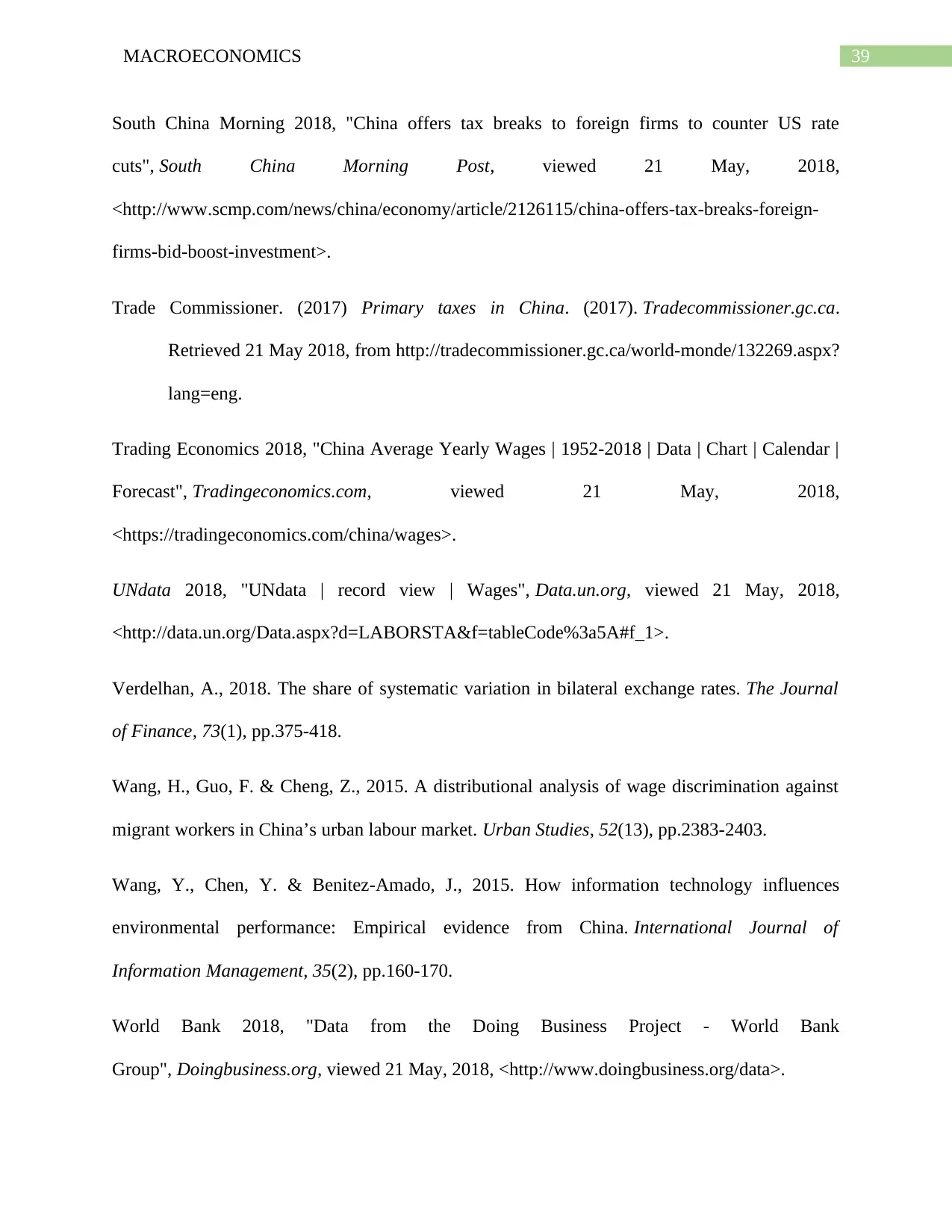
39MACROECONOMICS
South China Morning 2018, "China offers tax breaks to foreign firms to counter US rate
cuts", South China Morning Post, viewed 21 May, 2018,
<http://www.scmp.com/news/china/economy/article/2126115/china-offers-tax-breaks-foreign-
firms-bid-boost-investment>.
Trade Commissioner. (2017) Primary taxes in China. (2017). Tradecommissioner.gc.ca.
Retrieved 21 May 2018, from http://tradecommissioner.gc.ca/world-monde/132269.aspx?
lang=eng.
Trading Economics 2018, "China Average Yearly Wages | 1952-2018 | Data | Chart | Calendar |
Forecast", Tradingeconomics.com, viewed 21 May, 2018,
<https://tradingeconomics.com/china/wages>.
UNdata 2018, "UNdata | record view | Wages", Data.un.org, viewed 21 May, 2018,
<http://data.un.org/Data.aspx?d=LABORSTA&f=tableCode%3a5A#f_1>.
Verdelhan, A., 2018. The share of systematic variation in bilateral exchange rates. The Journal
of Finance, 73(1), pp.375-418.
Wang, H., Guo, F. & Cheng, Z., 2015. A distributional analysis of wage discrimination against
migrant workers in China’s urban labour market. Urban Studies, 52(13), pp.2383-2403.
Wang, Y., Chen, Y. & Benitez-Amado, J., 2015. How information technology influences
environmental performance: Empirical evidence from China. International Journal of
Information Management, 35(2), pp.160-170.
World Bank 2018, "Data from the Doing Business Project - World Bank
Group", Doingbusiness.org, viewed 21 May, 2018, <http://www.doingbusiness.org/data>.
South China Morning 2018, "China offers tax breaks to foreign firms to counter US rate
cuts", South China Morning Post, viewed 21 May, 2018,
<http://www.scmp.com/news/china/economy/article/2126115/china-offers-tax-breaks-foreign-
firms-bid-boost-investment>.
Trade Commissioner. (2017) Primary taxes in China. (2017). Tradecommissioner.gc.ca.
Retrieved 21 May 2018, from http://tradecommissioner.gc.ca/world-monde/132269.aspx?
lang=eng.
Trading Economics 2018, "China Average Yearly Wages | 1952-2018 | Data | Chart | Calendar |
Forecast", Tradingeconomics.com, viewed 21 May, 2018,
<https://tradingeconomics.com/china/wages>.
UNdata 2018, "UNdata | record view | Wages", Data.un.org, viewed 21 May, 2018,
<http://data.un.org/Data.aspx?d=LABORSTA&f=tableCode%3a5A#f_1>.
Verdelhan, A., 2018. The share of systematic variation in bilateral exchange rates. The Journal
of Finance, 73(1), pp.375-418.
Wang, H., Guo, F. & Cheng, Z., 2015. A distributional analysis of wage discrimination against
migrant workers in China’s urban labour market. Urban Studies, 52(13), pp.2383-2403.
Wang, Y., Chen, Y. & Benitez-Amado, J., 2015. How information technology influences
environmental performance: Empirical evidence from China. International Journal of
Information Management, 35(2), pp.160-170.
World Bank 2018, "Data from the Doing Business Project - World Bank
Group", Doingbusiness.org, viewed 21 May, 2018, <http://www.doingbusiness.org/data>.
Secure Best Marks with AI Grader
Need help grading? Try our AI Grader for instant feedback on your assignments.
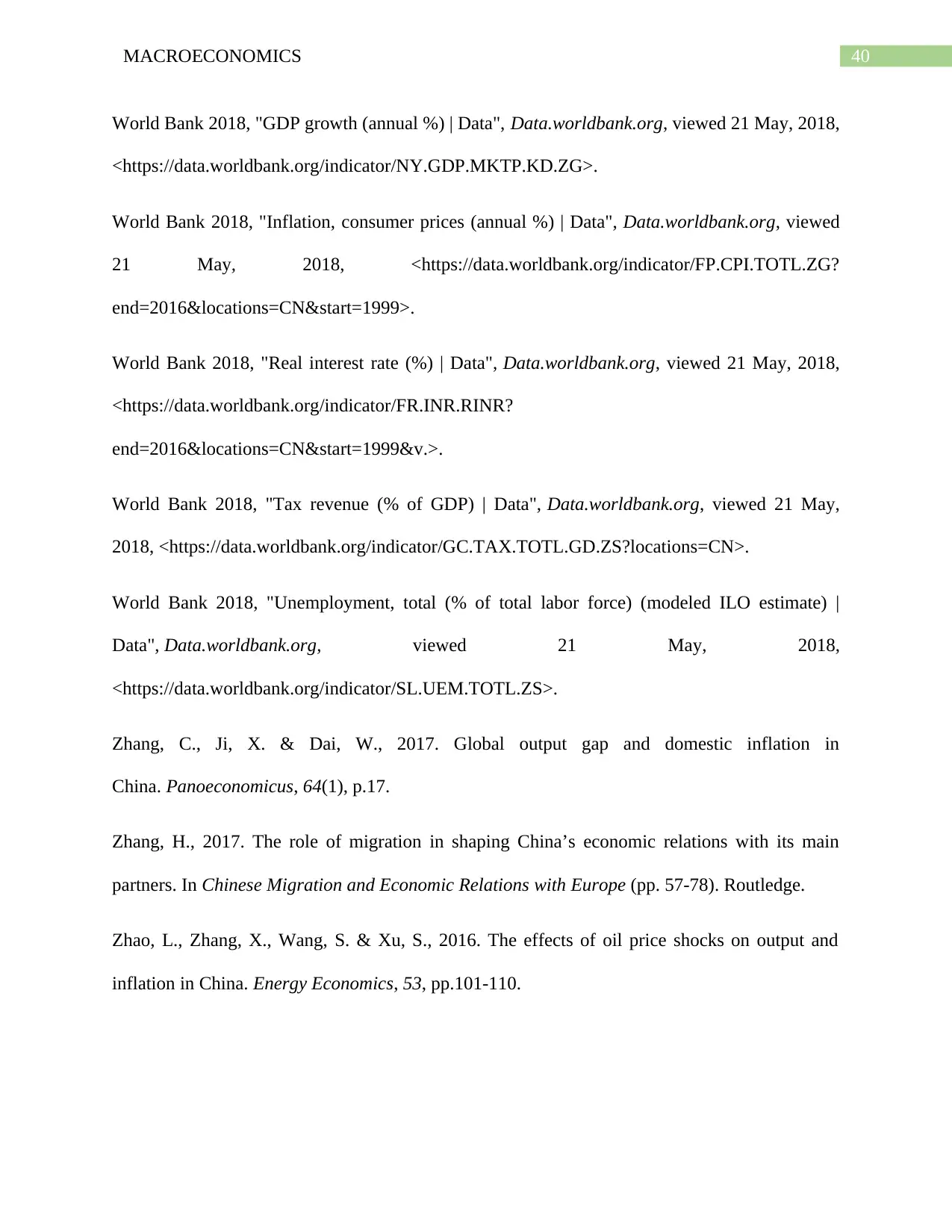
40MACROECONOMICS
World Bank 2018, "GDP growth (annual %) | Data", Data.worldbank.org, viewed 21 May, 2018,
<https://data.worldbank.org/indicator/NY.GDP.MKTP.KD.ZG>.
World Bank 2018, "Inflation, consumer prices (annual %) | Data", Data.worldbank.org, viewed
21 May, 2018, <https://data.worldbank.org/indicator/FP.CPI.TOTL.ZG?
end=2016&locations=CN&start=1999>.
World Bank 2018, "Real interest rate (%) | Data", Data.worldbank.org, viewed 21 May, 2018,
<https://data.worldbank.org/indicator/FR.INR.RINR?
end=2016&locations=CN&start=1999&v.>.
World Bank 2018, "Tax revenue (% of GDP) | Data", Data.worldbank.org, viewed 21 May,
2018, <https://data.worldbank.org/indicator/GC.TAX.TOTL.GD.ZS?locations=CN>.
World Bank 2018, "Unemployment, total (% of total labor force) (modeled ILO estimate) |
Data", Data.worldbank.org, viewed 21 May, 2018,
<https://data.worldbank.org/indicator/SL.UEM.TOTL.ZS>.
Zhang, C., Ji, X. & Dai, W., 2017. Global output gap and domestic inflation in
China. Panoeconomicus, 64(1), p.17.
Zhang, H., 2017. The role of migration in shaping China’s economic relations with its main
partners. In Chinese Migration and Economic Relations with Europe (pp. 57-78). Routledge.
Zhao, L., Zhang, X., Wang, S. & Xu, S., 2016. The effects of oil price shocks on output and
inflation in China. Energy Economics, 53, pp.101-110.
World Bank 2018, "GDP growth (annual %) | Data", Data.worldbank.org, viewed 21 May, 2018,
<https://data.worldbank.org/indicator/NY.GDP.MKTP.KD.ZG>.
World Bank 2018, "Inflation, consumer prices (annual %) | Data", Data.worldbank.org, viewed
21 May, 2018, <https://data.worldbank.org/indicator/FP.CPI.TOTL.ZG?
end=2016&locations=CN&start=1999>.
World Bank 2018, "Real interest rate (%) | Data", Data.worldbank.org, viewed 21 May, 2018,
<https://data.worldbank.org/indicator/FR.INR.RINR?
end=2016&locations=CN&start=1999&v.>.
World Bank 2018, "Tax revenue (% of GDP) | Data", Data.worldbank.org, viewed 21 May,
2018, <https://data.worldbank.org/indicator/GC.TAX.TOTL.GD.ZS?locations=CN>.
World Bank 2018, "Unemployment, total (% of total labor force) (modeled ILO estimate) |
Data", Data.worldbank.org, viewed 21 May, 2018,
<https://data.worldbank.org/indicator/SL.UEM.TOTL.ZS>.
Zhang, C., Ji, X. & Dai, W., 2017. Global output gap and domestic inflation in
China. Panoeconomicus, 64(1), p.17.
Zhang, H., 2017. The role of migration in shaping China’s economic relations with its main
partners. In Chinese Migration and Economic Relations with Europe (pp. 57-78). Routledge.
Zhao, L., Zhang, X., Wang, S. & Xu, S., 2016. The effects of oil price shocks on output and
inflation in China. Energy Economics, 53, pp.101-110.
1 out of 41
Related Documents
Your All-in-One AI-Powered Toolkit for Academic Success.
+13062052269
info@desklib.com
Available 24*7 on WhatsApp / Email
![[object Object]](/_next/static/media/star-bottom.7253800d.svg)
Unlock your academic potential
© 2024 | Zucol Services PVT LTD | All rights reserved.





